About the operator
Its address is in ATHINAIDOS 63 Voula in Greece. They are registered under the name: CV Yachts Vafiadou Chrysoula. They propose sailboat charters in Greece : Yacht charter Greece . Athens , Alimos Marina, Skiathos , Skiathos are the marinas where you can charter their boats. In their offer you can find sailing yachts like: Sun Odyssey 45.2, Bavaria 47, Lagoon 400 S2. CV Yachts offers nonrefundable deposit for his charterers. You can come onboard from 17:00 PM on saturdays. Charterers are obliged to leave the boat until 9:00 in the morning. You should come back to the home port on Friday afternoon till 16:00 in order to make a check-out of the vessel. Advanced payment is 50% of total price, second money order is to be paid 1 month before check-in. If you want to get the First Minute discounts, you should book a boat before 31.01 each year. Additional equipment and services are charged with cash or credit card. In this company both cash and credit cards are accepted for the deposit. Firm CV Yachts has gained the recognition of its charterers.
- Name CV Yachts
- Full name Iason Themistoklis Andreas Niagasas
- Address ATHINAIDOS 63, Greece
- Check-in 17:00
- Check-out 9:00

Bases where You can charter CV Yachts yachts
- Alimos Marina, Greece
- Lavrion, Greece
Yacht charter offers of CV Yachts (available online)
We've found the best deals for 9 yachts available
Selected offers from CV Yachts starting on 2024-08-31 for 1 week

2555€ 4250€ 39.88%
- Gps plotter
- Bow thruster
- Air conditioning (requires shore power 220v or generator on board)
- Possibility of deposit insurance
- Year of Build: 2011
- Berths: 10 (8+1+1)
- Cabins: 5 (4+1)

5920€ 9900€ 40.2%
- Year of Build: 2020
- Berths: 12 (8+2+2)
- Cabins: 6 (4+2)
- Furling mainsail
- Plotter gps in cockpit
- Air conditioning

impact of technology on sports essay
How technology is transforming the world of sports.
- by SportsGeeks
- December 4, 2023 December 4, 2023
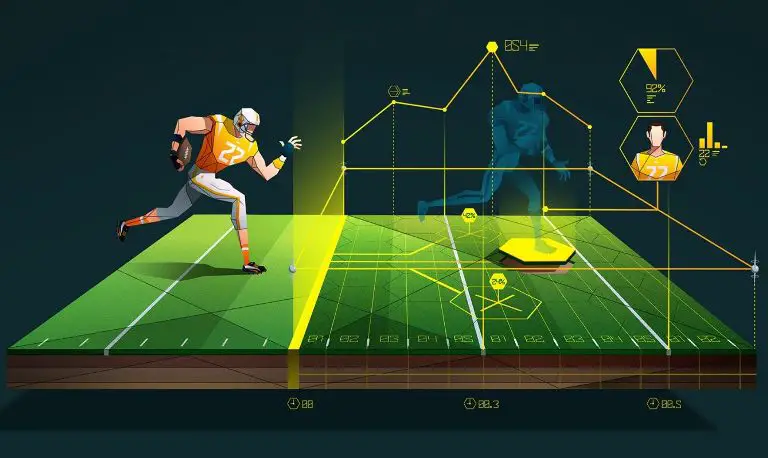
Technology has become an integral part of modern sports in the last few decades. It has influenced the equipment that athletes use and wear, the strategies that teams employ, and the infrastructure that supports sports events. Here we will explore the major ways technology is transforming sports. We’ll discuss how technology has advanced the equipment used by athletes, such as wearable devices, smart clothing, and biometric sensors. We will also discuss how it has enhanced the analytics that helps teams optimize their performance, such as video analysis, artificial intelligence, and big data, and how it has increased fan engagement with sports, such as virtual reality, augmented reality, and social media. How technology has revolutionized the broadcasting of sports, such as streaming services, interactive features, and personalized content, and how it has affected the infrastructure of sports, such as smart stadiums, digital ticketing, and sustainability.
1. Enhancing Athletic Performance
One of the most significant impacts of technology on sports is the enhancement of athletic performance. Athletes now have access to wearable technology, including smartwatches, fitness trackers, and heart rate monitors, which enable them to monitor and track their physical condition, performance, and recovery. Additionally, advanced training equipment and tools, such as virtual reality simulators, resistance bands, and motion sensors, contribute to improving athletes’ skills and techniques. Data analytics plays a crucial role in analyzing athletes’ strengths and weaknesses, optimizing their strategies and tactics, and preventing injuries.
2. Transforming the Fan Experience
Technology has completely transformed the fan experience in the world of sports. Stadiums and arenas now offer interactive screens, digital ticketing, Wi-Fi access, and mobile apps, which significantly enhance the fan experience. Furthermore, technological advancements like virtual reality (VR) and augmented reality (AR) have revolutionized the way fans watch sports, providing them with immersive and realistic experiences. Moreover, social media platforms like Twitter, Facebook, and Instagram have facilitated fan engagement and interaction, allowing fans to share their opinions, emotions, and content with other fans and athletes.
3. Improving Officiating and Refereeing
Technology has played a vital role in improving officiating and refereeing in sports. Video replay technology enables officials and referees to make more accurate and fair decisions by reviewing controversial or disputed calls. In soccer, goal-line technology has been implemented to determine whether a ball has crossed the goal line or not. Looking ahead, artificial intelligence (AI) may potentially assist or even replace human officials and referees in decision-making processes.
4. Revolutionizing Broadcasting and Media
The advent of technology has brought about a revolution in the broadcasting and media of sports. Streaming services such as Netflix, Amazon Prime Video, and Disney+ have disrupted traditional cable TV, providing viewers with more choices and flexibility. High-tech cameras and graphics, such as 360-degree cameras, drones, and 3D graphics, have elevated the quality and variety of sports broadcasting. Additionally, technology has played a significant role in the growth of esports (electronic sports), which attract millions of viewers and generate billions of dollars in revenue.
5. Equipment and Gear
Athletic equipment and gear has seen some of the most dramatic technological enhancements, as materials scientists and engineers work to leverage the latest innovations into products that push human physical limits. Advanced fabrics that wick moisture and regulate temperature are now standard apparel. Carbon fiber and lightweight alloys replace heavier materials in gear like bats, clubs, and protective equipment. 3D printing is being utilized to create precisely engineered shoes, helmets and guards tailored to an individual athlete’s biometrics. Wearable tech devices embedded into uniforms and accessories monitor vital stats in real-time, offering deep insights into training regimens and on-field performance. Brands are even developing “smart” gear that can enhance certain physical attributes through things like exoskeleton-assisted movements. The impact of these tech-driven equipment upgrades is nothing short of remarkable. Athletes are breaking records in every sport while experiencing less fatigue and higher comfort levels. Injuries are decreasing as protective gear evolves. And equipment is being redesigned on a model of continuous improvement through data collection.
6. Analytics and Data
On the analytics and data front, entire departments within sports organizations are now dedicated to capturing and analyzing every measurable aspect of play. Advanced stats powered by computer vision, AI and sensor technologies provide deeper insights than ever before possible. Next-gen tracking systems like NFL’s Next Gen Stats employ precise GPS technology to map every inch of on-field player movement. Biometric wearables uncover physiological metrics in real-time, offering an inside look at factors like heart rate, acceleration and more. Video and image analysis powered by machine learning recognizes and classifies plays, player interactions and strategic trends. This explosion of sports data fuels fantasy sports, esports and increasingly complex predictive simulations. It also transforms coaching through data-driven scouting, play design and “moneyball”-style talent evaluation. Teams now have an unprecedented ability to optimize everything from individual athletic performance to high-level team strategies. Fans also get uniquely engaging stats-based experiences and betting opportunities.
7. Fan Engagement
Technology has completely upended how fans consume and interact with sports. Social platforms allow instant highlights, commentary and community. Mobile apps put live scores, stats and streaming at fans’ fingertips wherever they may be. Augmented and virtual reality bring new dimensions to the live event experience. Esports have emerged as a billion-dollar industry, attracting massive audiences with simulated and real-time interactive sports. NFTs are changing memorabilia and digital ownership models. And the metaverse promises to take fan engagement to another level through shared virtual worlds centered around teams and leagues. Live streaming of games via dedicated sports streaming services now competes with traditional cable and satellite providers. Simulated sports games capture the attention of casual fans. And teams leverage location-based tech for things like virtual ticket scavenger hunts to deepen local community ties. The ways technology enriches sports fandom are endless and ever-evolving.
8. Broadcasting and Media
Just as technology has upended how fans watch sports, it’s transforming the entire sports media landscape. Streaming has disrupted traditional linear viewing, as services like ESPN+, DAZN, Peacock and more vie for exclusive streaming rights. On-demand and on-the-go viewing is king, with every league offering mobile viewing options for highlights, full game replays and out-of-market access. Social platforms are becoming content distributors in their own right through highlights and live look-ins. Podcasting extends discussion and fandom beyond scheduled programming. Advanced cameras, drones and VR provide novel angles and immersive perspectives that enhance the viewing scheduled programming. Advanced cameras, drones and VR provide novel angles and immersive perspectives that enhance the viewing experience. Virtual production techniques bring virtual fans, graphics and augmented reality into empty or full venues. And behind-the-scenes content gives audiences unprecedented access into the lives of players and franchises. The media landscape will continue fragmenting as tech-savvy younger generations drive new forms of content discovery and consumption. Sports broadcasting innovates at breakneck speed to keep pace with these evolving viewer habits and engagement preferences.
9. Infrastructure and Facilities
From the grassroots to the pros, technology is modernizing sports facilities and operations. “Smart stadiums” integrate WiFi, mobile apps, cashless concessions, digital signage and more fan conveniences powered by IoT networks. Indoor GPS tracking improves practice efficiency and injury prevention. Virtual, augmented and mixed reality are being tested for applications ranging from facility design to injury rehabilitation to playbook visualization. Esports arenas bring production value to competitive gaming. Training centers and academies deploy biometric monitoring, VR simulations and data-driven development programs. Behind closed doors, teams leverage cloud-based services, predictive maintenance, computer vision and more to optimize everything from equipment management to travel logistics. Cash flows more seamlessly through contactless payments. And new green building standards are lowering environmental footprints throughout sports infrastructure.
Addressing Ethical Considerations
The use of technology in sports has also raised ethical concerns, particularly regarding the use of performance-enhancing technology. Performance-enhancing technology encompasses any technology that artificially improves an athlete’s physical or mental abilities. Examples include gene doping (altering an athlete’s genes), blood doping (increasing an athlete’s red blood cell count), brain stimulation (enhancing cognitive functions), and prosthetic limbs (replacing missing or injured limbs). These advancements in technology raise questions about the fairness, integrity, and authenticity of sports.
Technology has a profound and prevalent impact on sports, affecting multiple domains and aspects. It has revolutionized sports through continuous innovation, enhancing athletic performance, transforming the fan experience, improving officiating and refereeing, changing the broadcasting and media, and raising ethical considerations. Technology will continue to shape the future of sports, bringing both positive advancements and challenges. One thing is clear – the relationship between tech and sports has never been more intertwined, and its impact has never been more profound.
Leave a Reply Cancel reply
Your email address will not be published. Required fields are marked *
Save my name, email, and website in this browser for the next time I comment.
Impact of Technologies on Sports and Fitness: 10 Examples
Digital Strategy

May 24, 2023
technologies in sport
Modern technologies such as IoT, AI and VR have a profound impact on sports and fitness. Following a short slowdown in 2020 due to the pandemic, these technologies played a major role in revitalizing the industry. Examples of using technologies in sport include telefitness solutions for home workouts, mobile apps for weight management, personal wearables, and performance tracking systems.
In this post, we will review these and other key applications in this field, go through the advancements in sports technology, and mention a few amazing digital products that thrive in this industry. We will answer the following questions:
- How does technology affect sports?
- What technologies have the biggest impact on the industry?
- How do modern brands leverage AI, IoT and cloud computing in sport and fitness to have a leg on the competition?

Impact of digital technologies on sports and fitness companies performance
Digital technology revolutionized the way companies operate and adjust to the needs and expectations of modern customers. According to McKinsey , since the pandemic, consumers around the world have shifted priorities toward healthier lifestyles and are willing to pay more for services and products that promote wellness, including fitness, appearance, and health. To stay competitive and win in this market, companies reshape their strategies by using digital technologies in sports and fitness.
Digitalization has become a key focus for companies seeking growth and innovation. The leading players in the industry, from professional athletes and leagues to private fitness clubs, apparel and gear producers, and event organizers experiment and successfully leverage the benefits of technology in sports to gain competitive advantage. Among the top performers in 2022 that showed significant sales growth are the brands that invest heavily in innovation and tech.
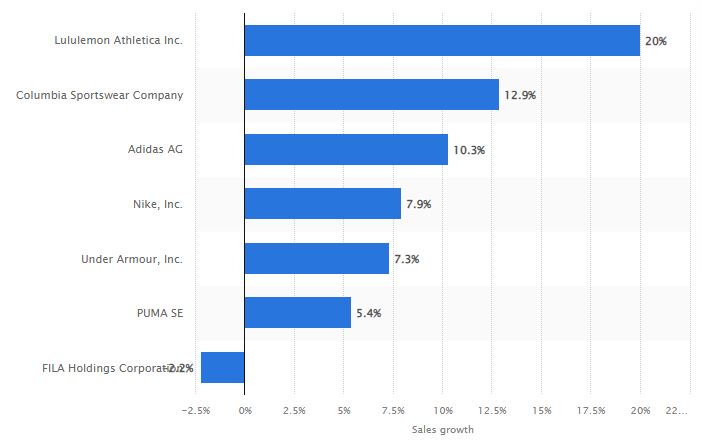
Top sales growth in 2022. Image credit: Statista.
Nike and Peloton are real-world examples that show how a company can boost sales and enhance brand image by embracing digital technologies. Nike has successfully integrated technology into its products, such as connected shoes and smart apparel, providing users with real-time performance data and personalized coaching. As you can see, except for a slight drop in 2020, Nike nearly doubled its worldwide revenue in the course of 10 years, showing steady growth from year to year.
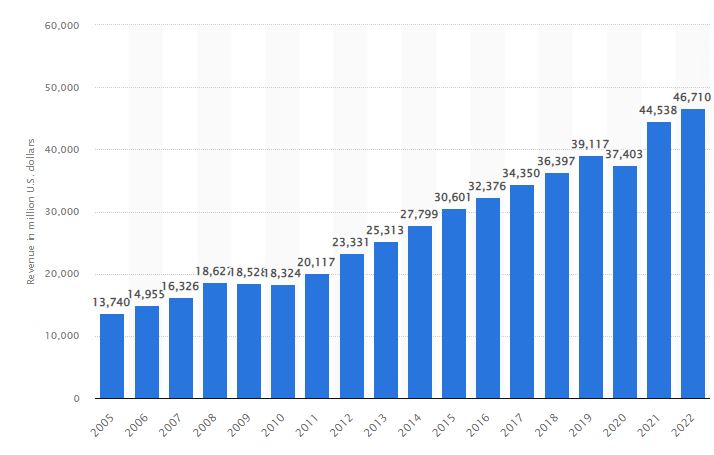
Nike worldwide revenue. Image credit: Statista.
Peloton, on the other hand, has leveraged the use of IoT and AI in fitness to create immersive at-home experiences, combining interactive workouts with social engagement. The company founded in 2012 hit the revenue goal of nearly 3.15 billion USD in 2021. It quickly became an icon, demonstrating the impact of technology on fitness industry.
So how is technology used in sports today and what should we expect from sports and fitness applications in the nearest future? Let’s find out!
10 examples of using technologies in sport and fitness
No doubt, the major trends in fast-growing tech such as IoT, artificial intelligence, and virtual reality have made a big impact on the industry of sport and fitness. Along with now common fitness trackers and mobile apps for different sports activities, we see novel technologies in sports being tested and adopted. Examples are abundant.
Here are several interesting applications of using information technology in fitness, professional sports, and wellness.
Telefitness technologies
The new reality of the home office has boosted the role of digital technology in sports and fitness. Particularly, telefitness and all sports technology advancements that make home workouts and remote coaching possible. This category also includes a wide range of solutions from popular video conferencing tools and mobile apps for instructors and students to futuristic fitness technologies like smart mirrors .
The best thing about these technologies is that they are likely to stay with us for a very long time. Telefitness services are particularly important for such groups of consumers as the elderly, people who recover from injuries and those who can’t access gyms or find it challenging to work out outside for other reasons. There are plenty of health and wellness applications in this area that have proven to be useful, especially in recent years.
Doña Rise and Doña Shine is a great example of a feature-rich telefitness app. This is a unique app combo for home training with fitness and yoga instructors and workout progress tracking on wearables and mobile. Just like an Uber for fitness and wellness, the apps allow instructors to sell their services on-demand online and help students find instructors and routines that best fit their interests and schedules.

Need help with your sports app?
We can transform your idea into a stunning award-worthy application that performs like an A-list athlete.
Wearables for sports and fitness
The time when wearables in sports and wellness have been associated only with Fitbit bands and basic pedometers has passed. Today, the variety of wearable products and the versatility of their functionality are astonishing.
There are smart glasses for cyclists that build and show routes in real-time and goggles for swimmers that collect important metrics on the go. Sensor-enabled shoes for football players and runners that track speed, force, motion, traction, and other parameters have already become common examples of the use of technology in sports. There are even full-body suits that enable performance and muscle coordination monitoring during training and help enhance the experience with different AR and VR effects. These wearables are suitable for professional athletes, hobbyists, as well as those who undergo rehabilitation after traumas.
However, one of the most prominent examples in this category is perhaps the ultimate sensor wearable, the winner of uncountable CES and Red Dot awards, Teslasuit . Not only can it expand the potential of an athlete’s training thanks to the haptic tech, immersive VR experience and unique telemetry analytics. It also works as a tool for post-injury rehabilitation.
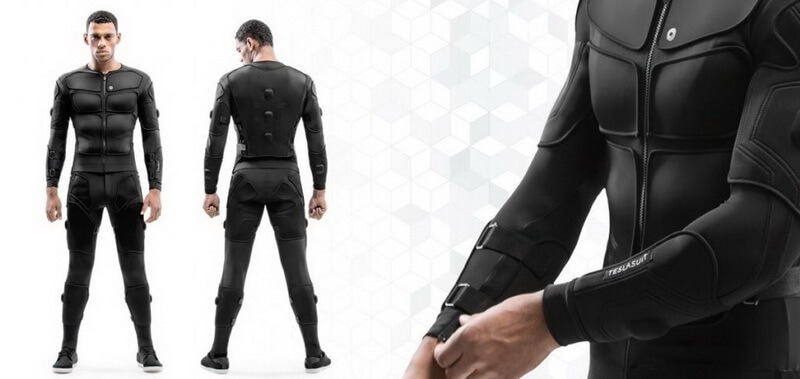
Read: Wearable application development for smart earbuds
Internet of Things and 5G
Emerging 5G technologies and the wide adoption of IoT in sports and fitness impact this industry in many different perspectives. Wearables are just a tiny part of connected technology, whereas the opportunities Internet of Things and ultrafast connectivity bring to this sector are truly fantastic.
Large-scale infrastructures such as connected stadiums, immersive audience experiences based on VR/AR solutions, athlete performance tracking and analytics are some of the most outstanding examples of digitalization in sports. It is believed that these technologies will become the major drivers of digital transformation in sports in the future.
Smart workout equipment
Equipment is often the main focus of sports startups. We can observe the growth of technology in sports equipment we use today. When common workout equipment such as treadmills or dumbbells are enhanced with sensors, they become a source of unique performance data and help monitor and correct workout routines in real time, enhance efficiency and even avoid injuries. Peloton treadmills and bikes are some of the most popular examples of fitness IoT applications and smart digital technology used in sports.

Connected gear
Smart suits, glasses, helmets, golf clubs, etc. have already become a part of essential gear kits of professional athletes. These tools provide professional sportsmen and sportswomen as well as their coaching teams with essential insights important for building efficient training programs and strategies.
Solos glasses is an excellent illustration of using connected digital technology in sports. This product offers an impressive array of features catering to professional cyclists and runners. These glasses provide monitoring capabilities, route navigation assistance, performance measurement tools, and advanced analytics.
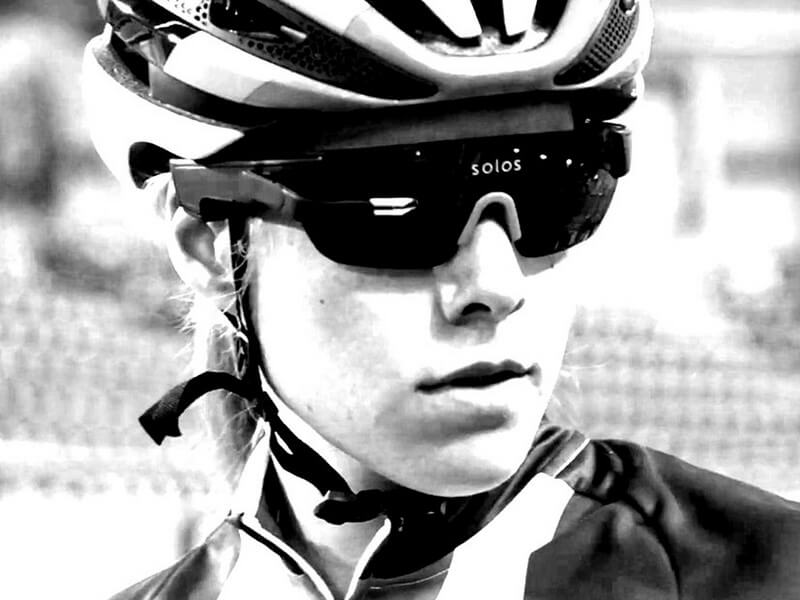
Enhanced sports facilities
The impact of technology in sports is seen not only in athletes’ training and performance but also in the conditions of the sports environment. Largescale facilities including stadiums, racing tracks, skating rinks are not easy and certainly not cheap to maintain. Enhanced with sensors, electricity management systems and lighting control, these facilities turn into smarter and more sustainable spaces that provide athletes and audiences with excellent conditions for sports events.
Athlete tracking systems
How has technology impacted sports? Possibly, the best way to answer this question is to compare the performance of the athletes today and 20 years ago. One of the key reasons why athletes excel and make incredible leaps, literally in some cases, is the real data they use to adjust their training and game strategies.
Sports teams track and analyze performance data, determine opportunities, detect weak points, tune training programs and, eventually, achieve their goals. This is why athlete tracking platforms like STATSports are gaining popularity (Manchester United, Liverpool, Arsenal and other major football clubs use this platform).
Need help with your Java-based IoT project? We will help you leverage IoT data and facilitate embedded engineering with the latest Java tools
Hire a Java development company
Software for teams, clubs and sports event management
The impact of technology on sports is clearly visible in the way events are organized, managed and communicated to fans and the audience. Web platforms for team and event management are versatile solutions that allow managers to create team profiles, schedule events, connect to fans and provide media content all in one place. A feature-rich Wooter App for league and team management is a good example.
Web platforms for sports stats and analytics
Web development plays an important part in many technological developments in sport. Sports applications connected to content distribution, broadcasting, stats and pro analytics rely on web technologies and data management services, as well as modern engineering approaches (serverless and microservices benefits , cloud scalability, etc.) and to deliver sports content and data effectively at a global scale.
Pro coaches, athletes, teams and leagues along with avid fans and professional bettors use powerful web applications that gather, analyze and deliver top-tier sports analytics and game stats. This is a very diverse category that includes large multifunctional platforms. Among the examples of technology in sports stats analytics are Stats Perform’s solutions and experimental tools like a Sports Performance Platform by Microsoft Garage.
Looking for engineers with relevant domain experience?
Leverage our tech skills and robust experience in sports tech to speed up your project delivery.
Cloud-based solutions
Cloud is one of the major digital technologies in sports industry. Modern cloud platforms enable global distribution, scalability and efficiency of almost any online sports solution starting from fitness apps to professional athlete performance analytics.
Cloud-based web platforms for networking and engagement between athletes and fans are getting increasingly popular. Often paired with mobile applications for seamless experience, these solutions help create a convenient space where players, entire teams and fans can connect and communicate.
AI analytics
Mobile apps and wearable technology in fitness and sports work side by side with data analytics to provide true value to both professionals and amateurs. In this context, AI analytics is gaining increasing interest for the ability to make sense of massive amounts of data and make fairly accurate predictions. In fact, AI may have the biggest impact of technology on sports performance.
One of the examples is F1 groups partnering with Cognizant, IBA, and HPE to gather and analyze racing data collected over the years and in real time. These insights help F1 teams better adjust racing strategies, improve vehicle preparation and maintenance, and even ensure the safety of their drivers.
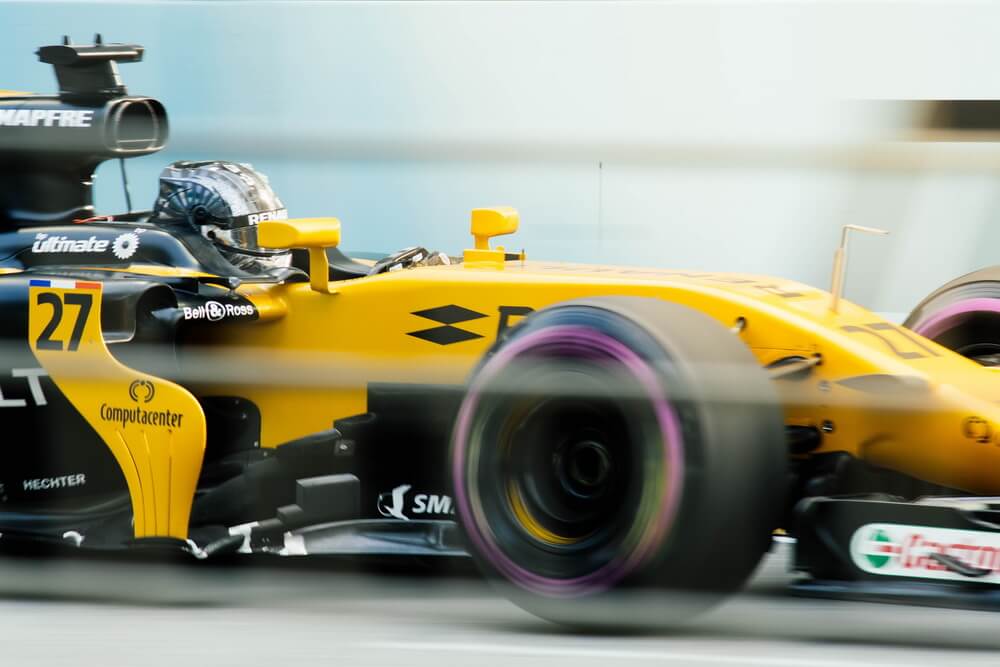
On-demand platforms for instructors and customers
How does technology help in sports and fitness business management? To answer this question, we’ll mention another category of software for gym and fitness studio management, on-demand fitness classes and workout streaming. These solutions help sports and fitness professionals move all or part of their operations online, run classes and provide customers with telefitness services without the need to invest in a new fitness or sports website design and development.
When talking about the most recent technological advancements in sports, it would be unfair to miss the whole new market in this industry that emerged thanks to digital technologies. eSports, which includes eRacing, fighting games, shooters, etc. is a fast-growing sector built around mobile and PC gaming, AR and VR as well as AI technologies and even autonomous vehicles.
NFT and blockchain technology in sports
The impact of some IT technologies in sports is less clear yet significant. Blockchain and NFT, seemingly the least candidates to get to this list, are in fact some of the major drivers of sports as a business. Fans tokens, digital tickets, digital collectibles and loyalty programs that bring an audience of many millions closer to their favorite clubs and sports events are powered by these technologies .
Digiteum experience in developing sports and fitness applications
During over a decade in software development, we have worked with several sports and fitness brands on a range of web, mobile, sports data analytics and broadcasting projects. Among them are:
- A gamified application GOAL app for Mudita Sports (UK). The app allows Arsenal and Man City fans to study languages together with their favorite football players in a series of engaging games.
- On-demand iOS apps for yoga and fitness instructors and students for a US startup Dona Media. Cloud-based apps integrate with wearables and provide a wide range of features, including scheduling, broadcasting, Twilio-based chat and calls, and customizable feeds.
- Large-scale web platform for sports stats broadcasting for an Australian sports data analytics company.
Are looking for a skilled tech team with solid experience in sports and fitness application development? Look no more. Whether you need help with your ongoing project or want to build an application from scratch and don’t know where to start, we got you covered.
Leverage our experience in sports tech
We have experience in your domain and a complete set of skills to design and develop your application.
This post was originally published on November 18, 2021 and updated on May 24, 2023.
Post by Digiteum Team

About Digiteum
Digiteum is a custom software development and IT consulting company founded in 2010. We design and develop customer-centric solutions for web, mobile, cloud, and IoT.
Design and Engineering
Technologies.
We are always looking for talented people. CHECK OPEN POSITIONS…
[email protected]

How Technologies Impact Sports in the Digital Age
- First Online: 13 September 2020
Cite this chapter

- Sascha L. Schmidt 2
Part of the book series: Future of Business and Finance ((FBF))
4522 Accesses
10 Citations
Schmidt introduces the relationship between technology and sports in the digital age taking time to outline improvements to athletic performance, sport consumption, sports management, and governance. He also describes how technology drives the development of new sports and enhancement of traditional sport. Finally, he outlines the process by which technologies were selected for 21st Century sports: How technologies will change sports in the digital age as well as the structure and chapters of the book.
This is a preview of subscription content, log in via an institution to check access.
Access this chapter
Subscribe and save.
- Get 10 units per month
- Download Article/Chapter or eBook
- 1 Unit = 1 Article or 1 Chapter
- Cancel anytime
- Available as PDF
- Read on any device
- Instant download
- Own it forever
- Available as EPUB and PDF
- Compact, lightweight edition
- Dispatched in 3 to 5 business days
- Free shipping worldwide - see info
Tax calculation will be finalised at checkout
Purchases are for personal use only
Institutional subscriptions
Similar content being viewed by others

Human Enhancement in Sports

For a view of sports through the lenses of athletes, consumers, and managers, see the SportsTech framework by Penkert and Malhotra ( 2019 ).
Although chess players do not compete based on athletic prowess, the International Olympic Committee has acknowledged the sport-like properties inherent in chess and recognized chess as a sport.
Esports also known as electronic sports, e-sports, or eSports is a form of sport competition using video games.
Archer, B. H. (1980). Forecasting demand: Quantitative and intuitive techniques. International Journal of Tourism Management, 1 (1), 5–12.
Article Google Scholar
Armstrong, J. S. (Ed.). (2001). Principles of forecasting: A handbook for researchers and practitioners . Norwell, Massachusetts: Kluwer Academic Publishers.
Google Scholar
Cetron, M. (1970). A method for integrating goals and technological forecasts into planning. Technology Forecasting & Social Change, 2 (1), 23–51.
Chan-Olmsted, S., & Xiao, M. (2019). Smart sports fans: Factors influencing sport consumption on smartphones. Sport Marketing Quarterly, 28 (4), 181–194.
Crouse, K. (2009). Swimming bans high-tech suits, ending an era [Online]. Retrieved April 16, 2020, from https://www.nytimes.com/2009/07/25/sports/25swim.html .
Düking, P., Stammel, C., Sperlich, B., Sutehall, S., Muniz-Pardos, B., Lima, G., et al. (2018). Necessary steps to accelerate the integration of wearable sensors into recreation and competitive sports. International Perspectives, 7 (6), 178–182.
Gartner. (2017, 2018, 2019). Gartner hype cycle for emerging technologies. Stamford, CT: Gartner Inc.
Ha, A. (2020). AKQA says it used AI to invent a new sport called Speedgate [Online]. Retrieved January 24, 2020, from https://techcrunch.com/2019/04/11/akqa-says-it-used-ai-to-invent-a-new-sport-called-speedgate/ .
Häder, M. (2009). 2800 Jahre Delphi: Ein historischer Überblick . Wiesbaden: VS Verlag für Sozialwissenschaften.
Harari, Y. N. (2016). Homo Deus: A brief history of tomorrow . London: Harvill Secker.
Harrison, K., & Bukstein, S. (2016). Sport business analytics: Using data to increase revenue and improve operational efficiency . New York: Auerbach Publications.
Book Google Scholar
Hienerth, C. (2006). The commercialization of user innovations: The development of the rodeo kayaking industry. R&D Management, 36 (3), 273–294.
Hienerth, C., von Hippel, E., & Berg Jensen, M. (2014). User community vs. producer innovation development efficiency: A first empirical study. Research Policy, 43, 190–201.
Jung, S., Hwang, S., Shim, D. H., & Shin, H. (2018). Perception, guidance, and navigation for indoor autonomous drone racing using deep learning. IEEE Robotics and Automation Letters, 3 (3), 2539–2544.
Kopacek, P. (2009). Automation in sports and entertainment. In S. Y. Nof (Eds.), Springer handbook of automation (pp. 1313–1331). Berlin, Heidelberg: Springer.
KPMG. (2016). The business of sports: Playing to win as the game unfurls . India: KPMG.com/in.
Kyodo News. (2019). Paralympics: Blade jumper Markus Rehm chases able-bodied world record [Online]. Retrieved August 28, 2019, from https://english.kyodonews.net/news/2019/08/256037e97f02-paralympics-blade-jumper-rehm-chases-able-bodied-world-record.html .
Lombardo, M. P. (2012). On the evolution of sport. Evolutionary Psychology, 10 (1), 1–28.
Michelman, P. (2019). Why sports is a great proving ground for management ideas [Online]. Retrieved January 13, 2020, from https://sloanreview.mit.edu/article/why-sports-is-a-great-proving-ground-for-management-ideas/ .
Newzoo. (2019). Global esport market report . Amsterdam.
Parent, M., & Chappelet, J.-L. (2015). The Routledge handbook of sports event management . New York: Routledge.
Phaal, R., Farrukh, C. J. P., & Probert, D. R. (2004). Technology roadmapping—A planning framework for evolution and revolution. Technological Forecasting and Social Change, 71, 5–26.
Penkert, B., & Malhotra, R. (2019). Global sportstech VC report . Berlin: Sportechx.
Ratten, V. (2019). Sports technology and innovation. Assessing cultural and social factors. London: Palgrave Macmillan.
Reiter, B. (2017). Theory and methodology of exploratory social science research. International Journal of Science and Research Methodology, 5 (4), 129–150.
Rescher, N. (1998). Predicting the future: An introduction to the theory of forecasting . State University of New York Press.
Schmidt, S. L. (2018). Beat the robot [Online]. Retrieved April 16, 2020, from https://digital.hbs.edu/artificial-intelligence-machine-learning/beat-the-robot/ .
Scholz, T. (2019). ESports is business: Management in the world of competitive gaming . Cham: Palgrave Pivot.
Standaert, W., & Jarvenpaa, S. (2016). Formula E: Next generation motorsport with next generation fans. In International Conference on Information Systems , Dublin.
The Guardian. (2020). World athletics denies tipping off Nike over new running-shoe regulations [Online]. Retrieved January 13, 2020, from https://www.theguardian.com/sport/2020/feb/06/world-athletics-foot-down-nike-running-shoe-regulations .
Two Circles. (2019). Sport misses out on 16bn despite growth year for sponsorship spend [Online]. Retrieved February 26, 2020, from https://twocircles.com/eu-en/articles/sport-misses-out-on-14bn-despite-growth-year-for-sponsorship-spend .
Van Wyk, R. J. (1997). Strategic technology scanning. Technological Forecasting and Social Change, 55 (1), 21–38.
von Hippel, E., Ogawa, S., & de Jong, J. P. J. (2011). The age of the user-innovator. Sloan Management Review (Fall), 53 (1), 27–35.
Walsh, S. T. (2003). Roadmapping a disruptive technology: A case study. Technological Forecasting and Social Change, 71 (1–2), 161–185.
Walsh, C. J., Endo, K., & Herr, H. (2007). A quasi-passive leg exoskeleton for load-carrying augmentation. International Journal of Humanoid Robotics, 4, 487–506.
Weisman, L. (2014). Laser technology enhances experience for sports fans, refs. Photonics Media, September 2014 [Online]. Retrieved February 19, 2020, from https://www.photonics.com/Articles/Laser_Technology_Enhances_Experience_for_Sports/a56631 .
Download references
Author information
Authors and affiliations.
Center for Sports and Management, WHU - Otto Beisheim School of Management, Dusseldorf, Germany
Sascha L. Schmidt
You can also search for this author in PubMed Google Scholar
Corresponding author
Correspondence to Sascha L. Schmidt .
Editor information
Editors and affiliations.
Chair/Center for Sports and Management, WHU - Otto Beisheim School of Management, Dusseldorf, Germany
Rights and permissions
Reprints and permissions
Copyright information
© 2020 Springer Nature Switzerland AG
About this chapter
Schmidt, S.L. (2020). How Technologies Impact Sports in the Digital Age. In: Schmidt, S.L. (eds) 21st Century Sports. Future of Business and Finance. Springer, Cham. https://doi.org/10.1007/978-3-030-50801-2_1
Download citation
DOI : https://doi.org/10.1007/978-3-030-50801-2_1
Published : 13 September 2020
Publisher Name : Springer, Cham
Print ISBN : 978-3-030-50800-5
Online ISBN : 978-3-030-50801-2
eBook Packages : Business and Management Business and Management (R0)
Share this chapter
Anyone you share the following link with will be able to read this content:
Sorry, a shareable link is not currently available for this article.
Provided by the Springer Nature SharedIt content-sharing initiative
- Publish with us
Policies and ethics
- Find a journal
- Track your research
Information
- Author Services
Initiatives
You are accessing a machine-readable page. In order to be human-readable, please install an RSS reader.
All articles published by MDPI are made immediately available worldwide under an open access license. No special permission is required to reuse all or part of the article published by MDPI, including figures and tables. For articles published under an open access Creative Common CC BY license, any part of the article may be reused without permission provided that the original article is clearly cited. For more information, please refer to https://www.mdpi.com/openaccess .
Feature papers represent the most advanced research with significant potential for high impact in the field. A Feature Paper should be a substantial original Article that involves several techniques or approaches, provides an outlook for future research directions and describes possible research applications.
Feature papers are submitted upon individual invitation or recommendation by the scientific editors and must receive positive feedback from the reviewers.
Editor’s Choice articles are based on recommendations by the scientific editors of MDPI journals from around the world. Editors select a small number of articles recently published in the journal that they believe will be particularly interesting to readers, or important in the respective research area. The aim is to provide a snapshot of some of the most exciting work published in the various research areas of the journal.
Original Submission Date Received: .
- Active Journals
- Find a Journal
- Proceedings Series
- For Authors
- For Reviewers
- For Editors
- For Librarians
- For Publishers
- For Societies
- For Conference Organizers
- Open Access Policy
- Institutional Open Access Program
- Special Issues Guidelines
- Editorial Process
- Research and Publication Ethics
- Article Processing Charges
- Testimonials
- Preprints.org
- SciProfiles
- Encyclopedia

Article Menu

- Subscribe SciFeed
- Recommended Articles
- Google Scholar
- on Google Scholar
- Table of Contents
Find support for a specific problem in the support section of our website.
Please let us know what you think of our products and services.
Visit our dedicated information section to learn more about MDPI.
JSmol Viewer
Technological breakthroughs in sport: current practice and future potential of artificial intelligence, virtual reality, augmented reality, and modern data visualization in performance analysis.

1. Introduction
2. overview, 3. performance analysis in sports.
- Observational Analysis: This refers to the methodical process of gathering, documenting, and assessing data by directly observing athletes or sporting events. It involves trained observers who meticulously record various facets of athletic performance. This analytical approach serves as a foundation for comprehensive assessments of athletes’ strengths, weaknesses, and areas for improvement. It can be performed using just the naked eye and recorded or supplemented with external data from different sources [ 4 , 59 ].
- Video Analysis: A technique that utilizes recorded game or training footage to study and review an athlete’s performance or a team’s tactical approach. It allows for the analysis of various aspects such as skills, techniques, player movement, and team formations. The use of various video speeds, from slow motion to frame-by-frame, enables intricate scrutiny of every action, providing detailed feedback to athletes and coaches [ 11 , 47 , 51 , 52 , 53 , 55 , 60 , 61 ].
- Notational Analysis: This systematic process involves the recording and analysis of discrete events that occur during a match or training session. Each event is notated or coded to provide a quantitative means of recording the performance. The data gathered provide an objective record of performance and can offer insights into the effectiveness of tactics, strategies, and individual player actions [ 10 , 56 , 62 , 63 ].
- Time-Motion Analysis: This is a method used to quantify the physical demands of a sport, by recording and categorizing all movements of an athlete during a match or training session. It provides insight into the duration and intensity of various activities, the frequency of specific movements, and the rest periods. The information gathered can guide training and recovery programs and help evaluate players’ physical performance during the competition [ 57 , 58 , 60 , 61 , 62 , 64 , 65 , 66 ].
- Data Analysis from Wearable Devices: Wearable technology has gained significant traction in sports, with devices like Global Positioning System (GPS) trackers, heart rate monitors, and accelerometers now commonly used. These devices capture a range of physiological and biomechanical data, including heart rate, speed, distance covered, body temperature, and sleep quality. Analysts use this data to monitor player health, access games and training sessions’ external loads, and optimize performance [ 47 , 48 , 49 , 50 , 51 , 57 , 67 , 68 , 69 ].
Computers Evaluation and Performance Analysis in Sports
4. artificial intelligence (ai) in sports performance analysis, 4.1. definition and history, 4.2. how ai can contribute to sports performance analysis.
- Data Collection: AI transforms traditional data collection methods into precise, large-scale processes, reducing manual bias.
- Advanced Data Analysis: AI automates data analysis, identifying hidden patterns and trends within large datasets for performance enhancement and strategy planning.
- Enhanced Video Analysis: AI-driven video analysis is faster, more precise, and more comprehensive than manual reviews, offering insights into player movements, team formations, and tactics.
- Notational Analysis: AI streamlines notational analysis by automating the recognition and annotation of specific actions, improving both efficiency and accuracy.
- Time-Motion Analysis: AI revolutionizes time-motion analysis by providing real-time insights into athlete energy expenditure and fatigue levels, leading to better player substitution strategies.
- Wearable Device Data Analysis: AI analyzes real-time data from wearable devices, predicting potential health risks and suggesting personalized training programs.
- Injury Prevention: AI in computer vision analyzes player biomechanics, identifies harmful patterns, and suggests technique modifications, enhancing player safety.
5. Virtual Reality (VR) and Augmented Reality (AR) in Sports Performance Analysis
5.1. definition and history, 5.2. how vr and ar can contribute to sports performance analysis.
- Creating Immersive Coaching and Training Environments: VR and AR technologies immerse athletes in realistic training scenarios, providing real-time coaching feedback.
- Skill and Strategy Development: These technologies offer interactive, repeatable scenarios that challenge and refine athletes’ skills. Also, to visualize game scenarios, positioning, and tactics in a comprehensive and interactive manner.
- Delivering Tactical Insights: AR overlays digital information onto the physical environment, assisting athletes in making strategic decisions during gameplay.
- Providing Real-time Athlete Feedback: Athletes receive immediate feedback and performance data in their field of vision, allowing adjustments during training.
- Facilitating Data-Driven Decision-Making: Coaches and athletes can make informed decisions by accessing comprehensive performance metrics and tactical insights.
- Supporting Rehabilitation: VR and AR can be used for aiding in injury prevention and rehabilitation.
- Bridging the Gap Between Physical and Mental Preparedness : VR and AR develop cognitive awareness and psychological readiness, complementing physical training for high-pressure situations.
- Visualizing Performance Data: VR and AR help athletes better understand performance data, enhancing their decision-making and mental acuity.
- Enriching Spectator Experiences: AR enhances the viewing experience for spectators by overlaying live broadcasts with dynamic graphics and statistics, providing deeper insights into the game.
6. Data Visualization (DV) in Sports Performance Analysis
6.1. definition and history.
“A picture is worth a thousand words”.
6.2. How DV Can Contribute to the Sports Performance Analysis Traditional Methodology
- Simplified Data Interpretation: DV simplifies complex performance data, making it more understandable.
- Valuable Insights: It helps extract valuable insights from extensive datasets, enabling data-driven decision-making in sports.
- Tactical Analysis: Heatmaps, motion paths, and other visualizations enable coaches to analyze player movements, tactics, and positioning strategies effectively.
- Narrative Power: DV goes beyond numbers, crafting visual narratives that empower coaches, athletes, and analysts to uncover deeper insights.
- Real-Time Decision-Making: Dynamic dashboards with real-time statistics assist coaches and analysts in making better decisions during games, benefiting data-driven broadcasting.
- Historical Data Trends: DV helps in identifying historical trends, strengths, and weaknesses, aiding teams in strategic planning and player selection.
- Predictive Analytics: DV can enable predictions about overall performance, individual player contributions, and team selections based on historical and current data.
7. Discussion
8. conclusions, 9. future directions, author contributions, institutional review board statement, informed consent statement, data availability statement, conflicts of interest.
- Mackenzie, R.; Cushion, C. Performance Analysis in Football: A Critical Review and Implications for Future Research. J. Sport. Sci. 2013 , 31 , 639–676. [ Google Scholar ] [ CrossRef ]
- Araujo, D.; Coucerio, M.; Seifert, L.; Sarmento, H.; Davids, K. Artificial Intelligence for Pattern Recognition in Sports: Classifying Actions and Performance Signatures in Artificial Intelligence in Sport Performance Analysis , 1st ed.; Routledge: London, UK, 2021. [ Google Scholar ]
- Hausdorff, J.M. Gait Dynamics, Fractals and Falls: Finding Meaning in the Stride-to-Stride Fluctuations of Human Walking. Hum. Mov. Sci. 2007 , 26 , 555–589. [ Google Scholar ] [ CrossRef ] [ PubMed ]
- Liebermann, D.G.; Katz, L.; Hughes, M.D.; Bartlett, R.M.; McClements, J.; Franks, I.M. Advances in the Application of Information Technology to Sport Performance. J. Sport. Sci. 2002 , 20 , 755–769. [ Google Scholar ] [ CrossRef ] [ PubMed ]
- Watanabe, N.M.; Shapiro, S.; Drayer, J. Big Data and Analytics in Sport Management. J. Sport Manag. 2021 , 35 , 197–202. [ Google Scholar ] [ CrossRef ]
- Goes, F.R.; Meerhoff, L.A.; Bueno, M.J.O.; Rodrigues, D.M.; Moura, F.A.; Brink, M.S.; Elferink-Gemser, M.T.; Knobbe, A.J.; Cunha, S.A.; Torres, R.S.; et al. Unlocking the Potential of Big Data to Support Tactical Performance Analysis in Professional Soccer: A Systematic Review. Eur. J. Sport Sci. 2021 , 21 , 481–496. [ Google Scholar ] [ CrossRef ] [ PubMed ]
- Rein, R.; Memmert, D. Big Data and Tactical Analysis in Elite Soccer: Future Challenges and Opportunities for Sports Science. SpringerPlus 2016 , 5 , 1410. [ Google Scholar ] [ CrossRef ]
- Hughes, M.D.; Bartlett, R.M. The Use of Performance Indicators in Performance Analysis. J. Sport. Sci. 2002 , 20 , 739–754. [ Google Scholar ] [ CrossRef ] [ PubMed ]
- Hughes, M.; Franks, I. Notational Analysis—A Review of Literature. In Notational Analysis of Sport ; Hughes, M., Franks, I., Eds.; Routledge: London, UK, 2004. [ Google Scholar ]
- O’Donoghue, P. Research Methods for Sports Performance Analysis ; Routledge: London, UK, 2010. [ Google Scholar ]
- Clephas, C.; Foster, M.; Stergiou, P.; Katz, L. Performance Analysis of the Flip Turn in Swimming: The Relationship between Pressures and Performance Times. J. Hum. Sport Exerc. 2022 , 17 , 74–82. [ Google Scholar ] [ CrossRef ]
- Muñoz-Llerena, A.; Caballero-Blanco, P.; Hernández-Hernández, E. Fostering Youth Female Athletes’ Decision-Making Skills through Competitive Volleyball: A Mixed Methods Design. Int. J. Environ. Res. Public Health 2022 , 19 , 13261. [ Google Scholar ] [ CrossRef ]
- Krizkova, S.; Tomaskova, H.; Tirkolaee, E.B. Sport Performance Analysis with a Focus on Racket Sports: A Review. Appl. Sci. 2021 , 11 , 9212. [ Google Scholar ] [ CrossRef ]
- Cust, E.E.; Sweeting, A.J.; Ball, K.; Robertson, S. Machine and Deep Learning for Sport-Specific Movement Recognition: A Systematic Review of Model Development and Performance. J. Sport. Sci. 2019 , 37 , 568–600. [ Google Scholar ] [ CrossRef ] [ PubMed ]
- Sands, W.A.; Kavanaugh, A.A.; Murray, S.R.; McNeal, J.R.; Jemni, M. Modern Techniques and Technologies Applied to Training and Performance Monitoring. Int. J. Sports Physiol. Perform. 2017 , 12 (Suppl. S2), 63–72. [ Google Scholar ] [ CrossRef ] [ PubMed ]
- Lames, M.; McGarry, T. On the Search for Reliable Performance Indicators in Game Sports. Int. J. Perform. Anal. Sport 2007 , 7 , 62–79. [ Google Scholar ] [ CrossRef ]
- Gréhaigne, J.F.; Godbout, P. Dynamic Systems Theory and Team Sport Coaching. Quest 2014 , 66 , 96–116. [ Google Scholar ] [ CrossRef ]
- Libet, J.M.; Lewinsohn, P.M. Concept of Social Skill with Special Reference to the Behavior of Depressed Persons. J. Consult. Clin. Psychol. 1973 , 40 , 304–312. [ Google Scholar ] [ CrossRef ] [ PubMed ]
- Rein, R.; Raabe, D.; Memmert, D. “Which Pass Is Better?” Novel Approaches to Assess Passing Effectiveness in Elite Soccer. Hum. Mov. Sci. 2017 , 55 , 172–181. [ Google Scholar ] [ CrossRef ] [ PubMed ]
- Muthukrishnan, N.; Maleki, F.; Ovens, K.; Reinhold, C.; Forghani, B.; Forghani, R. Brief History of Artificial Intelligence. Neuroimaging Clin. N. Am. 2020 , 30 , 393–399. [ Google Scholar ] [ CrossRef ]
- Jiang, F.; Jiang, Y.; Zhi, H.; Dong, Y.; Li, H.; Ma, S.; Wang, Y.; Dong, Q.; Shen, H.; Wang, Y. Artificial Intelligence in Healthcare: Past, Present and Future. Stroke Vasc. Neurol. 2017 , 2 , 230–243. [ Google Scholar ] [ CrossRef ]
- Chen, Y.; Perez, Y. Business Model Design: Lessons Learned from Tesla Motors. In Towards a Sustainable Economy ; Springer International Publishing AG: Cham, Switzerland, 2018; pp. 53–69. [ Google Scholar ] [ CrossRef ]
- Novatchkov, H.; Baca, A. Artificial Intelligence in Sports on the Example of Weight Training. J. Sport. Sci. Med. 2013 , 12 , 27. [ Google Scholar ]
- Li, L.; Li, L. Summary of the Research Status of Artificial Intelligence in Sports Performance Analysis of Athletes. Open Access Libr. J. 2023 , 10 , e10539. [ Google Scholar ] [ CrossRef ]
- Xu, J. Prediction and Planning of Sports Competition Based on Deep Neural Network. Comput. Intell. Neurosci. 2022 , 2022 , 1906580. [ Google Scholar ] [ CrossRef ] [ PubMed ]
- Sorrentino, R.M.; Levy, R.; Katz, L.; Peng, X. Virtual Visualization: Preparation for the Olympic Games Long-Track Speed Skating. Int. J. Comput. Sci. Sport 2005 , 4 , 39–44. [ Google Scholar ]
- Sorrentino, R.M.; Katz, L. Virtual Reality and Elite Athletes. Med. Sci. Sport. Exerc. 2002 , 34 , 38. [ Google Scholar ] [ CrossRef ]
- Katz, L.; Parker, H.; Levy, R. Virtual Reality. In Computer in Sport ; Dabnichki, P., Baca, A., Eds.; WIT Press: Southampton, SO, USA, 2008; pp. 3–41. [ Google Scholar ]
- Azuma, R.T. A Survey of Augmented Reality. Presence Teleoperators Virtual Environ. 1997 , 6 , 355–385. [ Google Scholar ] [ CrossRef ]
- Michalski, S.C.; Szpak, A.; Loetscher, T. Using Virtual Environments to Improve Real-World Motor Skills in Sports: A Systematic Review. Front. Psychol. 2019 , 10 , 466681. [ Google Scholar ] [ CrossRef ] [ PubMed ]
- Rauschnabel, P.A. Augmented Reality Is Eating the Real-World! The Substitution of Physical Products by Holograms. Int. J. Inf. Manag. 2021 , 57 , 102279. [ Google Scholar ] [ CrossRef ]
- Greenhough, B.; Barrett, S.; Towlson, C.; Abt, G. Perceptions of Professional Soccer Coaches, Support Staff and Players toward Virtual Reality and the Factors That Modify Their Intention to Use It. PLoS ONE 2021 , 16 , e0261378. [ Google Scholar ] [ CrossRef ]
- Le Noury, P.; Polman, R.; Maloney, M.; Gorman, A. A Narrative Review of the Current State of Extended Reality Technology and How It Can Be Utilised in Sport. Sports Med. 2022 , 52 , 1473–1489. [ Google Scholar ] [ CrossRef ]
- Neumann, D.L.; Moffitt, R.L.; Thomas, P.R.; Loveday, K.; Watling, D.P.; Lombard, C.L.; Antonova, S.; Tremeer, M.A. A Systematic Review of the Application of Interactive Virtual Reality to Sport. Virtual Real. 2018 , 22 , 183–198. [ Google Scholar ] [ CrossRef ]
- Bideau, B.; Kulpa, R.; Vignais, N.; Brault, S.; Multon, F.; Craig, C. Using Virtual Reality to Analyze Sports Performance. IEEE Comput. Graph Appl. 2010 , 30 , 14–21. [ Google Scholar ] [ CrossRef ]
- Faure, C.; Limballe, A.; Bideau, B.; Kulpa, R. Virtual Reality to Assess and Train Team Ball Sports Performance: A Scoping Review. J. Sport. Sci. 2020 , 38 , 192–205. [ Google Scholar ] [ CrossRef ] [ PubMed ]
- Pastel, S.; Marlok, J.; Bandow, N.; Witte, K. Application of Eye-Tracking Systems Integrated into Immersive Virtual Reality and Possible Transfer to the Sports Sector—A Systematic Review. Multimed. Tools Appl. 2023 , 82 , 4181–4208. [ Google Scholar ] [ CrossRef ]
- Liu, P.; Lu, L.; Zhang, J.; Huo, T.; Liu, S.; Ye, Z. Application of Artificial Intelligence in Medicine: An Overview. Curr. Med. Sci. 2021 , 41 , 1105–1115. [ Google Scholar ] [ CrossRef ] [ PubMed ]
- Provost, F.; Fawcett, T. Data Science for Business: What You Need to Know about Data Mining and Data-Analytic Thinking , 1st ed.; O’Reilly Media: Sebastopol, CA, USA, 2013. [ Google Scholar ]
- Knaflic, C.N. Storytelling with Data: A Data Visualization Guide for Business Professionals , 1st ed.; Wiley: Hoboken, NJ, USA, 2015. [ Google Scholar ]
- Fry, M.J.; Ohlmann, J.W. Introduction to the Special Issue on Analytics in Sports, Part II: Sports Scheduling Applications. Interfaces 2012 , 42 , 229–231. [ Google Scholar ] [ CrossRef ]
- Fry, M.J.; Ohlmann, J.W. Introduction to the Special Issue on Analytics in Sports, Part I: General Sports Applications. Interfaces 2012 , 42 , 105–108. [ Google Scholar ] [ CrossRef ]
- Yang, H.; Luo, C. Accuracy Analysis of Sports Performance Prediction Based on BP Neural Network Intelligent Algorithm. Secur. Commun. Netw. 2022 , 2022 , 4198920. [ Google Scholar ] [ CrossRef ]
- Sarlis, V.; Chatziilias, V.; Tjortjis, C.; Mandalidis, D. A Data Science Approach Analysing the Impact of Injuries on Basketball Player and Team Performance. Inf. Syst. 2021 , 99 , 101750. [ Google Scholar ] [ CrossRef ]
- Pino-Ortega, J.; Rojas-Valverde, D.; Gómez-Carmona, C.D.; Rico-González, M. Training Design, Performance Analysis, and Talent Identification-A Systematic Review about the Most Relevant Variables through the Principal Component Analysis in Soccer, Basketball, and Rugby. Int. J. Environ. Res. Public Health 2021 , 18 , 2642. [ Google Scholar ] [ CrossRef ]
- Lutz, J.; Memmert, D.; Raabe, D.; Dornberger, R.; Donath, L. Wearables for Integrative Performance and Tactic Analyses: Opportunities, Challenges, and Future Directions. Int. J. Environ. Res. Public Health 2019 , 17 , 59. [ Google Scholar ] [ CrossRef ]
- Freitas, R.; Volossovitch, A.; Almeida, C.H.; Vleck, V. Elite-Level Defensive Performance in Football: A Systematic Review. Ger. J. Exerc. Sport Res. 2023 , 53 , 458–470. [ Google Scholar ] [ CrossRef ]
- Strauss, A.; Sparks, M.; Pienaar, C. The Use of GPS Analysis to Quantify the Internal and External Match Demands of Semi-Elite Level Female Soccer Players during a Tournament. J. Sport. Sci. Med. 2019 , 18 , 73. [ Google Scholar ] [ PubMed ]
- Pons, E.; García-Calvo, T.; Resta, R.; Blanco, H.; del Campo, R.L.; García, J.D.; Pulido, J.J. A Comparison of a GPS Device and a Multi-Camera Video Technology during Official Soccer Matches: Agreement between Systems. PLoS ONE 2019 , 14 , e0220729. [ Google Scholar ] [ CrossRef ] [ PubMed ]
- Grainger, M.; Weisberg, A.; Stergiou, P.; Katz, L. Comparison of Two Methods in the Estimation of Vertical Jump Height. J. Hum. Sport Exerc. 2020 , 15 , 623–632. [ Google Scholar ] [ CrossRef ]
- Rana, M.; Mittal, V. Wearable Sensors for Real-Time Kinematics Analysis in Sports: A Review. IEEE Sens. J. 2021 , 21 , 1187–1207. [ Google Scholar ] [ CrossRef ]
- Hendricks, S.; Till, K.; Den Hollander, S.; Savage, T.N.; Roberts, S.P.; Tierney, G.; Burger, N.; Kerr, H.; Kemp, S.; Cross, M.; et al. Consensus on a Video Analysis Framework of Descriptors and Definitions by the Rugby Union Video Analysis Consensus Group. Br. J. Sports Med. 2020 , 54 , 566–572. [ Google Scholar ] [ CrossRef ] [ PubMed ]
- Linke, D.; Link, D.; Lames, M. Football-Specific Validity of TRACAB’s Optical Video Tracking Systems. PLoS ONE 2020 , 15 , e0230179. [ Google Scholar ] [ CrossRef ] [ PubMed ]
- Clephas, C.; Stergiou, P.; Tyreman, H.; Katz, L. Predicting Olympic Success by Regression Modeling in Sport—An Analysis of the Beginning of the 21st Century. In Proceedings of the 13th World Congress of Performance Analysis of Sport and 13th International Symposium on Computer Science in Sport, Vienna, Austria, 10–13 September 2023; pp. 60–63. [ Google Scholar ] [ CrossRef ]
- Macaulay, C.A.J.; Katz, L.; Stergiou, P.; Stefanyshyn, D.; Tomaghelli, L. Kinematic and Kinetic Analysis of Overhand, Sidearm and Underhand Lacrosse Shot Techniques. J. Sport. Sci. 2017 , 35 , 2350–2356. [ Google Scholar ] [ CrossRef ] [ PubMed ]
- Andreassen, K.; Johansen, D.; Johansen, H.; Baptista, I.; Pettersen, S.A.; Riegler, M.; Halvorsen, P. Real-Time Analysis of Physical Performance Parameters in Elite Soccer. In Proceedings of the International Conference on Content-Based Multimedia Indexing (CBMI), Dublin, Ireland, 4–6 September 2019. [ Google Scholar ] [ CrossRef ]
- Palucci Vieira, L.H.; Carling, C.; Barbieri, F.A.; Aquino, R.; Santiago, P.R.P. Match Running Performance in Young Soccer Players: A Systematic Review. Sport. Med. 2019 , 49 , 289–318. [ Google Scholar ] [ CrossRef ]
- Murtagh, C.F.; Naughton, R.J.; McRobert, A.P.; O’Boyle, A.; Morgans, R.; Drust, B.; Erskine, R.M. A Coding System to Quantify Powerful Actions in Soccer Match Play: A Pilot Study. Res. Q. Exerc. Sport 2019 , 90 , 234–243. [ Google Scholar ] [ CrossRef ]
- Hopkins, W.G. Quantification of Training in Competitive Sports. Methods and Applications. Sports Med. 1991 , 12 , 161–183. [ Google Scholar ] [ CrossRef ]
- Pappalardo, L.; Cintia, P.; Rossi, A.; Massucco, E.; Ferragina, P.; Pedreschi, D.; Giannotti, F. A Public Data Set of Spatio-Temporal Match Events in Soccer Competitions. Sci. Data 2019 , 6 , 236. [ Google Scholar ] [ CrossRef ] [ PubMed ]
- Di Salvo, V.; Gregson, W.; Atkinson, G.; Tordoff, P.; Drust, B. Analysis of High Intensity Activity in Premier League Soccer. Int. J. Sports Med. 2009 , 30 , 205–212. [ Google Scholar ] [ CrossRef ] [ PubMed ]
- Carling, C. Analysis of Physical Activity Profiles When Running with the Ball in a Professional Soccer Team. J. Sport. Sci. 2010 , 28 , 319–326. [ Google Scholar ] [ CrossRef ] [ PubMed ]
- Wright, C.; Atkins, S.; Polman, R.; Jones, B.; Sargeson, L. Factors Associated with Goals and Goal Scoring Opportunities in Professional Soccer. Int. J. Perform. Anal. Sport 2011 , 11 , 439–449. [ Google Scholar ] [ CrossRef ]
- Mohr, M.; Krustrup, P.; Bangsbo, J. Match Performance of High-Standard Soccer Players with Special Reference to Development of Fatigue. J. Sport. Sci. 2003 , 21 , 519–528. [ Google Scholar ] [ CrossRef ] [ PubMed ]
- Di Salvo, V.; Baron, R.; Tschan, H.; Calderon Montero, F.J.; Bachl, N.; Pigozzi, F. Performance Characteristics According to Playing Position in Elite Soccer. Int. J. Sports Med. 2007 , 28 , 222–227. [ Google Scholar ] [ CrossRef ] [ PubMed ]
- Rampinini, E.; Impellizzeri, F.M.; Castagna, C.; Coutts, A.J.; Wisløff, U. Technical Performance during Soccer Matches of the Italian Serie A League: Effect of Fatigue and Competitive Level. J. Sci. Med. Sport 2009 , 12 , 227–233. [ Google Scholar ] [ CrossRef ] [ PubMed ]
- de Magalhaes, F.A.; Vannozzi, G.; Gatta, G.; Fantozzi, S. Wearable Inertial Sensors in Swimming Motion Analysis: A Systematic Review. J. Sport. Sci. 2015 , 33 , 732–745. [ Google Scholar ] [ CrossRef ]
- Horton, J.F.; Stergiou, P.; Fung, T.S.; Katz, L. Comparison of Polar M600 Optical Heart Rate and ECG Heart Rate during Exercise. Med. Sci. Sports Exerc. 2017 , 49 , 2600–2607. [ Google Scholar ] [ CrossRef ]
- Benson, L.C.; Clermont, C.A.; Bošnjak, E.; Ferber, R. The Use of Wearable Devices for Walking and Running Gait Analysis Outside of the Lab: A Systematic Review. Gait Posture 2018 , 63 , 124–138. [ Google Scholar ] [ CrossRef ]
- Casals, M.; Finch, C.F. Sports Biostatistician: A Critical Member of All Sports Science and Medicine Teams for Injury Prevention. Br. J. Sports Med. 2018 , 52 , 1457–1461. [ Google Scholar ] [ CrossRef ]
- Wright, C.; Atkins, S.; Jones, B.; Todd, J. The Role of Performance Analysts within the Coaching Process: Performance Analysts Survey “The Role of Performance Analysts in Elite Football Club Settings”. Int. J. Perform. Anal. Sport 2013 , 13 , 240–261. [ Google Scholar ] [ CrossRef ]
- Nicholls, S.B.; James, N.; Wells, J.; Parmar, N. Performance Analysis Practice within Olympic and Paralympic Sports: A Comparison of Coach and Analyst Experiences. Int. J. Perform. Anal. Sport 2022 , 22 , 343–351. [ Google Scholar ] [ CrossRef ]
- Wright, C.; Atkins, S.; Jones, B. An Analysis of Elite Coaches’ Engagement with Performance Analysis Services (Match, Notational Analysis and Technique Analysis). Int. J. Perform. Anal. Sport 2012 , 12 , 436–451. [ Google Scholar ] [ CrossRef ]
- Edwards, A.D.N. The Rise of the Graphical User Interface. Libr. Hi Tech 1996 , 14 , 46–50. [ Google Scholar ] [ CrossRef ]
- Oulasvirta, A.; Dayama, N.R.; Shiripour, M.; John, M.; Karrenbauer, A. Combinatorial Optimization of Graphical User Interface Designs. Proc. IEEE 2020 , 108 , 434–464. [ Google Scholar ] [ CrossRef ]
- Glowniak, J. The Internet as an Information Source for Geriatricians. Drugs Aging 1997 , 10 , 169–173. [ Google Scholar ] [ CrossRef ] [ PubMed ]
- Berndt, E.R.; Rappaport, N.J. Price and Quality of Desktop and Mobile Personal Computers: A Quarter-Century Historical Overview. Am. Econ. Rev. 2001 , 91 , 268–273. [ Google Scholar ] [ CrossRef ]
- Ross, S.J.; Hill, J.L.; Chen, M.Y.; Joseph, A.D.; Culler, D.E.; Brewer, E.A. A Composable Framework for Secure Multi-Modal Access to Internet Services from Post-PC Devices. Mob. Netw. Appl. 2002 , 7 , 389–406. [ Google Scholar ] [ CrossRef ]
- Makki, S.A.M.; Pissinou, N.; Daroux, P. Mobile and Wireless Internet Access. Comput. Commun. 2003 , 26 , 734–746. [ Google Scholar ] [ CrossRef ]
- Ko, A.J.; Abraham, R.; Beckwith, L.; Blackwell, A.; Burnett, M.; Erwig, M.; Scaffidi, C.; Lawrance, J.; Lieberman, H.; Myers, B.; et al. The State of the Art in End-User Software Engineering. ACM Comput. Surv. 2011 , 43 , 1–44. [ Google Scholar ] [ CrossRef ]
- Herbig, P.A.; Kramer, H. The Effect of Information Overload on the Innovation Choice Process. J. Consum. Mark. 1994 , 11 , 45–54. [ Google Scholar ] [ CrossRef ]
- Park, H.J.; Zhang, Y. Technology Readiness and Technology Paradox of Unmanned Convenience Store Users. J. Retail. Consum. Serv. 2022 , 65 , 102523. [ Google Scholar ] [ CrossRef ]
- Sagiroglu, S.; Sinanc, D. Big Data: A Review. In Proceedings of the International Conference on Collaboration Technologies and Systems (CTS), San Diego, CA, USA, 20–24 May 2013. [ Google Scholar ] [ CrossRef ]
- Passfield, L.; Hopker, J.G. A Mine of Information: Can Sports Analytics Provide Wisdom from Your Data? Int. J. Sports Physiol. Perform. 2017 , 12 , 851–855. [ Google Scholar ] [ CrossRef ] [ PubMed ]
- Gomez-Ruano, M.A.; Ibáñez, S.J.; Leicht, A.S. Editorial: Performance Analysis in Sport. Front. Psychol. 2020 , 11 , 611634. [ Google Scholar ] [ CrossRef ] [ PubMed ]
- Morgulev, E.; Azar, O.H.; Lidor, R. Sports Analytics and the Big-Data Era. Int. J. Data Sci. Anal. 2018 , 5 , 213–222. [ Google Scholar ] [ CrossRef ]
- Isichei, B.C.; Leung, C.K.; Nguyen, L.T.; Morrow, L.B.; Ngo, A.T.; Pham, T.D.; Cuzzocrea, A. Sports Data Management, Mining, and Visualization ; Lecture Notes in Networks and Systems; Springer: Cham, Switzerland, 2022; Volume 450 LNNS, pp. 141–153. [ Google Scholar ] [ CrossRef ]
- McCulloch, W.S.; Pitts, W. A Logical Calculus of the Ideas Immanent in Nervous Activity. Bull. Math. Biophys. 1943 , 5 , 115–133. [ Google Scholar ] [ CrossRef ]
- Turing, A.M.I. Computing machinery and intelligence. Mind 1950 , LIX , 433–460. [ Google Scholar ] [ CrossRef ]
- McCarthy, J.; Minsky, M.L.; Rochester, N.; Shannon, C.E. A Proposal for the Dartmouth Summer Research Project on Artificial Intelligence, August 31, 1955. AI Mag. 2006 , 27 , 12. [ Google Scholar ] [ CrossRef ]
- Rosenblatt, F. The Perceptron: A Probabilistic Model for Information Storage and Organization in the Brain. Psychol. Rev. 1958 , 65 , 386–408. [ Google Scholar ] [ CrossRef ]
- Hendler, J. Avoiding Another AI Winter. IEEE Intell. Syst. 2008 , 23 , 2–4. [ Google Scholar ] [ CrossRef ]
- Russell, S.; Norvig, P. Artificial Intelligence: A Modern Approach , 3rd ed.; Pearson: London, UK, 2009. [ Google Scholar ]
- Janiesch, C.; Zschech, P.; Heinrich, K. Machine Learning and Deep Learning. Electron. Mark. 2021 , 31 , 685–695. [ Google Scholar ] [ CrossRef ]
- Radford, A.; Wu, J.; Child, R.; Luan, D.; Amodei, D.; Sutskever, I. Language Models Are Unsupervised Multitask Learners. OpenAi Blog 2019 , 1 , 9. [ Google Scholar ]
- Openai, A.R.; Openai, K.N.; Openai, T.S.; Openai, I.S. Improving Language Understanding by Generative Pre-Training. OpenAi Blog 2018 . [ Google Scholar ]
- Brown, T.B.; Mann, B.; Ryder, N.; Subbiah, M.; Kaplan, J.; Dhariwal, P.; Neelakantan, A.; Shyam, P.; Sastry, G.; Askell, A.; et al. Language Models Are Few-Shot Learners. In Proceedings of the Advances in Neural Information Processing Systems 33 (NeurIPS 2020), Virtual, 6–12 December 2020. [ Google Scholar ]
- Zemková, E.; Plakias, S.; Moustakidis, S.; Kokkotis, C.; Papalexi, M.; Tsatalas, T.; Giakas, G.; Tsaopoulos, D. Identifying Soccer Players’ Playing Styles: A Systematic Review. J. Funct. Morphol. Kinesiol. 2023 , 8 , 104. [ Google Scholar ] [ CrossRef ]
- Goodfellow, Y.; Bengio, Y.; Courville, A. Deep Learning ; The MIT Press: Cambridge, MA, USA, 2018. [ Google Scholar ]
- Lecun, Y.; Bengio, Y.; Hinton, G. Deep Learning. Nature 2015 , 521 , 436–444. [ Google Scholar ] [ CrossRef ]
- Claudino, J.G.; Capanema, D.d.O.; de Souza, T.V.; Serrão, J.C.; Machado Pereira, A.C.; Nassis, G.P. Current Approaches to the Use of Artificial Intelligence for Injury Risk Assessment and Performance Prediction in Team Sports: A Systematic Review. Sport. Med. Open 2019 , 5 , 28. [ Google Scholar ] [ CrossRef ]
- López-Valenciano, A.; Ayala, F.; Puerta, J.M.; De Ste Croix, M.B.A.; Vera-Garcia, F.J.; Hernández-Sánchez, S.; Ruiz-Pérez, I.; Myer, G.D. A Preventive Model for Muscle Injuries: A Novel Approach Based on Learning Algorithms. Med. Sci. Sports Exerc. 2018 , 50 , 915–927. [ Google Scholar ] [ CrossRef ]
- Host, K.; Ivašić-Kos, M. An Overview of Human Action Recognition in Sports Based on Computer Vision. Heliyon 2022 , 8 , e09633. [ Google Scholar ] [ CrossRef ]
- Naik, B.T.; Hashmi, M.F.; Bokde, N.D. A Comprehensive Review of Computer Vision in Sports: Open Issues, Future Trends and Research Directions. Appl. Sci. 2022 , 12 , 4429. [ Google Scholar ] [ CrossRef ]
- Przednowek, K.; Krzeszowski, T.; Przednowek, K.H.; Lenik, P. A System for Analysing the Basketball Free Throw Trajectory Based on Particle Swarm Optimization. Appl. Sci. 2018 , 8 , 2090. [ Google Scholar ] [ CrossRef ]
- Wang, T.; Li, T. Deep Learning-Based Football Player Detection in Videos. Comput. Intell. Neurosci. 2022 , 2022 , 3540642. [ Google Scholar ] [ CrossRef ] [ PubMed ]
- Pai, P.F.; ChangLiao, L.H.; Lin, K.P. Analyzing Basketball Games by a Support Vector Machines with Decision Tree Model. Neural Comput. Appl. 2017 , 28 , 4159–4167. [ Google Scholar ] [ CrossRef ]
- Seshadri, D.R.; Li, R.T.; Voos, J.E.; Rowbottom, J.R.; Alfes, C.M.; Zorman, C.A.; Drummond, C.K. Wearable Sensors for Monitoring the Internal and External Workload of the Athlete. NPJ Digit. Med. 2019 , 2 , 71. [ Google Scholar ] [ CrossRef ] [ PubMed ]
- Kempe, M.; Grunz, A.; Memmert, D. Detecting Tactical Patterns in Basketball: Comparison of Merge Self-Organising Maps and Dynamic Controlled Neural Networks. Eur. J. Sport Sci. 2015 , 15 , 249–255. [ Google Scholar ] [ CrossRef ] [ PubMed ]
- Rauschnabel, P.A.; Felix, R.; Hinsch, C.; Shahab, H.; Alt, F. What Is XR? Towards a Framework for Augmented and Virtual Reality. Comput. Hum. Behav. 2022 , 133 , 107289. [ Google Scholar ] [ CrossRef ]
- Dargan, S.; Bansal, S.; Kumar, M.; Mittal, A.; Kumar, K. Augmented Reality: A Comprehensive Review. Arch. Comput. Methods Eng. 2023 , 30 , 1057–1080. [ Google Scholar ] [ CrossRef ]
- Milgram, P.; Takemura, H.; Utsumi, A.; Kishino, F. Augmented Reality: A Class of Displays on the Reality-Virtuality Continuum. In Telemanipulator and Telepresence Technologies ; SPIE: Bellingham, WA, USA, 1995; Volume 2351, pp. 282–292. [ Google Scholar ] [ CrossRef ]
- Gutierrez, N. The Ballad of Morton Heilig: On VR’s Mythic Past. JCMS J. Cine Media Stud. 2023 , 62 , 86–106. [ Google Scholar ] [ CrossRef ]
- Sutherland, I. A Head-Mounted Three Dimensional Display. In Proceedings of the AFIPS ’68, San Francisco, CA, USA, 9–11 December 1968; Volume 33, pp. 757–764. [ Google Scholar ] [ CrossRef ]
- Lanier, J. Virtual Reality The Promise of the Future. Interact. Learn. Int. 1992 , 8 , 275–279. [ Google Scholar ]
- Cruz-Neira, C.; Sandin, D.J.; DeFanti, T.A.; Kenyon, R.V.; Hart, J.C. The CAVE: Audio Visual Experience Automatic Virtual Environment. Commun. ACM 1992 , 35 , 64–72. [ Google Scholar ] [ CrossRef ]
- Berryman, D.R. Augmented Reality: A Review. Med. Ref. Serv. Q. 2012 , 31 , 212–218. [ Google Scholar ] [ CrossRef ] [ PubMed ]
- Berton, A.; Longo, U.G.; Candela, V.; Fioravanti, S.; Giannone, L.; Arcangeli, V.; Alciati, V.; Berton, C.; Facchinetti, G.; Marchetti, A.; et al. Virtual Reality, Augmented Reality, Gamification, and Telerehabilitation: Psychological Impact on Orthopedic Patients’ Rehabilitation. J. Clin. Med. 2020 , 9 , 2567. [ Google Scholar ] [ CrossRef ] [ PubMed ]
- Brepohl, P.C.A.; Leite, H. Virtual Reality Applied to Physiotherapy: A Review of Current Knowledge. Virtual Real. 2022 , 27 , 71–95. [ Google Scholar ] [ CrossRef ]
- Lin, Y.T.; Lee, W.C.; Hsieh, R.L. Active Video Games for Knee Osteoarthritis Improve Mobility but Not WOMAC Score: A Randomized Controlled Trial. Ann. Phys. Rehabil. Med. 2020 , 63 , 458–465. [ Google Scholar ] [ CrossRef ]
- Carnevale, A.; Mannocchi, I.; Sassi, M.S.H.; Carli, M.; De Luca, G.; Longo, U.G.; Denaro, V.; Schena, E. Virtual Reality for Shoulder Rehabilitation: Accuracy Evaluation of Oculus Quest 2. Sensors 2022 , 22 , 5511. [ Google Scholar ] [ CrossRef ]
- Tanaka, K.; Parker, J.R.; Baradoy, G.; Sheehan, D.; Holash, J.R.; Katz, L. A Comparison of Exergaming Interfaces for Use in Rehabilitation Programs and Research. Loading 2012 , 6 , 69–81. [ Google Scholar ]
- Shen, Y.; Ong, S.K.; Nee, A.Y.C. Augmented Reality for Collaborative Product Design and Development. Des. Stud. 2010 , 31 , 118–145. [ Google Scholar ] [ CrossRef ]
- Savela, N.; Oksanen, A.; Kaakinen, M.; Noreikis, M.; Xiao, Y. Does Augmented Reality Affect Sociability, Entertainment, and Learning? A Field Experiment. Appl. Sci. 2020 , 10 , 1392. [ Google Scholar ] [ CrossRef ]
- Campelo, A.M.; Katz, L. Older Adults’ Perceptions of the Usefulness of Technologies for Engaging in Physical Activity: Using Focus Groups to Explore Physical Literacy. Int. J. Environ. Res. Public Health 2020 , 17 , 1144. [ Google Scholar ] [ CrossRef ]
- Campelo, A.M.; Weisberg, A.; Sheehan, D.P.; Schneider, K.; Cossich, V.R.A.; Katz, L. Physical and Affective Physical Literacy Domains Improved after a Six-Week Exergame Exercise Program in Older Adults: A Randomized Controlled Clinical Trial. Games Health J. 2023 , 12 , 366–376. [ Google Scholar ] [ CrossRef ]
- Quqandi, E.; Joy, M.; Drumm, I.; Rushton, M. Augmented Reality in Supporting Healthcare and Nursing Independent Learning: Narrative Review. Comput. Inform. Nurs. 2023 , 41 , 281–291. [ Google Scholar ] [ CrossRef ] [ PubMed ]
- Vidal-Balea, A.; Blanco-Novoa, O.; Picallo-Guembe, I.; Celaya-Echarri, M.; Fraga-Lamas, P.; Lopez-Iturri, P.; Azpilicueta, L.; Falcone, F.; Fernández-Caramés, T.M. Analysis, Design and Practical Validation of an Augmented Reality Teaching System Based on Microsoft HoloLens 2 and Edge Computing. Eng. Proc. 2020 , 2 , 52. [ Google Scholar ] [ CrossRef ]
- Wyss, C.; Bührer, W.; Furrer, F.; Degonda, A.; Hiss, J.A. Innovative Teacher Education with the Augmented Reality Device Microsoft Hololens—Results of an Exploratory Study and Pedagogical Considerations. Multimodal Technol. Interact. 2021 , 5 , 45. [ Google Scholar ] [ CrossRef ]
- du Système Nerveux, C. Anaerobic upper and lower body power measurements and perception of fatigue during a kick boxing match. J. Sports Med. Phys. Fitness 2013 , 53 , 455–460. [ Google Scholar ]
- Putranto, J.S.; Heriyanto, J.; Kenny; Achmad, S.; Kurniawan, A. Implementation of Virtual Reality Technology for Sports Education and Training: Systematic Literature Review. Procedia Comput. Sci. 2023 , 216 , 293–300. [ Google Scholar ] [ CrossRef ]
- Pagé, C.; Bernier, P.M.; Trempe, M. Using Video Simulations and Virtual Reality to Improve Decision-Making Skills in Basketball. J. Sport. Sci. 2019 , 37 , 2403–2410. [ Google Scholar ] [ CrossRef ]
- Tanaka, K. 3D Action Reconstruction Using Virtual Player to Assist Karate Training. In Proceedings of the 2017 IEEE Virtual Reality (VR), Los Angeles, CA, USA, 18–22 March 2017; pp. 395–396. [ Google Scholar ] [ CrossRef ]
- Thatcher, B.; Ivanov, G.; Szerovay, M.; Mills, G. Virtual Reality Technology in Football Coaching: Barriers and Opportunities. Int. Sport Coach. J. 2020 , 8 , 234–243. [ Google Scholar ] [ CrossRef ]
- Panchuk, D.; Klusemann, M.J.; Hadlow, S.M. Exploring the Effectiveness of Immersive Video for Training Decision-Making Capability in Elite, Youth Basketball Players. Front. Psychol. 2018 , 9 , 356501. [ Google Scholar ] [ CrossRef ]
- Soltani, P.; Morice, A.H.P. Augmented Reality Tools for Sports Education and Training. Comput. Educ. 2020 , 155 , 103923. [ Google Scholar ] [ CrossRef ]
- Bozyer, Z. Augmented Reality in Sports: Today and Tomorrow. Int. J. Sci. Cult. Sport 2015 , 3 , 314. [ Google Scholar ] [ CrossRef ]
- Sawan, N.; Eltweri, A.; De Lucia, C.; Cavaliere, L.P.L.; Faccia, A.; Moşteanu, N.R. Mixed and Augmented Reality Applications in the Sport Industry. In Proceedings of the EBEE ‘20: Proceedings of the 2020 2nd International Conference on E-Business and E-commerce Engineering, Bangkok, Thailand, 29–31 December 2020; pp. 55–59. [ Google Scholar ] [ CrossRef ]
- Goebert, C.; Greenhalgh, G.P. A New Reality: Fan Perceptions of Augmented Reality Readiness in Sport Marketing. Comput. Human Behav. 2020 , 106 , 106231. [ Google Scholar ] [ CrossRef ]
- Goebert, C. Augmented Reality in Sport Marketing: Uses and Directions. Sport. Innov. J. 2020 , 1 , 134–151. [ Google Scholar ] [ CrossRef ] [ PubMed ]
- Kittel, A.; Larkin, P.; Cunningham, I.; Spittle, M. 360° Virtual Reality: A SWOT Analysis in Comparison to Virtual Reality. Front. Psychol. 2020 , 11 , 563474. [ Google Scholar ] [ CrossRef ] [ PubMed ]
- Fortes, L.S.; Almeida, S.S.; Praça, G.M.; Nascimento-Júnior, J.R.A.; Lima-Junior, D.; Barbosa, B.T.; Ferreira, M.E.C. Virtual Reality Promotes Greater Improvements than Video-Stimulation Screen on Perceptual-Cognitive Skills in Young Soccer Athletes. Hum. Mov. Sci. 2021 , 79 , 102856. [ Google Scholar ] [ CrossRef ]
- Wood, G.; Wright, D.J.; Harris, D.; Pal, A.; Franklin, Z.C.; Vine, S.J. Testing the Construct Validity of a Soccer-Specific Virtual Reality Simulator Using Novice, Academy, and Professional Soccer Players. Virtual Real. 2021 , 25 , 43–51. [ Google Scholar ] [ CrossRef ]
- Düking, P.; Holmberg, H.C.; Sperlich, B. The Potential Usefulness of Virtual Reality Systems for Athletes: A Short SWOT Analysis. Front. Physiol. 2018 , 9 , 322635. [ Google Scholar ] [ CrossRef ] [ PubMed ]
- Mascret, N.; Montagne, G.; Devrièse-Sence, A.; Vu, A.; Kulpa, R. Acceptance by Athletes of a Virtual Reality Head-Mounted Display Intended to Enhance Sport Performance. Psychol. Sport Exerc. 2022 , 61 , 102201. [ Google Scholar ] [ CrossRef ]
- Anderson, F.; Grossman, T.; Matejka, J.; Fitzmaurice, G. YouMove: Enhancing Movement Training with an Augmented Reality Mirror. In Proceedings of the 26th Annual ACM Symposium on User Interface Software and Technology, St. Andrews, UK, 8–11 October 2013; pp. 311–320. [ Google Scholar ] [ CrossRef ]
- Kiani, S.; Rezaei, I.; Abasi, S.; Zakerabasali, S.; Yazdani, A. Technical Aspects of Virtual Augmented Reality-Based Rehabilitation Systems for Musculoskeletal Disorders of the Lower Limbs: A Systematic Review. BMC Musculoskelet. Disord. 2023 , 24 , 4. [ Google Scholar ] [ CrossRef ]
- Lal, H.; Mohanta, S.; Kumar, J.; Patralekh, M.K.; Lall, L.; Katariya, H.; Arya, R.K. Telemedicine-Rehabilitation and Virtual Reality in Orthopaedics and Sports Medicine. Indian J. Orthop. 2022 , 57 , 7–19. [ Google Scholar ] [ CrossRef ]
- Chen, Z.; Ye, S.; Chu, X.; Xia, H.; Zhang, H.; Qu, H.; Wu, Y. Augmenting Sports Videos with VisCommentator. IEEE Trans. Vis. Comput. Graph. 2023 , 28 , 824–834. [ Google Scholar ] [ CrossRef ]
- Harris, D.J.; Buckingham, G.; Wilson, M.R.; Brookes, J.; Mushtaq, F.; Mon-Williams, M.; Vine, S.J. Exploring Sensorimotor Performance and User Experience within a Virtual Reality Golf Putting Simulator. Virtual Real. 2021 , 25 , 647–654. [ Google Scholar ] [ CrossRef ]
- Le Noury, P.; Buszard, T.; Reid, M.; Farrow, D. Examining the Representativeness of a Virtual Reality Environment for Simulation of Tennis Performance. J. Sport. Sci. 2021 , 39 , 412–420. [ Google Scholar ] [ CrossRef ] [ PubMed ]
- Adams, K.; Kiefer, A.; Panchuk, D.; Hunter, A.; MacPherson, R.; Spratford, W. From the Field of Play to the Laboratory: Recreating the Demands of Competition with Augmented Reality Simulated Sport. J. Sport. Sci. 2020 , 38 , 486–493. [ Google Scholar ] [ CrossRef ] [ PubMed ]
- Petri, K.; Bandow, N.; Masik, S.; Witte, K. Improvement of Early Recognition of Attacks in Karate Kumite Due to Training in Virtual Reality. J. Sport Area 2019 , 4 , 294–308. [ Google Scholar ] [ CrossRef ] [ PubMed ]
- Nimphius, S.; Jordan, M.J. Show Me the Data, Jerry! Data Visualization and Transparency. Int. J. Sports Physiol. Perform. 2020 , 15 , 1353–1355. [ Google Scholar ] [ CrossRef ]
- Bertamini, M.; Makin, A.D.J. Brain Activity in Response to Visual Symmetry. Symmetry 2014 , 6 , 975–996. [ Google Scholar ] [ CrossRef ]
- Perin, C.; Vuillemot, R.; Stolper, C.D.; Stasko, J.T.; Wood, J.; Carpendale, S. State of the Art of Sports Data Visualization. Comput. Graph Forum 2018 , 37 , 663–686. [ Google Scholar ] [ CrossRef ]
- Wainer, H. Graphical Visions from William Playfair to John Tukey. Stat. Sci. 1990 , 5 , 340–346. [ Google Scholar ] [ CrossRef ]
- Spence, I. William Playfair and the Psychology of Graphs. In Proceedings of the 2006 JSM Proceedings: Papers presented at the Joint Statistical Meetings, Seattle, WA, USA, 6–10 August 2006; pp. 2426–2436. [ Google Scholar ]
- Bostock, M.; Ogievetsky, V.; Heer, J. D 3 : Data-Driven Documents. IEEE Trans. Vis. Comput. Graph. 2010 , 17 , 2301–2309. [ Google Scholar ] [ CrossRef ]
- Heer, J.; Shneiderman, B. Interactive Dynamics for Visual Analysis. Commun. ACM 2012 , 55 , 45–54. [ Google Scholar ] [ CrossRef ]
- Zaremski, J.L.; Pazik, M.; Duncan, J.; Horodyski, M. Infographic. Workload in Throwing Dominant Sports: An Infographic Summary. Br. J. Sports Med. 2023 , 57 , 181–182. [ Google Scholar ] [ CrossRef ] [ PubMed ]
- Vuillemot, R.; Perin, C. Sports Tournament Predictions Using Direct Manipulation. IEEE Comput. Graph Appl. 2016 , 36 , 62–71. [ Google Scholar ] [ CrossRef ] [ PubMed ]
- Lage, M.; Ono, J.P.; Cervone, D.; Chiang, J.; Dietrich, C.; Silva, C.T. StatCast Dashboard: Exploration of Spatiotemporal Baseball Data. IEEE Comput. Graph Appl. 2016 , 36 , 28–37. [ Google Scholar ] [ CrossRef ] [ PubMed ]
- Vinué, G. A Web Application for Interactive Visualization of European Basketball Data. Big Data 2020 , 8 , 70–86. [ Google Scholar ] [ CrossRef ] [ PubMed ]
- Wu, Y.; Lan, J.; Shu, X.; Ji, C.; Zhao, K.; Wang, J.; Zhang, H. ITTVis: Interactive Visualization of Table Tennis Data. IEEE Trans. Vis. Comput. Graph. 2018 , 24 , 709–718. [ Google Scholar ] [ CrossRef ] [ PubMed ]
- Du, M.; Yuan, X. A Survey of Competitive Sports Data Visualization and Visual Analysis. J. Vis. 2021 , 24 , 47–67. [ Google Scholar ] [ CrossRef ]
- Basole, R.C.; Saupe, D. Sports Data Visualization [Guest Editors’ Introduction]. IEEE Comput. Graph Appl. 2016 , 36 , 24–26. [ Google Scholar ] [ CrossRef ]
- Thornton, H.R.; Delaney, J.A.; Duthie, G.M.; Dascombe, B.J. Developing Athlete Monitoring Systems in Team Sports: Data Analysis and Visualization. Int. J. Sports Physiol. Perform. 2019 , 14 , 698–705. [ Google Scholar ] [ CrossRef ]
- Pokharel, S.; Zhu, Y. Analysis and Visualization of Sports Performance Anxiety in Tennis Matches. In Proceedings of the 13th International Symposium—ISVC 2018, Las Vegas, NV, USA, 19–21 November 2018; Volume 11241 LNCS, pp. 407–419. [ Google Scholar ] [ CrossRef ]
- Pingali, G.; Opalach, A.; Jean, Y.; Carlbom, I. Visualization of Sports Using Motion Trajectories: Providing Insights into Performance, Style, and Strategy. In Proceedings of the Visualization, 2001. VIS ’01, San Diego, CA, USA, 21–26 October 2001; pp. 75–82. [ Google Scholar ] [ CrossRef ]
- Tani, T.; Huang, H.-H.; Kawagoe, K. Sports Play Visualization System Using Trajectory Mining Method. Procedia Technol. 2014 , 18 , 100–103. [ Google Scholar ] [ CrossRef ]
- Zhi, Q.; Lin, S.; Sukumar, P.T.; Metoyer, R. GameViews: Understanding and Supporting Data-Driven Sports Storytelling. In Proceedings of the CHI Conference on Human Factors in Computing Systems, Glasgow, UK, 4–9 May 2019; pp. 4–9. [ Google Scholar ]
- Chen, Z.; Yang, Q.; Xie, X.; Beyer, J.; Xia, H.; Wu, Y.; Pfister, H. Sporthesia: Augmenting Sports Videos Using Natural Language. IEEE Trans. Vis. Comput. Graph. 2023 , 29 , 918–928. [ Google Scholar ] [ CrossRef ]
- Liu, A.; Mahapatra, R.P.; Mayuri, A.V.R. Hybrid Design for Sports Data Visualization Using AI and Big Data Analytics. Complex Intell. Syst. 2023 , 9 , 2969–2980. [ Google Scholar ] [ CrossRef ]
- Orlando, A. AI for Sport in the EU Legal Framework. In Proceedings of the IEEE International Workshop on Sport, Technology and Research (STAR), Trento, Italy, 6–8 July 2022; pp. 100–105. [ Google Scholar ] [ CrossRef ]
- Casonato, C.; Marchetti, B. Prime Osservazioni Sulla Proposta Di Regolamento Dell ‘Unione Europea in Materia Di Intelligenza Artificiale. BioLaw J. 2021 , 3 , 415–437. [ Google Scholar ]
Click here to enlarge figure
| Method | Pros | Cons |
|---|---|---|
| Observational Analysis | ||
| Video Analysis | ||
| Notational Analysis | ||
| Time-Motion Analysis | ||
| Data Analysis from Wearables |
| Augmented Reality (AR) | Virtual Reality (VR) | ||
|---|---|---|---|
| Google Glass (2013) | Google Cardboard (2014) | ||
| Microsoft HoloLens (2016) | Zeiss VR One (2014) | ||
| Magic Leap One (2018) | Samsung Gear VR (2015) | ||
| Microsoft HoloLens 2 (2019) | Oculus Rift (2016) | ||
| Apple Vison PRO (2023) | HTC Vive (2016) | ||
| PlayStation VR (2016) | |||
| Oculus Quest (2019) | |||
| Valve Index (2019) | |||
| Meta Quest 2 (2020) | |||
| Apple Vison PRO (2023) | |||
| Type | Definition | Usage | Example |
|---|---|---|---|
| Bar Chart | A simple chart where rectangular bars represent data points, often used to compare different categories or values. | To compare the velocity of different players or competitors. | |
| Line Chart | A chart that displays data points as markers connected by lines, useful for showing trends over time or continuous data. | To depict a tennis player’s accuracy over multiple matches. | |
| Pie Chart | A circular chart divided into slices, each representing a portion of the whole, suitable for displaying proportions. | To demonstrate the percentage of player’s shot attempts during a basketball match from different positions on the court. | |
| Scatter Plot | A graph with points that represent individual data points on two axes, helpful for showing the relationship between two variables. | To represent the relationship between a soccer player’s distance covered and their heart rate during a match. | |
| Histogram | A chart that displays the distribution of a continuous dataset into bins or intervals, used to understand the data’s frequency distribution. | To illustrate the frequency of lap times in a swimmer’s training session. | |
| Area Chart | Similar to a line chart but with the area beneath the line filled, suitable for showing cumulative data or stacked values. | To illustrate the internal workload of an athlete during period of training (e.g., a month) | |
| Box Plot (Box-and-Whisker Plot) | A graphical representation of the data’s summary statistics, including the median, quartiles, and outliers, providing insights into the data’s spread. | To summarize the volleyball player’s serve accuracy. Boxplot makes it easier to find outliers. | |
| Heatmap | A matrix-like representation of data using colors to indicate values, helpful for visualizing relationships in a table. | To highlight areas where a player spent the most time, indicating their preferred positions on the field. | |
| Radar Chart (Spider Chart) | A chart with multiple axes radiating from a central point, useful for comparing multiple variables on different scales. | To compare the agility, speed, endurance, and lower limb strength of different track and field athletes. The chart can showcase each athlete’s strengths and weaknesses in these areas. | |
| Bubble Chart | Like a scatter plot, but with additional size dimensions represented by the size of the data points. | Plot the age, height, and weight of basketball players in a bubble chart to visualize the distribution of these attributes within the team. The size of each bubble can represent a player’s minutes played in recent games. | |
| Gantt Chart | A type of bar chart used in project management to show the timing and duration of tasks or events. | To outline the training schedule of a triathlete preparing for a competition. The chart can depict the phases of swimming, cycling, and running training leading up to the event. | |
| Pareto Chart | A combination of a bar chart and a line chart, used to prioritize the most significant factors within a dataset. | Use a Pareto chart to prioritize the types of injuries occurring in a football team. The chart can help identify the most common injuries that need to be addressed to improve player safety. | |
| Sankey Diagram | A visual representation of flow between different variables, often used for illustrating energy or material flows. | Illustrate the flow of ball possession between players in a basketball game using a Sankey diagram. The diagram can show the paths through which the ball moves during different plays. | |
| Tree Map | A hierarchical chart that represents data as nested rectangles, useful for displaying hierarchical data structures. | To represent the proportion of players in each position category, such as forwards, backs, and scrum-halves. | |
| Word Cloud | A visual representation of text data, where words are sized according to their frequency in the dataset. | The cloud can highlight the most frequently mentioned terms, reflecting players’ sentiments and thoughts about the match. |
| The statements, opinions and data contained in all publications are solely those of the individual author(s) and contributor(s) and not of MDPI and/or the editor(s). MDPI and/or the editor(s) disclaim responsibility for any injury to people or property resulting from any ideas, methods, instructions or products referred to in the content. |
Share and Cite
Cossich, V.R.A.; Carlgren, D.; Holash, R.J.; Katz, L. Technological Breakthroughs in Sport: Current Practice and Future Potential of Artificial Intelligence, Virtual Reality, Augmented Reality, and Modern Data Visualization in Performance Analysis. Appl. Sci. 2023 , 13 , 12965. https://doi.org/10.3390/app132312965
Cossich VRA, Carlgren D, Holash RJ, Katz L. Technological Breakthroughs in Sport: Current Practice and Future Potential of Artificial Intelligence, Virtual Reality, Augmented Reality, and Modern Data Visualization in Performance Analysis. Applied Sciences . 2023; 13(23):12965. https://doi.org/10.3390/app132312965
Cossich, Victor R. A., Dave Carlgren, Robert John Holash, and Larry Katz. 2023. "Technological Breakthroughs in Sport: Current Practice and Future Potential of Artificial Intelligence, Virtual Reality, Augmented Reality, and Modern Data Visualization in Performance Analysis" Applied Sciences 13, no. 23: 12965. https://doi.org/10.3390/app132312965
Article Metrics
Article access statistics, further information, mdpi initiatives, follow mdpi.

Subscribe to receive issue release notifications and newsletters from MDPI journals
Sporting Technology Essays
The impact of technology on sports performance, popular essay topics.
- American Dream
- Artificial Intelligence
- Black Lives Matter
- Bullying Essay
- Career Goals Essay
- Causes of the Civil War
- Child Abusing
- Civil Rights Movement
- Community Service
- Cultural Identity
- Cyber Bullying
- Death Penalty
- Depression Essay
- Domestic Violence
- Freedom of Speech
- Global Warming
- Gun Control
- Human Trafficking
- I Believe Essay
- Immigration
- Importance of Education
- Israel and Palestine Conflict
- Leadership Essay
- Legalizing Marijuanas
- Mental Health
- National Honor Society
- Police Brutality
- Pollution Essay
- Racism Essay
- Romeo and Juliet
- Same Sex Marriages
- Social Media
- The Great Gatsby
- The Yellow Wallpaper
- Time Management
- To Kill a Mockingbird
- Violent Video Games
- What Makes You Unique
- Why I Want to Be a Nurse
- Send us an e-mail
Browse Econ Literature
- Working papers
- Software components
- Book chapters
- JEL classification
More features
- Subscribe to new research
RePEc Biblio
Author registration.
- Economics Virtual Seminar Calendar NEW!

The impact of technology on sports – A prospective study
- Author & abstract
- 41 References
- Most related
- Related works & more
Corrections
- Frevel, Nicolas
- Beiderbeck, Daniel
- Schmidt, Sascha L.
Suggested Citation
Download full text from publisher, references listed on ideas.
Follow serials, authors, keywords & more
Public profiles for Economics researchers
Various research rankings in Economics
RePEc Genealogy
Who was a student of whom, using RePEc
Curated articles & papers on economics topics
Upload your paper to be listed on RePEc and IDEAS
New papers by email
Subscribe to new additions to RePEc
EconAcademics
Blog aggregator for economics research
Cases of plagiarism in Economics
About RePEc
Initiative for open bibliographies in Economics
News about RePEc
Questions about IDEAS and RePEc
RePEc volunteers
Participating archives
Publishers indexing in RePEc
Privacy statement
Found an error or omission?
Opportunities to help RePEc
Get papers listed
Have your research listed on RePEc
Open a RePEc archive
Have your institution's/publisher's output listed on RePEc
Get RePEc data
Use data assembled by RePEc
|
|
The controversy of sports technology: a systematic review
SpringerPlus volume 4 , Article number: 524 ( 2015 ) Cite this article 34k Accesses 41 Citations 145 Altmetric Metrics details Changes or introductions of technology or equipment can affect how a sport is played or influence its performances. This article conducted a systematic review of peer-reviewed literature to identify any case studies of controversial events surrounding the implementation or use of sports technology. 56 articles were identified that highlighted 31 different case studies found over a three decade time period. Thematic analysis revealed six distinctive themes when reviewing the articles. Whilst the sport of golf had the highest number of case studies, it was found that a significant level of attention had been recorded in the cases of Oscar Pistorius use of prosthetic legs in athletics and the use of full length swimsuits in swimming. The trend surrounding the number of articles was shown to be initially intermittent but saw a peak period from 2008 to 2010. However, the frequency of such articles since this peak has been more consistent. It is proposed that long periods of time without intervention or resolution by a governing body often increases the peer-reviewed attention paid to such cases in examples such as those identified in this systematic review. Whilst in many sports it has been proposed that performance is starting to indicate a reducing or plateaued nature in their rate of improvement, it has been claimed that any significant gains in the future will be as a result of technical innovation (Balmer et al. 2011 ). For example, in speed skating, it has been claimed that half of the progress of world records to date have been as a result of changes in technology with the other half from real athletic improvement (de Koning 2010 ). Additionally, if a change in sports technology is implemented, its impact in a sport can often be clearly identified (Haake 2009 ). The implementation of technology has a significant impact in cycling , the 100 m sprint , and the javelin (Haake 2009 ) as well as the pole vault (Haake 2009 ; Balmer et al. 2011 ), long jump , high jump , triple jump (Balmer et al. 2011 ), amputee sprinting (Dyer 2015 ) and swimming (Foster et al. 2012 ; Stefani 2012 ). As a result, the innovation, design and application of technology to competitive sport is of paramount importance to athletes looking to optimize their best possible performance in the future. Occasionally though, the introduction of new technology can cause debate or controversy. A summary of the philosophical and hypothetical factors regarding the impact or introduction of a product or technology to a sport was summarized by Dyer ( 2013 , PhD theses) and is reproduced in Table 1 . This criteria is typically relative in nature meaning that the best ethical outcome cannot always be clearly or robustly defined. The field of study that surrounds the decision making or debate with respect to the actual acceptability, inclusion, or controversy of sport technology has been termed performance enhancement (Loland 2009 ), technosport (Freeman 1991 ; Rintala 1995 ) human enhancement technologies (James 2010 ) or mechanical ergogenics (Holowchak 2002 ). In addition, if technology has been employed with questions of unfairness or negativity surrounding its use, this has also been termed technological doping (Marcinelli et al. 2012 ) or technodoping , (Wolbring and Tynedal 2013 ). No formalized review to date has investigated what case studies exist of contentious or controversial sources of sports technology or equipment. In this paper, a systematic review of peer-reviewed literature is conducted into artifact-based sports technology controversy. This is undertaken to identify the type of technology, the sport where this has been found and to conduct a thematic analysis to ascertain any commonality between them. An understanding of any consistent themes may help sports stakeholders to be aware of any potential issues when assessing any new sports technology that they might be faced with. A systematic review of literature was conducted in March 2015 by the author. The systematic review was completed in accordance with the Preferred Reporting Items for Systematic Review and Meta-Analyses (PRISMA) guidelines (PRISMA 2009 ). However, this protocol was modified by incorporating the article screening process as each article was identified, rather than as a single solitary stage later on in its process. The search strategy used a series of specific keywords. A primary keyword (keyword 1) was used in direct combination with a second (keyword 2) and third keyword (keyword 3). These three keywords used the AND Boolean algebra denotation. The database search terms are presented in Table 2 . Four inclusion criteria were established to exist as a specification for relevance once any sources were identified. The four criteria were: Must be peer reviewed based literature. Must specifically mention an artefact-based form of sports technology itself and then insinuate (or infer) some level of contention or controversy surrounding it. Must be a technological introduction and not technology introduced later due to a change in athletes technique to perform the sport. Must be from English text. Any account of technology in sport was deemed controversial if there was a suggested or implied dispute (or debate) between any of its sports stakeholders regarding its use or inclusion. Alternatively, any mention of a ban of a particular sports technology was also subsequently included in the review results. This study focused exclusively on artefact-based technology and did not review chemical technology (such as drugs) or genetic-based technology (such as gene therapy,) which were both decided as being outside the scope of this particular study. In addition, editorials were discounted as it was not always clear whether these had been through the same level of peer review as empirical research articles. Four relevant bibliographic databases were used for this purpose. These included the Sportdiscus, Science Direct, PsycINFO and Medline bibliographic databases. Furthermore, as per the PRISMA protocol, additional records were identified through other sources. These sources included the use of article reference lists identified through the primary search stage and use of Google Scholar. Once the duplicates had been removed, the remaining publications were then filtered using the inclusion criteria. Subsequently, 56 publications met these conditions and were included in this review. The search process yielded the recorded results as shown in Table 3 . A tabulated record of each sport and its case study are listed in Table 4 . 31 different case studies were identified in this systematic review. A high number of publications relating to a single case study were the use of prosthetic limbs by Oscar Pistorius (n = 25) and the use of full body swimsuits in swimming (n = 10). The highest number of case studies attributed to a single sport was golf (n = 6). Eligible publications were within a three decade period from 1986 up to 2015. The time series data of the publication volume and rate is illustrated in Additional file 1 : Figure S1. Additional file 1 : Figure S1 shows that there has been only a relatively recent record of articles. The data shows that the volume of such articles demonstrates a surge in publication from 2008 to 2012 with the highest amount recorded in 2008. In addition, whilst the volume of articles seems to be reducing from this peak, the frequency of such articles is now continuing to be seen annually. The debate surrounding controversy in sports technology was clearly detected by this literature review, but it is a relatively recent interest. Despite this, the philosophical debate surrounding the fairness of performance enhancement through sport technology use actually pre-dates this by approximately two decades (Table 1 ). In addition, it was noted that there were larger volumes of publication in this area in both 2008–2009 and 2011–2012. The reason for these increases can be attributed specifically to the cases surrounding both Oscar Pistorius use of prosthetic limbs and the use of full length swim suit design. The cause of these may well have been triggered by the close proximity of the Olympic Games (held in both 2008 and 2012) whilst also generating great interest due to the relatively long period of time taken by the governing bodies to ultimately resolve them. For example, full length swimsuits were first debated in 2000, (Magdalinski 2000 ) but not banned until 2011 (Craik 2011 ). Likewise, Pistorius’s prostheses first drew attention in 2008, but took until 2012 until he finally used them in both the Olympic and Paralympic Games. These durations have provided a significant length of time and opportunity for researchers to investigate or debate their merits. It should be noted that the merits of non-human based decision making systems is still not resolved in several sports, so it is expected that more publications regarding these will likely be seen in the future. Golf as a sport had the greatest number of different cases occur within it, and these have taken place over the last 100 years. It is possible that the sports relatively long existence and the variety of the equipment’s performance needs to facilitate the game (both ball and club) have provided plenty of opportunity for controversy. However, some of golfs governing bodies have pre-empted this by requiring any new equipment designs to be proactively submitted to them prior to obtaining any approval to be used in matches (USGA 2011 ). A proactive approval policy such as this would reduce or minimise any future cases of controversy in other sports and likely minimise extensive debate in peer reviewed publications like those that occurred in both swimming and sport with a disability. The concept of fairness (or unfairness) due to technological introduction was an overarching major theme in every case study example. However, six consistent minor themes emerged from the case studies. These themes are proposed as: The use of assistive technology in able-bodied sport. Access and parity of sports equipment. The introduction of safety equipment in sport. ‘Re-skilling’ a sport through the use of new technology. ‘De-skilling’ a sport through the use of new technology. Governing body oversight issues. Each of these themes does not have fixed boundaries and it is possible that each case study may overlap with other emerging themes. However, for the conciseness of this review, each case study was categorised by which theme was felt to be most dominant. The use of assistive technology in able-bodied sportThe most prevalent case study identified was that of bi-lateral transtibial amputee Oscar Pistorius (n = 23) who wished to compete against able-bodied athletes using two leg prostheses (Baker 2015 , Wolbring and Tynedal 2013 ; Marcellini et al. 2012 ; Wolbring 2012 ; Burkett et al. 2011 ; Scholz et al. 2011 ; Dyer et al. 2011 ; Howe 2011 ; Dyer et al. 2010 ; Burkett 2010 ; Murray 2010 ; Moses 2009 ; Lea 2009 ; Jones and Wilson 2009 ; Weyand et al. 2009 ; Zettler 2009 ; Grabowski et al. 2009 ; Swartz and Watermeyer 2008 ; Mokha and Conrey 2007 ; Hutzler 2008 ; Edwards 2008 ; Wolbring 2008 ; van Hilvoorde and Landeweerd 2008 ). During 2007, Pistorius signalled his intentions to qualify for both the Beijing 2008 Paralympic (Wolbring and Tynedal 2013 ; Edwards 2008 ; Wolbring 2008 ; Mokha and Conrey 2007 ) and Olympic Games (Burkett et al. 2011 ; Burkett 2010 ; Edwards 2008 ; Jones and Wilson 2009 ). Pistorius uses energy storage and return (ESR) lower-limb prostheses. These products are comprised of curved carbon fibre blades (Marcellini et al. 2012 ) which can vary in shape and geometry (Scholz et al. 2011 ) and compress and extend under load (Scholz et al. 2011 ). These can therefore be treated as a perfect spring and subject to Hooke’s Law (Scholz et al. 2011 ). Such technology initially saw competitive use at the Paralympic Games in 1988 (Scholz et al. 2011 ). It has been proposed that ESR’s may provide an unfair advantage (Baker 2015 ; Wolbring 2012 ; Scholz et al. 2011 ; Dyer et al. 2011 ; Jones and Wilson 2009 ; Swartz and Watermeyer 2008 ; van Hilvoorde and Landeweerd 2008 ) by either increasing the runners speed (or reducing the energy required to do so) and that their design could be optimised to assist in providing it (Marcellini et al. 2012 ; Lea 2009 ). A stakeholder-based assessment has subsequently proposed that ESR technology should only be restorative in nature (Dyer et al. 2010 , 2011 ). The governing body of able-bodied athletics, the IAAF, commissioned a report in late 2007 to assess the technology (Baker 2015 ; Marcellini et al. 2012 ; Jones and Wilson 2009 ; Lea 2009 ; Zettler 2009 ; Moses 2009 ). The results of the report proposed that the technology provided Pistorius with a mechanical advantage over able bodied athletes of more than 30 %, had a 25 % reduced energy output for maintaining the same speed (Marcellini et al. 2012 ; Jones and Wilson 2009 ) and possessed inertial benefits due to the reduced mass of the prostheses (Jones and Wilson 2009 ). However, this research did not consider the performance of the technology during the many phases of a longer sprint event such as the acceleration from the starting blocks (Wolbring and Tynedal 2013 ), running the bends, or any other additional disadvantages Pistorius felt he personally had (Jones and Wilson 2009 ). The net result of the report proposed that ESR’s manifest some advantages and Pistorius was subsequently banned by the IAAF to run in able-bodied events (Zettler 2009 ; Moses 2009 ). Pistorius himself then commissioned a counter-study (Marcellini et al. 2012 ) that ultimately demonstrated that whilst he was mechanically different to able-bodied equivalents, he was physiologically similar. His ban was challenged at the Court of Arbitration for Sport (Marcellini et al. 2012 ; Jones and Wilson 2009 ; Moses 2009 ) and was eventually overturned. Pistorius ultimately then competed at both the London 2012 Paralympic and Olympic Games using ESR technology (Wolbring and Tynedal 2013 ). A more recent and similar case to Pistorius was that of Markus Rehm. Rehm is a uni-lateral lower-limb amputee who also wished to compete in able-bodied sport in the long jump event (Baker 2015 ). The controversy concerned the athlete specifically launching himself by using his prosthesis rather than his biological limb. The German Athletics Association considered his prosthetic limb an unfair advantage and would not allow him to participate (Baker 2015 ). The exact nature of this advantage has not been disclosed, nor investigated in peer reviewed literature to date. Another prominent case identified was that of Casey Martin (Baker 2015 ; Burkett et al. 2011 ; Dyer et al. 2010 ; Hutzler 2008 ; Francis 2005 ). Martin was a professional golfer and a registered disabled citizen who suffered from a circulatory disorder in his lower right leg (Baker 2015 ; Charlish and Riley 2008 ; Hutzler 2008 ) known as Klippel-Trenaunay-Webber syndrome (Francis 2005 ). Whilst attempting to qualify for the Professional Golf Association (PGA) tour, Martin played golf using a powered golf cart (Hutzler 2008 ; Francis 2005 ). He attempted to use this technology to support his transit between strokes (Burkett et al. 2011 ) but the PGA attempted to prevent this (Francis 2005 ). Golf carts were banned in professional golf at the time as it was felt that such technology would change the nature of the game by reducing the impact of the walk between each hole (Charlish and Riley 2008 ) and provide players using them with an advantage over other golfers (Baker 2015 ; Burkett et al. 2011 ). Martin attempted to challenge the PGA decision using the American legal system (Francis 2005 ) by proposing that such technology was part of his professional occupation (Burkett et al. 2011 ). The Supreme Court ruled that use of the cart would not be a fundamental alteration of the game (Francis 2005 ), was not considered part of the sport and therefore would not disadvantage other players and organisers (Hutzler 2008 ). The Supreme Court ultimately ruled in Martin’s favour in 1998 (Silvers and Wasserman 2000 ). This wasn’t the first time that the specific needs of the disabled were called into question. There were safety concerns regarding the use of wheelchairs at the Boston Marathon which led to them being outlawed in 1975 (Hutzler 2008 ). Whilst these case studies have generally been legally resolved, there still remains a lack of understanding of the role of prosthetic equipment use in able-bodied sport. Access and parity of sports equipmentThe most cited case study of athlete access to sports equipment surrounds the use of full body swimsuits (n = 10). For the 1992 Olympic Games, Speedo introduced the S2000 fabric (Craik 2011 ) which reduced the drag of the swimmer by 15 % over more traditional fabrics (Stefani 2012 ). Speedo’s new fabric ultimately led to them introducing full length swim wear in 1999 (Craik 2011 ) and at the Sydney 2000 Olympics (Zettler 2009 ; Magdalinski 2000 ). In 2000, a media frenzy occurred when it was revealed that the ‘fastskin’ swimsuits would be only given to athletes sponsored by Speedo. These suits were described as a further technological advancement of the company’s ‘aquablade’ swimwear launched prior to the 1996 Olympic Games which had been approved by the governing body FINA (Foster et al. 2012 ; Craik 2011 ; Magdalinski 2000 ). In 2000, the Australian Olympic Committee (AOC) wrote to the Court of Arbitration for Sport (CAS) seeking a ruling on the technologies legality (Magdalinski 2000 ) which supported that the suits would remain in service. The overarching controversy surrounding of the suit was whether such technology was fair (Craik 2011 ; James 2010 ; Magdalinski 2000 ; Partridge 2011 ; Zettler 2009 ) accessible (Magdalinski 2000 ) unfair ( due to its sponsorship limitations) (Partridge 2011 ; Zettler 2009 ) or too expensive (Zettler 2009 ). In addition, it was suggested the suits could trap air (thereby improving their buoyancy) and was ultimately a ‘technical aid’ (Baker 2015 ). Furthermore, later designs such as the ‘X-Glide’ by Arena and the ‘LZR’ by Speedo reduced the cross sectional area of swimmer and subsequently lowered the drag coefficient (Foster et al. 2012 ; Zettler 2009 ; Mountjoy et al. 2009 ; Lea 2009 ). Finally, it was also claimed that the suits compressed muscles and reduced muscle vibration (Craik 2011 ), therefore improving endurance performance through the facilitation of venous return (Mountjoy et al. 2009 ). However, a defence was provided by Speedo that suggested the suit only improved the management of existing forces rather generating new ones (Craik 2011 ). The introduction of the Speedo suit in 2000 was shown to improve a swimmers performance by 0-9-1.4 % and further developments yielded a further 1.5–3 % in 2008 (Foster et al. 2012 ). However, this has been countered by suggesting that the recent return to more basic swimsuit designs has proved no handicap at all (Stefani 2012 ) and therefore that the full suits proposed benefits might actually be fundamentally psychological in nature (Zettler 2009 ). After 43 records were broken in 40 events at the 2009 World Swimming Championships (Partridge 2011 ; Burkett 2011 ; Mountjoy et al. 2009 ) and 130 World Records were broken in less than a year, FINA’s congress finally voted to ban the full length suits (Craik 2011 ; James 2010 ) to take effect from Jan 1st 2010 (Foster et al. 2012 ; Craik 2011 ). However, any previously established records were still allowed to stand (Baker 2015 ). The introduction of safety equipment in sportThe impact of the call for or the introduction of safety equipment has occurred in three case studies identified in this review. Controversy regarding American Football headgear surrounded the introduction of plastic-based helmets in 1939 (Gelberg 1995 ) which were designed to replace the leather headgear that athletes had previously worn (Miah 2005 ). The new plastic helmets were lighter, stronger and did not require re-branding after each game (Gelberg 1995 ). In was envisaged that the adoption of more effective materials and design would reduce head related injuries to players (Miah 2005 ). However, whilst the number of head injuries has been suggested as decreasing, the severity of those that did occur had been proposed to actually increase (Miah 2005 ). The suggested reasoning behind this is that players would use the helmet itself as an instrument to perform harder tackles (Miah 2005 ) or to create a greater sense of invulnerability (Gelberg 1995 ). Whilst the American judicial system and in its law ultimately clarified liability or blame in any contentious cases involving use of a helmet, it was suggested that potentially dangerous and aggressive tackles have continued regardless (Gelberg 1995 ). Similar parallels were also evident in amateur boxing whereby controversy was created with their introduction of safety head gear (Dyer et al. 2010 ). Much like in American Football, the headgear was designed to reduce impact forces but may have indirectly created feelings of athlete invulnerability and therefore encouraged boxers to hit harder or to defend their head less. Alternatively, despite any safety benefits, discomfort or intimidation has been an alternative problem for headgear adoption. In ice hockey, the adoption of face masks for the goalkeepers or helmets for the field players varied in adoption from the 1950’s up until the end of the 20th century, despite possible face strikes from high speed pucks (Bachynski 2012 ). In the end, the governing body implemented mandatory use from 1979 (Bachynski 2012 ). The use of non-human decision-making in sportThe key use of non-human decision-making technology has occurred in several sports including football (Svantesson 2014 ; Nlandu 2012 ; Nafziger 2004 ), tennis (Collins and Evans 2008 , 2011 ; Nafziger 2004 ), cricket (Singh 2012 ; Collins and Evans 2008 , 2011 ; Nafziger 2004 ), rugby , golf , rowing , stock car racing , basketball , American football and wrestling (Nafziger 2004 ). It was felt in this review that these could be reviewed under two distinctively different themes. These included video replay technology (Svantesson 2014 ; Collins and Evans 2008 ; Nafziger 2004 ) or line judgement technology (Svantesson 2014 ). Video replay technologyVideo replay technology has proven controversial in examples such as golf , wrestling , rugby , American football and sculling (Nafziger 2004 ). Criticisms of video-replay technology when used in sport is that the stopping and starting of the game to check the video of a contentious moment will disrupt the flow and pace of football, (Svantesson 2014 ; Nafziger 2004 ) cricket (Singh 2012 ) and in ice hockey (Nafziger 2004 ). However, in both wrestling and rugby, the refusal by officials to review match footage at key moments then caused controversy which led to legal challenges (Nafziger 2004 ). Post-game video replay has been successfully implemented feasibly into sport. For example, in 2000, golfer Brian Gay was credited with a birdie shot at the Honda Classic. However, use of video replays after the match indicated that a 16 s delay had taken place between the ball reaching the edge of the hole and then falling in. As a result, the ball was deemed to be ‘out of play’ and a stroke was added to his score (Nafziger 2004 ). However, the use of such systems (either in real time or after the sport has concluded) does not ensure a clear decision or outcome. For example, a dispute between two sculls at the finish line of a women’s skull race at the 2000 Olympic Games was challenged when it was deemed that video replay technology did not have the accuracy to judge a difference between two boats separated by 12 one thousandths of a second and therefore relied on human-based judgement (Nafziger 2004 ). However, the effectiveness of the official’s decisions without use of video replay has been credited. For example, when a pilot programme was formally implemented in collegiate American football to check judgement call decision making, whilst only 50 of 11,000 games were actually reviewable, only half would have been overturned. This equated to a proportion of incorrect calls of less than a quarter of one percent (Nafziger 2004 ). Therefore, if human-based decision-making is robustly made, the philosophical debate surrounding line judgement technology is not really a polarised outcome of whether it should be used at all but whether it should act as a decision-maker or merely a decision aid (Collins and Evans 2008 ). Line judgement technologyIn football there has been some controversial decisions made by a human referee with respect to awarding a free kick (Svantesson 2014 ), giving a penalty (Svantesson 2014 ) or knowing whether the ball has crossed the goal line (Svantesson 2014 ; Singh 2012 ). It is argued that such controversies could have been averted using line judgement technology. Criticism of line judgement technology has been proposed as dehumanising football (Svantesson 2014 ), are too expensive (Svantesson 2014 , Singh 2012 ; Nafziger 2004 ) or impractical to implement at all levels of the football game (Svantesson 2014 ; Singh 2012 ). The value of this technology has been disputed by arguing that human mistakes are a facet of both sport and everyday life and that the role of the referee is intended to be based on their interpretation (Nlandu 2012 ), discretion and instincts rather than just the outright objectivity of the facts (Svantesson 2014 ). Goal-line technology was fully adopted at the 2014 FIFA World Cup (Svantesson 2014 ) but it is still not currently used for typical domestic level league competition. In cricket, controversy has surrounded bowling an illegal delivery of the ball or detecting a ‘leg before wicket’ infringement. This has been attempted to be resolved using line judgement technology such as the ‘Hawkeye’ system (Collins and Evans 2008 , 2011 ). However, controversies over line judgements have occurred when using ‘Hawkeye’ in Tennis, whereby the technology itself may have got a decision wrong (Collins and Evans 2008 ). This has occurred in a Wimbledon men’s singles final (Collins and Evans 2008 ) whereby the system judged the ball the wrong side of the line. As per any other form of measurement technology, the ‘Hawkeye’ system does carry a margin of error. It has been proposed that it carries an average degree of accuracy of 3.6 mm in Tennis (Collins and Evans 2008 , 2011 ) or degree of error of 2.6 mm in Cricket (Collins and Evans 2011 ). Such errors will vary based on ball speed, size of the playing area and recording rates, (Collins and Evans 2011 ) but there are concerns that without knowing this, naïve spectators might overestimate the technology’s ability to resolve disagreements (Collins and Evans 2008 ). ‘Re-skilling’ a sport through the use of new technologyReskilling has been proposed to be an increased level of skill required to perform a given task or a substantive change to the skillset (Sheridan 2006 ). Technique-based re-skilling was found in golf (Carr 2008 ) and a croquet style putter design entered use which required a slightly different technique. Golfs governing body banned it as they felt the skill required to use the putter deviated too far from what was traditionally expected in the game of golf (Carr 2008 ). Speed skating saw issues regarding the introduction of the ‘Klapskate’ ice skate design in the late 1990’s (van Hilvoorde et al. 2007 ). This involved an ice skating boot that had a blade that was hinged at its front. This allows the foot to rotate whilst the blade remains in contact with the ice fractionally longer when skating and therefore allows the skater to obtain a longer duration of push (van Hilvoorde et al. 2007 ). The skate design first entered competitive use in 1997 and required some degree of re-skilling based upon the change in technique required to use it (van Hilvoorde et al. 2007 ). Not all athletes could initially either access this technology or access effective versions of it (van Hilvoorde et al. 2007 ). US Speedskating attempted to ban the innovation during the 1997–1998 season, citing that it was an unfair advantage. However other countries objected and the designs originator argued that the skater still had to provide the energy themselves. However he conceded that their use did require a change in skating technique. Whilst all athletes eventually have accessed the technology, some saw their ability within the sport change (positively or negatively) due to their achieved proficiency of the different design (van Hilvoorde et al. 2007 ). In tennis, re-skilling-based controversy was generated by the introduction of ‘spaghetti’ strung rackets (Dyer et al. 2010 , 2011 ; Sheridan 2006 ; Savulescu 2006 ). Spaghetti stringing was a double layer design of racket strings. These rackets seemed to grab the ball, hold it for fractionally longer and therefore impart excessive spin on the ball (Sheridan 2006 ; Savulescu 2006 ) or to generate greater power and accuracy (Dyer et al. 2010 , 2011 ). The controversy for this innovation originated in 1978 and involved opponents becoming confused when receiving a ball delivered from this racket design and led to them making an increasing level of mistakes (Sheridan 2006 ). The governing body determined that the spaghetti strung racket design compromised the athletic challenge of the game and therefore banned its use (Sheridan 2006 ). A similar problem in tennis also surrounded the design of the ball itself. In 1924, despite specifications being known for a balls size, weight and bounce, it was argued that American balls felt lighter in play than European balls (Sheridan 2006 ). This meant that any players from outside of the balls country of supply would be subjected to a nature of response that they may not have trained for. To address this, the governing body introduced a compression based requirement for balls from 1926 (Sheridan 2006 ). However, the issue surrounding ball specification arose again in 1999 when tennis’s governing body decided to introduce three new designs of ball onto the male professional circuit, with each tailored to different playing surfaces (Miah 2000 ). This was due to the premise that tennis had become a game of power serving and that with serves now being in excess of 140 mph, the service speeds were approaching the limits of human reaction time (Miah 2000 ). Whilst the ethical concerns of adopting these balls were debated (Miah 2000 ), no resultant outcome was identified in this review. However, in some cases, a technology which creates some level of re-skilling can be eventually adopted by a sport’s governing body within its constitutive rules. For example, the digging of holes to locate the athlete’s pole in the sport of pole-vaulting was initially considered unethical and subsequently banned by athletics’ governing body. However its structure, dimensions and position was actually later formally adopted by them (VerSteeg 2005 ). Likewise, the adoption of fibreglass vaulting poles in the 1950’s radically altered the achievable heights by athletes (Dyer et al. 2010 ) and required athletes to modify their technique (VerSteeg 2005 ). Fibreglass poles provide an increased mechanical advantage and increased vaulting height to its user by bringing the ends closer together as it bends, thereby temporarily lowering the vaulter’s handgrip. As a result, the pole shortens its overall length by 15–25 % and allows the vaulter to raise their grip in turn by 15–25 % above the height that they are capable of holding without bending the pole (VerSteeg 2005 ). The new material was initially sanctioned by the international governing body in 1962 but then temporarily banned them in 1972 when it was felt they would have a detrimental impact in the Munich Olympics (VerSteeg 2005 ). This ban was later overturned. The impact of any governing body changing its mind was also identified in this review. In cycling, Graeme Obree introduced several revolutionary bicycle designs which were raced but then later legislated against (Trabal 2008 ). However, this example is considered on the boundary of inclusion in this review as it was felt that it was their novel riding position (rather than the actual bicycle), that formed the source of any controversy. One of Obree’s innovations was the ‘superman’ riding position which provided a more aerodynamically efficient method of cycling (Miah 2006 ). Likewise, this review detected that the introduction of movable handles on roller-skiffs in some way was contentious to the governing body and reskilled the technique of sculling or rowing (Trabal 2008 ). However, no further details of this case were found in this review. In running, controversy arose over whether a chip-based timing system should be used over that of a traditional starting pistol to record runners times (Sailors 2009 ). By using the newer timing chip technology, each individual would receive an accurate time when they personally crossed the start and finish line. However, this would mean that the visible finishing order may not then be the true positions that they actually finished in. This example involves some level of reskilling as the lack of true positioning of competitors could alter how a runner would approach their pacing strategy as the visual position of a runner might no longer be accurate. The governing body ultimately decided that the starting pistol would remain as the official time (Sailors 2009 ). However, this decision was challenged in 2008 at the Chicago Marathon whereby a runner who had started 5 min behind the elite category, actually set the 4th fastest time when going by his chip time. The race organisers refused to award him the 4th place prize money as he did not start with the elites (Sailors 2009 ). A few weeks later, a similar situation occurred again at the Nike Women’s Marathon in San Francisco whereby a runner who had started in a citizens race (some 20 min after the elites), covered the course 11 min faster than anyone else. Ultimately, the governing body ruled that since these runners were not in the elite starting event, they were in a separate race and as such were therefore not entitled to any prize money (Sailors 2009 ). ‘De-skilling’ a sport through the use of new technologyDe-skilling insinuates that a sport is made easier to undertake as a result of the introduction of a technology or product (Sheridan 2006 ). For example, the sport of aeromodelling has suggested that performance enhancements made to the planes design and controls would reduce the technical skill required to fly the planes and perform complex manoeuvres (Norris 2011 ). Likewise, innovations such as depth finders, bait casting reels and sonar, has increased anglings popularity but deskilled the requirement of fish detection and landing. This ultimately required the introduction of ‘technologically-designed handicaps’ by the sport’s governing body to ensure fair play (Hummel and Foster 1986 ). Golf has also seen several examples of such de-skilling controversy. Controversies included club heads which used ‘U’ (or square) grooves (Carr 2008 ; Miah 2006 ). This feature provided a greater accuracy of the stroke (Miah 2006 ). The PGA outlawed the design after it was felt that such designs reduced the skill required to play the game (Miah 2006 ). The golf ball also saw complaints and controversy when it moved from its original gutta percha construction to the more modern rubber core (Vamplew 2007 ). The newer ball design was able to achieve greater travelling distance, therefore requiring fewer strokes to cover the course. The complaints for the new balls adoption originated from the players themselves who had become skilled in its use (Vamplew 2007 ). This was a case whereby a governing body formally adopted some level of de-skilling to the game it regulated. Conversely, the attempted introduction of the ‘Polara’ golf ball decades later comprised an optimised dimple pattern on its surface which reduced the balls tendency to hook or slice (Dyer et al. 2011 ). This innovation was described as benefiting lower skilled players more than those who were technically better at the game and was ultimately banned. In the end, the weight of widespread use of a new technology in society can ultimately force a ruling body to accept a contentious technology. For example, the rear derailleur used on a bicycle is a mechanism used to change gear by driving a chain across a series of wheel mounted sprockets on a bicycle. This innovation was not allowed into the Tour de France until some 40 years after its invention which was years after its initial introduction into commercial bicycles (Trabal 2008 ). The races director argued that it was dishonest and unfair and insinuated that possessing multiple gears degraded the challenge of the event (Trabal 2008 ). Governing body oversight issuesIn some cases, this review highlighted that a sport technology’s controversy stemmed from an absence of any governing body at all. For example, in the America’s Cup, a large volume of rules but the lack of a specific governing body to apply them objectively has led to various disputes over yacht hull design (Nafziger 2004 ). Alternatively, having multiple governing bodies of the same sport which operated in different countries has caused issues whereby an innovation was accepted by one governing body but not by another. This occurred with the initial adoption of steel shafted clubs by golfs American governing body from circa 1922, but not by the original governing body located within the Great Britain (Vamplew 2007 ). The final example identified in this theme concerned a training technology that would straddle multiple sports. In 2006, the World Anti-Doping Agency (WADA) initiated a consultancy process about the use of hypoxic environments in sport (James 2010 ; Loland and Caplan 2008 ). Separate to this, an investigation was also launched by the Australian Football League (AFL) (Spriggs 2005 ). Hypoxic environment product systems are typically chamber-based (James 2010 ) or tent-based (Loland and Caplan 2008 ) and have been used by athletes since the early 1990’s (Loland and Caplan 2008 ). These environments are intended to provide the performance benefits of altitude simulation (Miah 2005 ) by providing nitrogen rich air (Spriggs 2005 ) which increases red blood cell mass (Loland and Caplan 2008 ; Miah 2006 ), maximum oxygen uptake (Loland and Caplan 2008 ) and thereby improve an athlete’s endurance (Loland and Caplan 2008 ; Miah 2006 ). Ultimately, this technology allows an athlete to obtain the benefits of training at altitude without having to move their geographical location (Miah 2005 ). The Australian Institute of Sport has found that such hypoxic systems can produce on average 0.8 % improvement in endurance (Spriggs 2005 ). WADA felt that such technology violates its ‘spirit of sport’ (Loland and Caplan 2008 ). However, it has been argued that the criteria which determine whether a technology is against the ‘spirit of sport’ were generalised and hard to be practically applied (Loland and Caplan 2008 ). Not only this, it has been considered illogical to ban such technology as they are seem equivalent to other methods such as weight training or heat chambers, let alone that athletes would always have the option to train at a higher altitude instead (Spriggs 2005 ). Whilst it was proposed that this technology did breach WADA’s guidelines for human enhancement (James 2010 ), it was not formally banned. Likewise, the AFL declared that such technology did not breach its rules but did ‘send out the wrong message concerning the image of the game’ (Spriggs 2005 ). Four bibliographic databases were used to systematically identify peer reviewed literature regarding any controversy involving the use of technology or equipment in competitive sport. The application of inclusion criteria to the results produced 56 relevant articles, spread over a three decade period from 1986 to 2005. The greatest areas of interest over this time period were the controversy surrounding Oscar Pistorius prosthetic legs in athletics and the use of full body suits in swimming. The sport of golf produced the most number of different case studies. Whilst the majority of cases identified in this review have now been resolved, the role and impact of technology used by an athlete with a disability remains generally unclear and the debate surrounding non-human decision making systems in sport is on-going. An analysis of the articles revealed six emerging themes of sports technology controversy. These included issues relating to assistive technology, safety equipment, widespread access and/or parity of equipment, non-human decision-making systems, governing body oversight and the impact of de-skilling and re-skilling of a sport due to the introduction of new technology. The overarching theme that straddled all of these emerging areas was the issue surrounding their fairness. It is proposed that long periods of time without intervention or resolution by a governing body often increases the attention paid to such cases in examples such as those identified in this systematic review. Bachynski K (2012) Playing hockey, riding motorcycles, and the ethics of protection. Am J Public Health 102:2214–2220 Baker D (2015) The second place problem: assistive technology in sports and (re) constructing normal. Sci Eng Ethics 1–18 Balmer N, Pleasence P, Nevill A (2011) Evolution and revolution: gauging the impact of technological and technical innovation on Olympic performance. J Sports Sci 30:1075–1083 Bjerklie D (1993) High-tech olympians. Technol Rev 96:22–30 Brown W (1980) Ethics, drugs, and sport. J Philos Sport 7:15–23 Burkett B (2010) Technology in Paralympic sport: performance enhancement or essential for performance? Br J Sports Med 44:215–220 Burkett B (2011) Technology in Paralympic sport: performance enhancement or essential for performance ? J Sports Med 44:215–220 Burkett B, McNamee M, Potthast W (2011) Shifting boundaries in sports technology and disability: equal rights or unfair advantage in the case of Oscar Pistorius? Dis Soc 26:643–654 Carr C (2008) Fairness and performance enhancement in sport. J Philos Sport 35:193–207 Charlish P, Riley S (2008) Should Oscar run ? Fordham Intell. Prop Media Entertain Law J 18:929–957 Collins H (2010) The philosophy of umpiring and the introduction of decision-aid technology. J Philos Sport 37:135–146 Collins H, Evans R (2008) You cannot be serious! Public understanding of technology with special reference to Hawk-Eye. Public Understan Sci 17:283–308 Collins H, Evans R (2011) Sport-decision aids and the “CSI-effect”: why cricket uses Hawk-Eye well and tennis uses it badly. Public Understan Sci 21:904–921 Craik J (2011) The fastskin revolution: from human fish to swimming androids. Cult Unbound J Curr Cult Res 3:71–82 de Koning JJ (2010) World records: how much athlete? how much technology. Int J Sports Physiol Perform 5:262–267 Dyer B (2013) An insight into the acceptable use and assessment of lower-limb running prostheses in disability sport. PhD Thesis, Bournemouth University, UK Dyer B (2015) The progression of male 100 m sprinting with a lower-Limb amputation 1976–2012. Sports 3:30–39 Dyer B, Noroozi S, Redwood S, Sewell P (2010) The design of lower-limb sports prostheses: fair inclusion in disability sport. Dis Soc 25:593–602 Dyer B, Noroozi S, Sewell P, Redwood S (2011) The fair use of lower-limb running prostheses: a Delphi study. Adapt Phys Act Quart 28:16–26 Edwards S (2008) Should Oscar Pistorius be excluded for the 2008 Olympic Games? Sport Ethics and Philos 2:112–125 Foster L, James D, Haake S (2012) Influence of full body swimsuits on competitive performance. Procedia Eng 34:712–717 Francis L (2005) Competitive sports, disability, and problems of justice in sports. J Philos Sport 32:127–132 Freeman W (1991) Sport and technology: on the cutting edge. Presented at: Sport Philosophy Academy Session, San Francisco, USA Froes F (1997) Is the use of advanced materials in sports equipment unethical ? Memb J Miner Metals Miner 49:15–19 Gardner R (1989) On performance enhancement substances and the unfair advantage argument. J Philos Sport 16:59–73 Gelberg N (1995) The lethal weapon: how the plastic football helmet transformed the game of football, 1939–1994. Bull Sci Technol Soc 15:301 Gelberg N (1998) Tradition, talent, and technology: the ambiguous relationship between sports and innovation. In: Busch A (ed) Sports in design. Thames and Hudson, UK, pp 88–110 Grabowski A, McGowan C, McDermott W, Beale M, Kram R, Herr H (2009) Running-specific prosthesis limit ground-force during sprinting. Biol Lett 6:201–204 Haake S (2009) The impact of technology on sporting performance in Olympic sports. J Sports Sci 27:1421–1431 Hemphill D (2009) Performance enhancement and drug control in sport: ethical considerations. Sport in Society 12:313–326 Holowchak M (2002) Ergogenic aids and the limits of human performance in sport: ethical issues, aesthetic considerations. J Philos Sport 29:75–86 Howe D (2011) Cyborg and supercrip: the paralympics technology and the (dis)empowerment of disabled athletes. Sociology 45:869–882 Hummel R, Foster G (1986) A sporting chance: relationships between technological change and concepts of fair play in fishing. J Leisure Res 18:40–52 Hutzler Y (2008) Ethical considerations in adapted physical activity practices. Sports Ethics Philos 2:158–171 James D (2010) The ethics of using engineering to enhance athletic performance. Procedia Eng 2:3405–3410 Jones C, Wilson C (2009) Defining advantage and athletic performance: the case of Oscar Pistorius. Eur J Sports Sci 9:125–131 Kayser B, Mauron A, Miah A (2007) Current anti-doping policy: a critical appraisal. BMC Medical Ethics 8: 2. Avaialble via http://www.biomedcentral.com/1472-6939/8/2 . Accessed 4/12/7 Lavin M (2003) Are the current bans justified? In: Boxill J (ed) Sports ethics; an anthology. Blackwell, Oxford, pp 189–196 Lea R (2009) Ethical considerations of biotechnologies used for performance enhancement. J Bone Joint Surg 91:2048–2054 Lenk C (2007) Is enhancement in sport really unfair? Arguments on the concept of competition and equality of opportunities. Sport Ethics Philos 1:218–228 Loland S (2002) Technology in sport: three ideal-typical views and their implications. Eur J Sport Sci 2:1–11 Loland S (2009) The ethics of performance enhancing technology in sport. J Philos Sport 36:152–161 Loland S, Caplan A (2008) Ethics of technologically constructed hypoxic environments in sport. Scand J Med Sci Sports 18:70–75 Magdalinski T (2000) Performance technologies: drugs and fastskin at the Sydney 2000 Olympics. Media Int Aust Incorp Cult Policy 97:59–69 Marcellini A, Ferez S, Issanchou D, De Léséleuc E, McNamee M (2012) Challenging human and sporting boundaries: the case of Oscar Pistorius. Perform Enhanc Health 1:3–9 Miah A (2000) “New balls please”: tennis, technology, and the changing game. In: Haake S, Coe A (eds) Tennis, science, and technology. Blackwell Science, London, pp 285–292 Miah A (2005) From anti-doping to a ‘performance policy’ sport technology, being human, and doing ethics. Eur J Sport Sci 5:51–57 Miah A (2006) Rethinking enhancement in sport. US NY Acad Sci 1093:301–320 Mokha M, Conrey R (2007) Prosthetic devices and performance enhancement. Athl Therap Today 12:44–45 Moses B (2009) Eligibility of athletes receiving necessary gene therapy: the Oscar pistorius case as procedural precedent. Jurimetrics 49:343–373 Mountjoy M, Gordon I, McKeown J, Constantini N (2009) Medical complications of an aquatic innovation. Br J Sports Med 43:979–980 Murray T (2010) Making sense of fairness in sports. Hastings Cent Rep 40:13–15 Nafziger J (2004) Avoiding and resolving disputes during sports competition: of cameras and computers. Marq Sports L Rev 15:13–27 Nlandu T (2012) The fallacies of the assumptions behind the arguments for goal-line technology in soccer. Sport Ethics Philos 6:451–466 Norris C (2011) Sport, craft Or technique? The case of competitive aeromodelling. Sport Ethics Philos 5:124–148 Partridge B (2011) Fairness and performance-enhancing swimsuits at the 2009 swimming world championships: the ‘asterisk’ championships. Sport Ethics Philos 5:63–74 PRISMA (2009) PRISMA Statement. http://www.prisma-statement.org/statement.htm . Accessed 4/4/15 Rintala J (1995) Sport and technology: human questions in a world of machines. J Sport Soc Issues 19:62–75 Sailors P (2009) More than a pair of shoes: running and technology. J Philos Sport 36:207–216 Savulescu J (2006) Justice, fairness, and enhancement. Ann N Y Acad Sci 1093:321–338 Schneider A, Butcher R (1993) Why Olympic athletes should avoid the use and seek the elimination of performance-enhancing substances and practices from the Olympic Games. J Philos Sport 20:64–81 Scholz M, Blanchfield J, Bloom L, Coburn B, Elkington M, Fuller J, Bond I (2011) The use of composite materials in modern orthopaedic medicine and prosthetic devices: a review. Compos Sci Technol 71:1791–1803 Sheridan H (2006) Tennis technologies: de-skilling and re-skilling players and the implications for the game. Sport Soc 9:32–50 Silvers A, Wasserman D (2000) Convention and competence: disability rights in sports and education. Society 37:63–67 Singh H (2012) In search of a level playing field: rules, morals and the jurisprudence of sport. Int J Sport Soc 3:81–90 Spriggs M (2005) Hypoxic air machines: performance enhancement through effective training—or cheating ? Sports Ethics 31:112–113 Stefani R (2012) Olympic swimming gold: the suit or the swimmer in the suit ? Significance 9:13–17 Stoll S, Prisbey K, Froes F (2002) Advanced materials in sports: an advantage or ethical challenge ? USA Today May 72–75 Svantesson DJB (2014) Could technology resurrect the dignity of the FIFA World Cup refereeing? Comp Law Secur Rev 30:569–573 Swartz L, Watermeyer B (2008) Cyborg anxiety: Oscar Pistorius and the boundaries of what it means to be human. Dis Soc 23:187–190 Trabal P (2008) Resistance to technological innovation in elite sport. Int Rev Sociol Sport 43:313–330 USGA (2011) USGA: rules of golf. http://www.usga.org/content/dam/usga/pdf/CompleteROGbook.pdf . Accessed 30/6/15 Vamplew W (2007) Playing with the rules: influences on the development of regulation in sport. Int J History Sport 24:843–871 van Hilvoorde I, Landeweerd L (2008) Disability or extraordinary talent—Francesco Lentini (three legs) versus Oscar Pistorius (no legs). Sports Ethics Philos 2:97–111 van Hilvoorde I, Vos R, De Wert G (2007) Flopping, klapping and gene doping: dichotomies between ‘natural’ and ‘artificial’ in elite sport. Soc Stud Sci 37:173–200 VerSteeg R (2005) Arresting vaulting pole technology. V J Ent Tech L 8:93 Weyand P, Bundle M, McGowan C, Grabowski A, Brown M, Kram R, Herr H (2009) The fastest runner on artificial legs: different limbs, similar function ? J Appl Physiol 107:903–911 Wolbring G (2008) Oscar Pistorius and the future nature of olympic, paralympic and other sports. Scripted 5:139–160 Wolbring G (2012) Paralympians outperforming olympians: an increasing challenge for olympism and the paralympic and olympic movement. Sports Ethics Philos 6:251–266 Wolbring G, Tynedal J (2013) Pistorius and the media: missed story angles. Sports Technol 6:177–183 Zettler P (2009) Is it cheating to use cheetahs ?: the implications of technologically innovative prostheses for sports values and rules. Boston Univ Int Law J 27:367–403 AcknowledgementsThere are no acknowledgements. Compliance with ethical guidelinesCompeting interests The authors declare there are no competing interests. Faculty of Science and Technology, Bournemouth University, Fern Barrow, Poole, BH12 5BB, UK Correspondence to Bryce Dyer . Additional file40064_2015_1331_moesm1_esm.docx. Additional file 1: Figure S1. Graph of eligible example publication rate. Open Access This article is distributed under the terms of the Creative Commons Attribution 4.0 International License ( http://creativecommons.org/licenses/by/4.0/ ), which permits unrestricted use, distribution, and reproduction in any medium, provided you give appropriate credit to the original author(s) and the source, provide a link to the Creative Commons license, and indicate if changes were made. About this articleCite this article. Dyer, B. The controversy of sports technology: a systematic review. SpringerPlus 4 , 524 (2015). https://doi.org/10.1186/s40064-015-1331-x Received : 17 July 2015 Accepted : 10 September 2015 Published : 18 September 2015 DOI : https://doi.org/10.1186/s40064-015-1331-x Share this article
20 CitationsKey drivers of the evolution of the sports management model demonstrated by an example of armenia and eu countries.
Navigating the Digital Frontier: Inherent Mechanisms, Challenges, and Strategies for Sports Consumption Upgrade in the Digital EconomyHandles with reentrant cells for use as oar handles: design considerations, physical characteristics, and end‐users’ perceptions, enhancing safety and quality in college sports management through big data and artificial intelligence (ai), testing the relationships among involvement, sponsorship perceived fit and intention to purchase sponsors’ products: the case of esports tournament viewers, emerging technologies and shifting consumer motives: projecting the future of the top-tier sports media product, exploring the digital frontier in sports training: coach's perspectives, influential factors, and case study in indonesia, revolutionizing assessment: innovations in website-based test and measurement applications, current trends, forecasts, and risks of the sports industry in the world and in slovakia, voting participation and engagement in blockchain-based fan tokens, 210 references, strategic management in esports – a systematic review of the literature, innovation programs of the royal spanish tennis federation, forecasting the olympic medal distribution – a socioeconomic machine learning model, invisible experience to real-time assessment in elite tennis athlete training: sport-specific movement classification based on wearable mems sensor data, how to conduct a bibliometric analysis: an overview and guidelines, data-driven detection of counterpressing in professional football, preparing, conducting, and analyzing delphi surveys: cross-disciplinary practices, new directions, and advancements, sports medicine and artificial intelligence: a primer, the impact of covid-19 on the european football ecosystem – a delphi-based scenario analysis, a bibliometric review of scientific theory in futures and foresight: a commentary on fergnani and chermack 2021, related papers. Showing 1 through 3 of 0 Related Papers
Professional Sports Impact of technology on professional sport & the fan experience - statistics and factsThe impact of technology on the fan experience, video assistant referees, key insights. Detailed statistics Effect of emerging technologies on sports' fans viewing experience 2019, by country Influence of VAR on the enjoyment of English Premier League in 2020, by age Most common experiences using new technology while watching sports 2023 Editor’s Picks Current statistics on this topicWearables shipments worldwide market share 2014-2023, by vendor New technology impact on sports fans' experiences 2023 Further recommended statistics
Sports fans who watch sports in-venue worldwide 2023 Share of fans who regularly watch sports at a venue in selected countries worldwide as of April 2023 Regular visitors to sports stadiums worldwide 2023, by age Share of sports fans who regularly visit a stadium worldwide as of April 2023, by age Number of sports streaming services used by fans in the U.S. 2022, by age Average number of sports-focused streaming services used by sports fans in the United States in 2022, by age Preferred enhancements to sports highlights in the U.S. 2020 Most popular technological enhancements to sports highlights in the United States as of August 2020 Europe: breakdown of sports technology startup companies 2018, by country Distribution of sports technology startup companies in Europe in 2018, by country Europe: sports technology startup companies 2018, by sector Distribution of sports technology startup companies in Europe in 2018, by sector The fan experience
New technology impact on sports fans' experiences 2023 Impact of technology on sports fans' spend and engagement worldwide as of April 2023 New technology challenges on sports fans' stadium experiences 2019 Challenges of new technology on sports fans' in-stadium experience worldwide as of December 2019 Most common experiences using technologies while watching sports according to fans worldwide as of April 2023 Popular technology experiences sports fans would like to try 2023 Most popular technology experiences sports fans would like to try at venues worldwide as of April 2023 Effect of emerging technologies on sports' fans viewing experience 2019, by country Share of fans who feel that the use of emerging technologies in sports has enhanced their viewing experience worldwide as of December 2019, by country Influence of Video Assistant Referee (VAR) technology on the enjoyment of English Premier League football matches in 2020, by age group VR (Virtual Reality)
AR glasses unit sales worldwide 2019-2024 Augmented reality (AR) glasses unit sales worldwide from 2019 to 2024 (in million units) AR/VR headset shipments worldwide 2020-2023 Augmented reality (AR) and virtual reality (VR) headset shipments worldwide from 2020 to 2023 (in millions) Consumers who most value VR experiences at sports events worldwide 2019, by country Countries where consumers most value VR experiences at sports events worldwide in spring 2019 Share of opinions on the preferred use of VR to watch sporting events Distribution of the opinions of adults on the preferred use of virtual reality (VR) to observe major sporting events in Great Britain (GB) in 2019 Share of opinions on the preferred use of VR for personal fitness training Distribution of opinions of adults on the preferred use of virtual reality (VR) for personal fitness training in Great Britain (GB) in 2019
Global wrist-worn wearable unit shipments worldwide 2019-2024 Forecast unit shipments of wrist-worn wearables worldwide from 2019 to 2024 (in million units) Quarterly wearables shipments worldwide 2014-2023, by vendor Wearables unit shipments worldwide by vendor from 1st quarter 2014 to 3rd quarter 2023 (in millions) Market share of wearables unit shipments worldwide from 1st quarter 2014 to 3rd quarter 2023, by vendor Global wearable device end-user spending by category 2019-2022 End-user spending on wearable devices worldwide from 2019 to 2022, by category (in billion U.S. dollars) Worldwide wearables market growth impacted by COVID-19 outbreak 2019-2024 Impact of coronavirus (COVID-19) outbreak on global wearables market growth forecast in 2019, 2020 and 2024 Fitbit monthly active users 2012-2023 Number of monthly active users of Fitbit from 2012 to 2023 (in millions) Further reportsGet the best reports to understand your industry. Mon - Fri, 9am - 6pm (EST) Mon - Fri, 9am - 5pm (SGT) Mon - Fri, 10:00am - 6:00pm (JST) Mon - Fri, 9:30am - 5pm (GMT) An official website of the United States government The .gov means it’s official. Federal government websites often end in .gov or .mil. Before sharing sensitive information, make sure you’re on a federal government site. The site is secure. The https:// ensures that you are connecting to the official website and that any information you provide is encrypted and transmitted securely.
Preview improvements coming to the PMC website in October 2024. Learn More or Try it out now .
 Artificial Intelligence in Elite Sports—A Narrative Review of Success Stories and ChallengesFabian hammes. 1 Chair of Performance Analysis and Sports Informatics, Department of Sport and Health Science, Technical University of Munich, Munich, Germany Alexander Hagg2 Computer Science, Institute of Technology, Resource and Energy-Efficient Engineering, Bonn-Rhein-Sieg University of Applied Sciences, Sankt Augustin, Germany Alexander AsterothDaniel link. 3 Munich Data Science Institute, Technical University of Munich, Munich, Germany Associated DataThe raw data supporting the conclusions of this article will be made available by the authors, without undue reservation. This paper explores the role of artificial intelligence (AI) in elite sports. We approach the topic from two perspectives. Firstly, we provide a literature based overview of AI success stories in areas other than sports. We identified multiple approaches in the area of Machine Perception, Machine Learning and Modeling, Planning and Optimization as well as Interaction and Intervention, holding a potential for improving training and competition. Secondly, we discover the present status of AI use in elite sports. Therefore, in addition to another literature review, we interviewed leading sports scientist, which are closely connected to the main national service institute for elite sports in their countries. The analysis of this literature review and the interviews show that the most activity is carried out in the methodical categories of signal and image processing. However, projects in the field of modeling & planning have become increasingly popular within the last years. Based on these two perspectives, we extract deficits, issues and opportunities and summarize them in six key challenges faced by the sports analytics community. These challenges include data collection, controllability of an AI by the practitioners and explainability of AI results. IntroductionThe idea of artificial intelligence (AI) , machine behavior that would be considered intelligent if exhibited by humans, is as old as human built machines. More recently, the field of AI emerged as a subfield of computer science in the 1950's. Since then the research field has gone through several ups and downs – the so-called AI winters in the mid 70's and late 80's. Since the end of the 90's, a continuous upwards trend is discernible. This positive trend is due to multiple factors. The first factor is the invention of machine learning (ML) and deep learning (DL) methods. The second influence is the substantial increase in computational power combined with an increasing digitization in all areas. This combination has enabled the processing of huge amounts of data (“Big Data”) during the last two decades. McCorduck ( 2004 ) gives a historical overview of the developments in this area. Today, AI has penetrated the everyday life of people in ways that did not seem possible 10 or 15 years ago. Topics like autonomous driving (Grigorescu et al., 2020 ) or virtual assistants, like Amazon Alexa, Siri or Cortana (Maedche et al., 2019 ) are well-known examples of current day AI. Another famous, recent example is the victory of the AI system AlphaGo against the world's best Go-Player in 2016 (Silver et al., 2016 ). These developments emphasize that the rate of AI development is currently reaching new heights, taking many people by surprise (Wang et al., 2016 ). These are only some examples of what AI has achieved within the last decade. On a smaller scale, AI has also affected the world of sports [overviews by Beal et al. ( 2019 ), Claudino et al. ( 2019 ), Araújo et al. ( 2021 )]. One famous example can be found in the so-called “Moneyball years” of the baseball team Oakland Athletics at the start of the 2000's. During these years, a new approach to evaluate statistics with machine learning (ML) led to a massive change in their behavior on the transfer market. This is often referred to as the birth of AI in elite sports (Lewis, 2004 ). The team's success showed that their approach worked and a growing number of teams in various kinds of sports put more focus on using ML for handling data. However, not only is the player recruitment affected, there are many other areas influenced by ML nowadays. Referee support – e.g., via hawk-eye in tennis (Owens, 2003 ) or goal-line technology in football (FIFA, 2014 ), tactical behavior (Le et al., 2017 ), automated training planning (Skerik et al., 2018 ) or rehabilitation (Claudino et al., 2019 ) are just some examples where AI techniques have benefited sports. Support services of sport events, like broadcasting, spectator experience or the betting industry often use techniques of AI (Martinez-Arastey, 2021 ). Today, a worldwide research community has been established to treat the question of AI in sports, for example through the MIT Sloan Sports Analytics Conference and IACSS Conference (International Association of Computer Science in Sport). One of the first questions that has to be clarified, when exploring the role of AI in sport, is the definition of AI. The sport (scientific) community uses the term AI as a kind of metaphor for an advanced, data driven technology, without having a concrete definition or framework in mind. For the purpose of this paper, we define AI based on the Sense-Model-Plan-Act loop (SMPA). Although there are other concepts of AI (e.g. reactive and subsumption), this model provides a good structure criterion for organizing this paper and will serve as a structuring element for it as well (Brooks, 1986 ). The SMPA concept defines AI as a loop that perceives and acts upon the world by modeling its perception, creating a deliberate plan based on that model and formulating an action, which is then exerted on the world. The parts of this definition are illustrated by Figure 1 . A machine demonstrating intelligent behavior does so by interacting with its environment. Therefore, such machines are usually referred to as intelligent agents. The process can be seen as a loop of four actions: An agent receives sensory information from its environment (1. Sense). In sports this information can refer to e.g., heart rate data, image data, or entire video data streams. Then, the agent builds a predictive model based on these perceptions (2. Model). Nowadays, this model is usually statistical, data driven and employs machine learning methods. The model can predict the quality of result of e.g., a workout scheme, the impact of a strategy in team sports, or other factors that determine the ability, quality, and robustness of plans executed in the environment. The predictive model can then be used to e.g., search and optimize action planning such as a match plan or a training schedule (3. Plan). The resulting strategy is carried out, e.g., by means of feedback to the user, thus acting on, or interacting with the environment (4. Act). In sports this could be a device, which gives real time feedback to the user (e.g., pace control by vibration) or proposes promising strategies by using visualizations. The SMPA shows that AI is much more than data mining or machine learning. It involves multiple steps that all, in themselves, are fields of research on their own. All four steps form a loop that is connected via the real world environment providing feedback and thus allowing self-adaptation – the most important prerequisite for intelligent behavior.  Sense-Model-Plan-Act loop (SMPA). Against this background, our paper firstly identifies success stories of AI in fields outside the sports domain. The focus here lies on technologies, which can be linked to possible future use in elite sports. Secondly, we look at the current use of AI in elite sports. This is done based on a literature review as well as on interviews with international experts. These interviews addressed three main themes. They discussed the use of AI in the national supporting institutes for elite sports in the respective countries. Moreover, the requirements for success applications were highlighted, and the limitations of the concept were also investigated. Thirdly, the paper puts these two parts together and asks which success stories of AI are not utilized in elite sports so far. The result is a list of challenges for the scientific community to uncover the potential application of AI in elite sports. They might be useful as an orientation for scientists working in this area as well as for the national funding agencies for sports science in steering research activities. Success Stories of AI Outside the Sports DomainIn order to identify the most successful strands of AI applications, we performed an extensive literature review. A naive attempt to do a Google Scholar search on the keyword “machine learning” from 2000-2020 yields nearly two million matches. This makes it impossible to provide a comprehensive and systematic overview of the recent development in the field of AI in the way it is defined by PRISMA (Page et al., 2021 ) or similar approaches. Therefore, we choose a narrative review and followed the methodological guidelines proposed by Ferrari ( 2015 ). One limitation of this is that our selection of literature may be biased; nevertheless, this allows identify many key areas in which AI was successfully applied, which is our primary scope. We narrowed down our search using the following strategy: we searched for the most cited survey papers for all four parts of the SMPA loop of AI. Using these as a starting point, we focused on the most important developments of the last 10 years. Special focus was put on success stories in which we see a potential transfer into sports. Finally, factors that led to success in each case were identified. These factors were then compared with conditions that we find in sports applications. Machine PerceptionImage recognition and computer vision techniques are widely used for action recognition. Many basic applications, for example in robotics, video surveillance, and human-computer interaction, are based on these techniques. An overview and categorization of the approaches focuses on those techniques that aim to classify whole-body movements, such as kicking and punching, from an input stream of visual data (Weinland et al., 2011 ). Features are extracted from video footage, which can then be used to segment, classify, and learn actions. There are some important issues that are not addressed in most of the literature: e. g. scalability of action recognition systems, dealing with unknown motion, dealing with occlusions, and scenes with multiple people. The use of multimodal camera systems, combining for example color images and depth data, has contributed to improving motion detection. Additionally, these systems have also helped object classification in more complex environments, at least since the transfer of such solutions from the gaming industry to robotics (Lun and Zhao, 2015 ; Hagg et al., 2016 ; Wang et al., 2018 ). Multimodal systems have enabled the extraction of skeletal model data from human movements. Large, multimodal training datasets are freely available (e.g., Shahroudy et al., 2016 ; Liu et al., 2020 ), but not all action sequences useful for sports are represented in the datasets. A promising area for sports is non-visual sensor data. The data provided by the increasingly diverse range of so-called wearables (wearable computer systems) is quite similar to the data collected in elite sports. Current research is dominated by the wristwatch-as-a-wearable . Connecting wearable devices to broader Internet of Things (IoT) ecosystems may enable new services and interaction modalities. Another underdeveloped research area concerns wearable devices that are used for sports rehabilitation (Mencarini et al., 2019 ). Even if the use of wearables in elite sports turns out to be unsuitable in some cases, due to e. g. competition rule systems, they can very well be used for training and during rehabilitation (Füller et al., 2015 ; Ludwig et al., 2015 , 2019 ; Schaefer et al., 2015 ). However, the research contains some gaps. In fact, only 10 of the 57 papers reviewed in Mencarini et al. ( 2019 ) deal with elite athletes. By using multiple sensor types, the robustness of perception in AI systems against e. g. noise and sensor weaknesses can be increased in many cases. Examples can be found in gesture recognition (Nishida and Nakayama, 2015 ), prediction of physiological stress (Parent et al., 2019 ), classification (Choi and Lee, 2019 ), detection of Parkinson (Vásquez-Correa et al., 2018 ), and three-dimensional navigation (Barbot et al., 2016 ). Machine Learning and ModelingIn modern times, the greatest developmental leap in AI took place in the shape of layered models that can learn patterns based on large amounts of data (DL). The models are called “deep” due to the large number of layers within them. There are many examples of these models' successful applications in the last decade (Das and Behera, 2017 ; Litjens et al., 2017 ; Kamilaris and Prenafeta-Boldú, 2018 ). One particularly interesting tangential application is in medical computing. This is because both, medical computing and elite sports deal with human physiology (Litjens et al., 2017 ). Unsupervised training methods, i.e., the creation of methods based on non-annotated data, should be considered as well. Methods such as variational autoencoders and generative adversarial networks stand out for (pre)processing of large unlabeled data sets, and find use in applications like anomaly detection (An and Cho, 2015 ). Sensor-based activity recognition attempts to recognize human activity from a variety of raw data/sensor values. Conventional methods often rely heavily on heuristic, hand-crafted feature extraction, which can hinder their generalization performance. DL-based methods have largely arrived for sensor-based activity recognition tasks (Wang et al., 2019 ). The authors treat the detection of activities using wearables with the aid of DL. They note that DL can overcome some weaknesses of classical methods, and greatly simplify modeling. One of the methods of doing this is by being able to inject large amounts of unqualified data into models and applying unsupervised learning before learning the qualified data. Unsupervised learning methods are used on unlabeled data to uncover structure and correlation within the data. The aforementioned article should be taken as a starting point to the possibilities of DL in combination with wearables, as there are still specific issues that would need to be addressed. Transfer learning (Lu et al., 2015 ; Pan, 2016 ) refers to ML models that transfer learned knowledge from one domain to another. In elite sports, the transfer learning method has the potential to be pre-trained on sports that provide a lot of data and then transferred to sports that provide only limited data. The increasing dependence on algorithms and models can lead to systematic biases and decision failures. Explainable AI is concerned with implementing transparency and traceability of black-box statistical ML and DL methods. Even though there is no generally accepted definition of Explainable AI the purpose is always that results of a used method must be interpretable for humans (Doran et al., 2017 ). Especially in areas where there is direct physical and mental impact on humans, it is imperative to understand the modeling techniques and models used. Apart from this, it is also necessary to demand transparency regarding automated modeling and decision-making. Explainable AI is also attracting considerable interest in medicine (London, 2019 ). Even though classical AI systems provided comprehensible approaches, their weakness was dealing with uncertainties in the real world. DL has been more successful but increasingly opaque. Among others, Holzinger et al. ( 2019 ) argues that there is a need to go beyond explainable AI in medicine. For explainable medical decisions, one needs causality, not just statistical correlation. Holzinger et al. ( 2019 ) give definitions of the distinction between explainability and causality, and a use case of DL interpretation and human explanation in histopathology. Other developments include the development of a framework for explainable AI systems (Preece, 2018 ), and a framework for assessing the explainability of AI systems (Sokol and Flach, 2020 ). In the latter, the authors present a taxonomy and a set of descriptors used to characterize and systematically assess explainable systems along five key dimensions: functionality, operationality, usability, security, and validation. The use of ML should remain limited to tasks where accuracy and reliability can be empirically validated. Only if ML is the most effective alternative, evaluated with an appropriate validation, it should be used. This can be done even if the reasons for the better performance remain somewhat opaque. The robustness of systems should be tested during development by examining when their accuracy and reliability break down. This includes validation and ongoing reassessment of system performance on multiple, real-world datasets (Ribeiro et al., 2016 ; Rosenfeld and Richardson, 2019 ; Tjoa and Guan, 2020 ). Robust learning, i.e., learning considering erroneous or noisy data, is used in the image domain of the medical field even for smaller data sets (Kononenko, 2001 ). Error and risk detection appears to have long been adopted in elite sports. A large-scale study on injury risk assessment analyzed 58 trials, using 11 AI techniques or methods in 12 team sports (Claudino et al., 2019 ). In total 76% of the participants were professional athletes. The most commonly used AI techniques or methods were artificial neural networks, decision tree classifiers, support vector machines, and Markov processes with good performance metrics for all of them. The results of this review suggest a widespread application of AI methods in team sports based on the number of published studies. The majority of DL models are not well understood, so-called black box models. In contrast, statistical models are often used. These models not only to determine a prediction, but also give model confidence and an estimation of noise values in the data. Here, Gaussian process (GP) regression in particular can be identified as an appropriate modeling method (Rasmussen, 2003 ; Vanhatalo et al., 2013 ). Gaussian processes do not learn a function but a statistically normal distribution of functions in most cases. The variance of the models is interpreted as the model uncertainty (inverse confidence). The original formulation of GP was not able to handle more than about 1,000 data points. In recent years, however, methods have emerged that allow this. Thus, GP is often suitable for big data as well nowadays (van Stein et al., 2015 ; Liu et al., 2018 ). To assist in training models, there is often the difficulty of determining the correct model configuration parameters. This requires expertise, which is not always available. To increase accessibility to machine learning, even for non-experts, there is an attempt to have this configuration done automatically (AutoML). Here, the following steps, which are to be automated, can be distinguished: data preparation and ingestion (from raw data and different formats), task recognition – e.g., binary classification, regression, clustering or ranking, feature engineering, model selection, the hyper-parameter optimization of the learning algorithm and features, pipeline selection under time, memory and complexity constraints, selection of evaluation metrics and validation procedures, problem testing, analysis of the obtained results and the generation of user interfaces and visualizations. For the benefits of AutoML, the evidence base is limited. While there are many approaches and also open frameworks, there are few real-world comparisons between AutoML and, for example, augmented learning, where configuration parameters no longer need to be predetermined. What is certain, however, is that machine learning accessibility is a double-edged sword. If non-experts can gain access but cannot assess whether a model has been trained correctly, the attempt to integrate AI into sports may fail because the models might not prove themselves. Planning and OptimizationLearning dynamical models that are accurate enough for planning is a long-standing challenge, especially in image-based domains. The Deep Planning Network (PlaNet) is a purely model-based agent that learns environmental dynamics from images and selects actions through fast online planning in latent space. Using only pixel observations, the agent solves continuous rule tasks with contact dynamics, partial observability, and sparse rewards. This enables the models to solve more difficult tasks that were previously solved by planning with learned models (Hafner et al., 2019 ). Quality diversity (QD) algorithms search for diversity of good solutions (Cully et al., 2015 ). Solutions of tasks to be optimized, usually encoded in high-dimensional parameter tuples, are stored in a low-dimensional feature space. This space is defined by a few often predefined properties, which may be based on behavioral, morphological, or other aspects of the solutions. The variety of solutions, all optimal in their own right, allows users to get an overview of how, for example, different optimized training plans can look like. It also provides an intuition of what options are available. QD has previously been used in motion planning in robotics, aerodynamic shape optimization, and urban planning, among others (Cully et al., 2015 ; Gaier et al., 2017a , b ; Hagg et al., 2018 , 2019 ; Urquhart and Hart, 2018 ). In the field of optimization with multiple criteria to be optimized, iterative developments are visible. The optimization goal here is to always find trade-offs between criteria in a so-called Pareto front. It should be noted that new versions of such algorithms are available, such as the Non-dominated Sorting Genetic Algorithm in version 3 (Deb and Jain, 2013 ). There are novel developments in the optimization of more than three quality criteria, also called many objective optimization (Li et al., 2015 ). This field stands in contrast to QD, as it focuses on the functional diversity of solutions. For optimization with computationally expensive criteria, statistical learning techniques are used in a Bayesian context. The idea is to evaluate only certain solutions and use these evaluations to train a simple statistical surrogate model, e. g. GP regression models. These surrogate models replace the expensive function in the majority of evaluations and are repeatedly updated with selected solutions. The solutions to be evaluated are selected based on the possible optimality predicted by the model. Combining the models ‘prediction and uncertainty results in an “optimistic” prediction, which has been shown to lead to efficient sampling (Jin, 2011 ; Shahriari et al., 2015 ). Bayesian optimization has also been used in the context of multi-criteria optimization (Emmerich et al., 2016 ) and QD (Gaier et al., 2017a ; Hagg et al., 2020a ). Moreover, generative models can also be applied to optimization and planning (Hagg et al., 2020b , 2021 ). A very large field of research is reinforcement learning. Here, attempts are made to train AI models that try to solve a task themselves without much “supervision”. However, these methods are not unsupervised, as they still need some guidance during training. The methodology continues to attract significant attention, even in the non-specialist media, but is subject to many limitations that do not allow it to be applied in a human domain such as elite sports (Dulac-Arnold et al., 2021 ). Interaction and InterventionAthletes rely either on explicit indicators, such as the performance of the pursued goal, or on feedback, which can be intrinsic or augmented, to assess their performance. Intrinsic feedback is the information that arises from the athlete's perception of their own movements and position in space (i.e., proprioception), while augmented/extrinsic feedback is the information that comes from an external agent, such as the coach or video-based motion analysis (Mencarini et al., 2019 ). Augmented feedback is important for learning and improving because it helps athletes categorize their internal sensations and better understand the mechanisms underlying their performance. This is the type of feedback that wearables can provide. Feedback can occur during or after the task. An example of an application of augmented feedback in the field of medicine is PARKIBIP, which uses IMUs to recognize gait phases of Parkinson's Disease people and encourages the patient to adjust the rhythm or step length with direct feedback using an app (Pasker et al., 2021 ). The decision whether to use concurrent or terminal feedback depends on the type of task required by the sport, as well as the content that the feedback is intended to express. In fact, feedback can express either knowledge of performance, if it refers to the quality of movements, or knowledge of results, if it refers to the goal/level achieved. The detailed analysis in Mencarini et al. ( 2019 ) shows that research in human-machine interaction is in many ways still in its infancy. Interaction is seen from technical aspects of design, overlooking the impact of technology on user experience. They identify six directions of research on wearables for athletes: (1) while current research is dominated by wristwatch and concurrent feedback, research on “smart clothing,” for example, is still scarce; (2) research should go beyond proposing devices targeted at “average individual” athletes; (3) future research should also cover the complex constellation of cognitive, emotional and social aspects of the sports experience; (4) another intriguing research direction might be how technological artifacts can transform the sport experience by enabling radically new practices; (5) likewise, connecting wearable devices to the broader IoT ecosystem may open up new services and interaction modalities; (6) finally, more rigorous methodological approaches are needed for both user-needs analysis and technological artifact evaluation. An important development is the integration of training – or motion sequences in virtual (VR) or augmented reality (AR). Nowadays, there are many approaches from different domains (Adhani and Rambli, 2012 ). The acceptance of VR and AR systems is investigated by Gradl et al. ( 2016 ) with 227 subjects. The results show that, about two-thirds of the participants are positive toward the use of VR and AR. Colley et al. ( 2015 ) describes a concept for using a head mounted display (HMD) while skiing and snowboarding. The wearer experiences an alternate VR visually through the HMD, while their other sensory inputs give the full sensation of skiing in the real world, creating a blended virtual/real experience. The prototype device has been evaluated in the real world. Feedback from athletes indicates that the level of immersion achieved is high. Furthermore, training applications are found in industry (Besbes et al., 2012 ), teaching (Dunleavy and Dede, 2014 ), sports through augmentation for compensating different abilities of players in ball sports (Sano et al., 2016 ), motion training on AR mirrors (Anderson et al., 2013 ), and haptic interfaces assisted by exoskeletons (Tsetserukou et al., 2010 ). Generating simulated environments can also be partially done by generative models (Hsieh et al., 2019 ). In the aforementioned work, AI uses human sketches to help generate basketball simulations. This leads to a fast interaction between coach and player. The gap between simulation and reality, which certainly still exists, can be partially closed by simulation adaptation based on real data. Iterative and interactive methods are often used for this purpose (Chebotar et al., 2019 ; Xie et al., 2020 ). In order to visualize, cluster, or otherwise analyze high-dimensional data, dimensionality reduction methods are often used. The data is often at or near a manifold of lower dimension than the original high-dimensional space. Dimensionality reduction transforms the data into a lower dimensional space and allows, for example, a clustering method to better distinguish clusters (Tomašev and Radovanović, 2016 ). One of the most commonly used methods is t-distributed Stochastic Neighborhood Embedding (t-SNE) (van der Maaten and Hinton, 2008 ). Status Quo of AI Usage in Elite SportsLiterature review. Although this is a narrative review, the aim of our literature review on the use of AI in elite sports was to follow the PRISMA 2020 checklist (Page et al., 2021 ) as far as possible. For the research we used the sport specific databases SportDiscus, SPONET and SPOLIT as well as the general databases Google Scholar, Journal Storage and SpringerLink (JSTOR). The first 50 entries of each database when using the following keywords, always in connection to “in elite sports” were examined: artificial intelligence, computer vision, sensors, wearables, power meter, text mining, speech recognition, machine learning, deep learning, ghosting, reinforcement learning, data mining, robotics, virtual reality, and visual analytics. With these key words we tried to cover the four steps of the SMPA loop as broadly as possible. Journals with a special interest in the AI, like the Journal of Sports Analytics , were evaluated as well. Because the pace of development of AI in sports within the last few years has been quite high, the focus of research has been on literature since 2010, if possible even since 2015. An important exclusion criterion was when a study was related to elite sport in a broader sense, but the focus was not on the sport itself. Examples for this would be Galily ( 2018 ) (sports journalism), Kakavas et al. ( 2020 ) (sports trauma prediction) or Nadikattu ( 2020 ) (sports business). A limitation regarding the selected methodology is certainly that completeness is not guaranteed. Rather, it was about finding out the distribution of applications of AI in elite sports across the four identified methodological categories Image Processing, Signal Processing, Modeling & Planning and User Interaction . Expert InterviewsIn order to discover how sports practice uses AI in training and competition, we interviewed nine experts from seven different countries (Australia, Austria, Canada, China, Germany, Russia, and Switzerland). Three of them were employed at the main national service institute for elite sports in these countries. The other six were employed at a sports science faculty at a university and thus have their focus in research. Nevertheless, they are still close to sports practice, since they often work directly with national teams in different sports and support them comprehensively. Each interviewed expert can be assigned to the intermediate area between sport and computer science. Appropriate written consent from participants to take part in the interviews and to publish the data has been obtained. The interviews were standardized using a guideline that was to be followed as much as possible in the interview. This guideline contained four different thematic blocks. First, the interviewees could give an overview of current or completed projects in the field of AI in elite sports. This section was used to obtain an impression of the advancement of AI in sports. To this end we asked for technologies used in the four identified methodical categories in sports specifically, which were mentioned in Section Literature Review. The interviewees provided us with specific examples for sports in which the technology is used. Based on these answers we were able to create a quantitative evaluation answering which categories of AI were applied to which sports. The second block was about conditions, which favor or hinder a successful project. The interviewees were asked about their experience in concluded projects, what to take into consideration to carry out a successful project, and what to avoid. We specifically asked, what special considerations should be made w.r.t. the different stakeholders of an AI project – the athlete/coach, the federations officials and the developer. In the third block, we asked the interviewees' opinion about the meaning of AI for theory building in sports science. This question was interesting in particular for the interviewees with a background in scientific research. Do they have to change their work now that technologies of AI are available? Can AI create new theories in sports science because of their possibilities to discover new patterns in data? Block four dealt with future developments regarding AI in elite sports. Here we asked in which field to expect the biggest steps in the next years. Our Literature review found 540 publications regarding AI in elite sports. A number of publications do not treat one specific sport, but AI in elite sports in a general way. Here, 136 publications were found in total. In Figure 2C we show the number of found publications which treat one specific sport to gain an impression about the work regarding AI in elite sports and where it happened. The figure shows all sports with at least ten found publications with the criteria defined before. For reasons of consistency, sports with mentioned projects by the interviewees are also included, even if there are less than ten found publications. However, the aforementioned publications without the topic in one specific sport are excluded.  Number of found publications regarding (A) the methodical category, (C) specific sports; mentioned projects by the interviewees regarding (B) the methodical category, (D) specific sports. Figure 2A shows the distribution of publications grouped by the following categories: image processing, signal processing, modeling & planning, and user interaction. In total, there were 161 publications in the field of signal processing and 171 publications in the field of image processing. Thus, signal and image processing make up the largest part of the available literature. While image processing is mostly covered by the computer science community, signal processing is mostly part of the research of the sports science community. In endurance sports, like cycling, sensors – in the form of power meters – have played an important role for quite a time now. In running, power meters have become more popular within the last years, however not reaching the same importance compared to cycling (Aubry et al., 2018 ). Signal processing via sensors has the disadvantage that oftentimes, these devices are not allowed in competitions (i.e., 88). There is no such disadvantage with image processing, because cameras are usually positioned outside the area in which the competition takes place. Here, DL algorithms play an important role to analyze the recordings as exactly as possible. Cust et al. ( 2019 ) provide a wide overview of publications in the field of computer vision in different sports. It is noticeable that 39 of the 144 found publications can be assigned to football which makes up the largest proportion when we compare individual sports (Stensland et al., 2014 ; Manafifard et al., 2017 ; Linke et al., 2020 ). Other prime examples are publications regarding hockey (Tora et al., 2017 ), basketball (Ramanathan et al., 2016 ), and rugby (Kapela et al., 2015 ). Within the last couple of years, the number of publications regarding the application of machine learning algorithms has starkly risen. We found 151 papers on this topic and regarding elite sports. Many papers are written on football and the big four American sports (American football, baseball, basketball, and hockey). The publications can be divided into prediction of results and technical-tactical analyses. While result prediction is interesting in particular for betting industries, technical-tactical analyses are of much more interest for coaches, athletes and sports scientists, as they produce tactical advice. In football, you can find a good overview of the use of ML at Herold et al. ( 2019 ) and Memmert and Raabe ( 2019 ). To highlight another publication in football, FIFA ( 2014 ) use DL algorithms to create ghost teams to analyze reactions of different tactical approaches. Examples of publications in the big four American sports are Tian et al. ( 2020 ) (basketball), Joash Fernandes et al. ( 2020 ) (American football), Kononenko ( 2001 ) (hockey) and Sidhu and Caffo ( 2014 ) (baseball). Tools for mutual user interaction take up the smallest part of current literature (57 publications in total were found). The use of technologies like robotics and virtual reality is solely limited to training purposes, not for competitive use. Again, football takes up the largest proportion of found literature when analyzing one individual sport. Faure et al. ( 2020 ) provide us a wide overview of the use of VR. The authors evaluate 30 studies in different team sports regarding the use of VR in training. Other publications to be named are Covaci et al. ( 2015 ) (basketball), Vignais et al. ( 2015 ) (handball) and Correia et al. ( 2012 ) (rugby union). Visual analytics point to the challenge that, for example, findings of machine learning algorithms should not be misinterpreted because of unsuitable or insufficient input data. Visual analytics can analyze and clean data automatically, where humans can intervene in this process. Therefore, we include visual analytics to this methodical category. Keim et al. ( 2008 ) present to us a helpful overview of the use of visual analytics. Our interviews largely confirmed the distribution of AI techniques in elite sports found by the literature review. Figure 2B shows the number of interviewees who mentioned AI projects with regard to the methodical categories already used above. Moreover, Figure 2D shows the distribution of mentioned projects regarding different sports. The extensive collection of meaningful data is a main focus in the projects of most interviewees. Projects in image and signal processing were mentioned by seven and eight interviewees, respectively. In several sports this challenge is not solved sufficiently, according to coaches, athletes and analysts. Here, a shift from the more traditional way of data collection via sensors to a video-based data collection via computer vision can be observed. This is mainly because it was said that the collection of data is not allowed to affect the athlete during training or competition. One described example was that ski jumpers could react very sensitively if a sensor was attached to one of their skis, because it affects the air time during their jump. Therefore, data collection without wearables, via computer vision, is becoming increasingly important. This plays an important role in the acceptance of AI methods by athletes and coaches. Examples were mentioned by interviewees in which spatio-temporal data is collected using computer vision in sports like hockey or football. Nevertheless, data collection via wearables still plays a major role in most of the interviewees' everyday work. One large project of an expert uses inertial measurement units (IMUs) to collect large datasets about runners to create individual running profiles. This particular IMU device does not affect the runner in an obstructive way, according to the athletes, and is a sufficient technique for data collection. Finally, the challenge of data collection can only be viewed as (partially) solved in sports that enjoy large funding capabilities like football, American football or basketball. Underfunded sports, especially Olympic sports, which play an important role in the work of most interviewees, are faced with the complicated challenge of data collection without sufficient financial possibilities. The interviewees were asked the following question: if a project within the identified methodical category of modeling & planning was conducted before? All the interviewees answered positively to this question. One example of such a project was the detection of tactical behavior in team sports, in particular in football and basketball. A restriction regarding a “full” AI (according to the SMPA loop) can be made here, because most experts mentioned, for example, that an ML algorithm cannot (or should not) make automatic action recommendations. This limitation is based on the fact that coaches need to stay in control of the decision process. Nevertheless, some projects were mentioned where automatic recommendations were made by the algorithm. One interviewee is working on a project, where an algorithm creates an automatic training plan for athletes in rowing, running and cycling. Convincing elite athletes to use such apps is a challenge not to be underestimated, as every small difference in training can have a significant impact on competitive performance. Similar to the challenge of data collection, projects mentioned in this field mostly cover sports with large funding capabilities. The methodical category with the least mentioned projects was “user interaction”. Here, only two interviewees described concrete projects. One project involved the use of an exoskeleton to support injured athletes in their rehabilitation phase. The exoskeleton helps them to perform healthy movements when athletes are limited in their mobility. It is worth mentioning that projects of this methodical category can only be used in the training environment, not in competition. As described in the method section, the second part of the empirical study dealt with general questions about how an AI project in elite sports can be successfully completed. Here, the interviewees mostly agreed that, a project should always be interdisciplinary (Vienni and Simini, 2018 ). At least one representative from all disciplines – computer science, sports science and sports practice – should be present. It is mandatory that the representative of sports science needs to understand the world of sports practice as well as have some experience with computer science. Thus, they should act as the link between the other two parties. Often it was referred to as a “translation challenge”. With a skilled sports scientist providing the link it is no longer necessary that the computer scientist has a deep understanding of the sport practice and vice versa. However, this overlap of skills is mostly welcomed. A general interest in sports as well as computer science is strongly recommended by nearly all interviewees. Another important element of a successful project that was mentioned is, that a project idea should have its origin in sports practice. This way it is more probable to succeed than the other way around, e.g., an AI research team using sports as an application. The question regarding how AI can affect theory building in sports science was only relevant to some interviewees, because most of them work in facilities for direct application and support of sports. Here, the topic is not of particular interest. However, the interviewees of the research institutions confirmed the importance of AI in theory building. The possibilities of AI to find new, so far undiscovered, patterns in sports are highlighted here. On the other side, they express their concerns that the possibilities of classical methods are often overlooked. Often, specific research questions can be solved with classical methods, yet, AI methods are unnecessarily used. Classical methods, e.g., model based predictions, can return interpretable results and are usually less computationally expensive than novel AI methods. Again, an interdisciplinary approach should be considered to find the right methods. About the future perspectives of AI in elite sports, every interviewed expert agreed that it will play a noticeably increasing role within the next years. More funding will probably be (or have to be) assigned to projects, whereas AI techniques, especially regarding data collection, probably will become cheaper. As already mentioned, nowadays, mostly underfunded sports still face the challenge of sufficient data collection. The unanimous opinion of the interviewees was that this challenge will and need to be addressed within the next couple of years. They agree that research focus will shift to the field of modeling & planning even more. However, opinions diverged regarding what specific techniques are expected to play a major role. To name one example, some highlighted the future possibilities of reinforcement learning algorithms in elite sports, like it was used in AlphaGo, while others were cautious here. Almost all interviewees expressed their concerns about having blind faith in the results of an AI solution. One should always question the results and keep a critical mind about it. Key Challenges for AI Usage in Elite SportsIn the following, we connect the results of our status quo analysis in sports and the opportunities that come with AI progress by enumerating six key challenges ( Table 1 ). In order to bring the two perspectives together, we first mapped the identified four methodical categories for the use of AI in elite sports: (1) image processing, (2) signal processing, (3) modeling & planning, and (4) user interaction to the SMPA loop described in Section Introduction. Image and signal processing are techniques to sense actions of the environment ( Figure 1 , step 1). Whereas techniques of modeling & planning, like machine learning, cover the model building ( Figure 1 , step 2) as well as the planning and optimization ( Figure 1 , step 3). Techniques like virtual reality and wearables, which we assigned to the methodical category “user interaction”, cover the last part of the SMPA loop, acting on, or interacting with the environment ( Figure 1 , step 4). Challenges within elite sports with associated opportunities.
Challenge 1: Data CollectionIn most sports, the collection of sufficient data still seems to be the main task. This satisfies the first part of the SMPA loop, the sensing of the (virtual) agent. To create a real AI, sufficient data must be collected in a way that ML methods can work with them properly. Generally, there are two options available to collect data: (1) via wearables and (2) via computer vision. Here, it first must be considered in which situations the one or the other are applicable at all. If wearables are not allowed in competition (like in football), it simply excludes the method of data collection and one must collect data via the other applicable method. In general, wearables have their advantage in the accuracy of the data, while computer vision's main advantage is that it does not affect the athletes at all. Sometimes it is possible to combine camera data and data provided by wearables. For example, one could use position as well as fitness data of several players in team sports (as long as the rules do not exclude the use of wearables). With this opportunity for example, it would be possible to develop strategies that are more physically challenging to the opponent than to the players themselves. The fusion of such sensor networks offers a number of possible combinations and thus use cases that can provide an athletic advantage. Combining multiple sensor modalities can also lead to more accurate measurements (and thus more accurate predictive models) in elite sports. Despite the amount of existing experience, there still seems to be a significant potential for improvements in the area of data collection in elite sports. However, one cannot deny that important steps were taken in the last years, and for a few sports the challenge of data collection can be viewed as mostly solved. Others can learn from these examples. It has to be taken into account that the data situation is not at all homogeneous in elite sports, nor can it be covered by a single method. On the one hand, certain large datasets are available, for example positional data in well-financed sports like football, American football, basketball, hockey or baseball. On the other hand, for most of the other (Olympic) sports no such large datasets exist. This restricts the use of (data-driven) AI methods in these sports dramatically, because DL methods need large datasets to be properly trained. A promising opportunity lies in the use of transfer learning models. Models can be trained and validated based on large datasets from related sports and adjusted afterwards. This possibility was mentioned in a project by one interviewed expert. Transfer learning was used in field hockey while the model was originally trained on football data. In this specific case there is a clear potential to use transfer learning because of the undeniable similarity between these two sports (eleven vs. eleven players, similar sized playing field, etc.). It seems that there are more possibilities like this, for example in related racket sports like tennis, table-tennis and badminton. Challenge 2: Connecting AI and Elite Sports CommunitiesThe opportunity to create a well-connected community of AI and sports practitioners should be strongly considered. Offering free and open data collections and methods would be met with a positive response within the AI community. The specific properties of sports data could then more easily feed into the development of robust AI methods. We recommend and encourage sports practitioners to share collected data. During the planning phase of an AI project, the availability of modeling methods often stands or falls with the required funding and depends on licensing models. In this regard, we refer to the open source models and languages mentioned in Pouyanfar et al. ( 2018 ), which also support the integration of powerful graphics processing units (GPUs). The use of open source software is not only important for facilitating the funding of projects, but it should be noted that the majority of all machine learning experts work exclusively with open source software and are thus familiar with these tools. Access to computer scientists is thus more likely. From the point of view of the AI community, methods could be made more accessible for sports science students and researchers. If there is a better methodological understanding in the sports community, it is more likely to not only start new projects regarding AI in elite sports, but also to push the projects toward success in the end. Within the sports community, datasets could be shared among athletes to have specific problems solved with methods of AI that need greater data availability and variability. On the other hand, in terms of accuracy and generalization capabilities of AI systems with small datasets, it is also necessary to act methodically and to focus on such methods that do support smaller datasets. Challenge 3: Keeping Control in the Hands of PractitionersAnother important fact for the success of an AI project is the acceptance by the users. This can be increased by offering a variety of solutions – which can be computed using QD methods rather than single-objective optimization – if this variety can be well presented. Linking multiple criteria, such as performance and time efficiency, can be addressed by optimization methods. For example, solutions such as training plans can be presented as so called trade-offs, increasing the interaction between AI and trainer/athlete, and thus resulting in greater acceptance. Data-efficient, online optimization can use surrogate-assisted methods to enable potentially novel interaction between AI and athlete. The interaction loop that emerges can potentially individualize models rapidly by having the AI make suggestions that are chosen and executed by the athlete. A feedback loop is created where training data and results can be fed back into the model. In this way, the athlete and AI work together to develop the best possible strategy. However, it must be noted here that the suggestions made by the AI are in the training-safe range. An important factor that should always be considered in elite sports is the robustness of optimization solutions. Just because a training plan based on certain data works well in a specific setup does not mean that the plan will continue to be of high quality in a changing environment in the future. The acceptance of AI by athletes and coaches can also be increased if the methodology of AI is integrative, i.e., interactive and transparent. The interaction of coaches and athletes with the AI can make a significant difference here. The SMPA loop can be closed if the algorithm only suggests progressive and innovative solutions that stay within the usual risk framework. The importance of an ongoing interaction between coaches and athletes with the AI must be pointed out. This is important because of the unambiguous individuality of athletes in the context of elite sports. Sketching is also important as a craft tool in elite sports. By being able to automatically generate a simulation from the sketch, this importance can be magnified and also intervene in training. Using an AI allows for novel solutions when optimizing plans and strategies. The exploration of new solutions and the exploitation of proven ones determine a parameterization dimension that allows coaches and athletes to systematically match opportunities and risks. As well as using deep generative models, methods like multimodal optimization and quality diversity, should be considered to replace single-objective optimization techniques. This can also help to fulfill the requirement of keeping the control in human hands while helping trainers and sports practitioners to discover novel plans and training strategies. Challenge 4: Explainability of AI ResultsIt is imperative that the explanatory power of models is incorporated into the application of elite sports. This is the only way to convince participants, both coaches and athletes, that model predictions are useful and will remain useful in the future and in unexpected situations. The AI subfield of “explainable AI” specifically targets this challenge. In order to increase the transparency and understanding and thus the acceptance of AI systems, the visualization of results must always be designed to be as informative but also as effective as possible. Here, among other things, dimensionality reduction methods can be helpful when complex data or optimization results need to be communicated. The use of generative models can be used for visualizing high dimensional data and optimizing results. This allows users, coaches and athletes alike, to develop a better understanding of the data and results. Virtual and augmented reality allow feedback between AI and athletes under controllable and changeable environmental conditions. Augmented reality can increase the acceptance of feedback systems in elite sports. There can be interaction and adaptation based on real data when using simulated environments. Validation, but also ongoing reassessment of system performance, should also be a priority. Learning models do just that: learn and adapt. Thus, system performance that adapts must also be re-evaluated. Adaptations have to be transparent and explainable. The AI system has to be able to provide some evidence for the change in a human-readable form. For prediction, the use of statistical, “white box” models, such as GP regression models, should always be explored as an alternative to black box data-driven AI methods. There are still domains where these more classical methods deliver faster, better and more explainable results than AI methods. Statistical models are well understood outside the field of machine learning. Such models provide confidence intervals over their predictions, which can support and put into perspective the validity of models. Especially in borderline cases, model confidence for risk avoidance should always be considered. GP regression models can also be used for sports with larger data sets and should therefore be considered as a statistical and more robust alternative to other methods, like DL. In the case of large amounts of unqualified data, unsupervised learning methods should be taken into account in research projects. They can be used in the field of sports data as a partial substitute for model training. Challenge 5: Robust Predictive ModelsMost current models are used for analyzing obtained data rather than for prediction. Often they include a large number of interpretable parameters – if derived from first principles – or other free parameters to allow for a good data fit. Unfortunately, this often leads to overfitting the small data available which results in poor prediction performance. Since in AI, the major use of models lies in prediction, this fact is a major cause preventing the use of ML models in AI systems. Robust predictive models can be used in the planning step of the SMPA loop, while taking into account measurement noise and dynamic environments, which includes changes in athletes' own physique. As already done for analysis models in injury risk assessment, predictive models should be developed to put more emphasis on robust prediction. In such cases where data from the elite sports domain is noisy or erroneous, robust models can still be trained even based on limited datasets. This can be done by artificially generating data with generative models and by making use of transfer learning, which allows us to use structures learned from larger data sets. Experience from the medical field, especially for small data sets, should be transferred onto the sports domain. By and large we can decide which method is most effective and robust, only if both classical and novel ML methods are considered and validated. The robustness of systems should be tested during their development by examining when their accuracy and reliability break down. This includes testing in the real world and not only on static data sets. Challenge 6: Close SMPA LoopMost current applications of AI methods in sports only implement part of the SMPA loop ( Figure 1 ). As mentioned in challenge 5, models are often only used for analytical purposes. Since the SMPA loop is not closed, no feedback is provided to the AI system. Therefore, no information about the quality of prediction and the effect of planned actions is available to the system. As a consequence, self-adaptation – probably the main characteristic of AI systems – is not possible. To close the AI loop Challenge 1 and 6 need to be solved as well. However, closing the loop also involves athletes and trainers, therefore, Challenge 3 and 4 need to be considered. Moreover, interaction between human and machine plays a central role in this challenge. By offering athletes and trainers a diverse and explainable set of possible plans or instructions, we can provide feedback while keeping the human in control. This will increase the acceptance by the users. Additionally, it will provide the opportunity to modify the next iteration of the SMPA loop by including the feedback of the real world application using an AI's suggestion. The reintegration of (multimodal) feedback systems into the SMPA loop, which provides the AI system with opportunities for self-adaption, is a necessary part to reach full AI integration into assistive systems. Summary and ConclusionBased on the overview of success stories of AI outside the sports domain (chapter 2) and the status quo of AI in sport (chapter 3) we identified six challenges regarding the use of AI in elite sports, namely – data collection, connecting AI and elite sports, keeping control in the hands of practitioners, explainability, robust predictive models and finally closing the SMPA loop. Closing this loop holds the biggest potential in creating a performance improving environment for athletes, but is obviously the ultimate challenge in building AI systems since, each of the subsystems has to be implemented. This means that the risk of a project failure when implementing a closed AI loop in an elite sports environment seems to be quite high due to technical difficulties or acceptance problems. On the other extreme, sensors for data collection and analytic models are quite easy to use and elite sports can directly profit from current developments in AI. Currently the return on investment in this area is high (with low risk due to technical problems or acceptance problems) but the potential in creating a performance improving environment is rather low. Figure 3 tries to visualize the relation that the potential and risk of AI developments are increasing with every step in the SMPA loop, whereas developments especially in the planning and acting step are quite difficult to implement in sports.  Risk, potential and ease of use in sports of the four steps in SMPA loop. We think that within the next few years the best balance between risk and potential probably lies in the use of ML methods for predictive modeling, as the risk is not too high. This is particularly important when dealing with underfunded sports. In this work, we pointed out various options that can be used to apply ML in sports. In addition, the majority of experts that were interviewed in this study concluded that developments of AI in sports in the near future will mostly be in the field of ML. In the Sense step of the SMPA loop, many obvious opportunities exist and have been used for state of the art research. ML has been applied in sports, but most results are not convincing as of yet. We do recognize its potential, especially with methods like transfer learning that allow the application of ML methods on smaller data sets. Planning has not been focused by the ML and sports research communities, but ultimately it is important to be able to close the SMPA loop in order to provide a self-adaptive AI system to assist athletes and trainers. Data Availability StatementEthics statement. Ethical review and approval was not required for the study on human participants in accordance with the local legislation and institutional requirements. The patients/participants provided their written informed consent to participate in this study. Author ContributionsFH, AH, AA, and DL contributed to conception, design of study, and wrote sections of the manuscript. FH executed the interviews. FH and AH wrote the first draft of the manuscript. All authors contributed to manuscript revision, read, and approved the submitted version. This study was supported by the German Federal Institute of Sport Science (BISp, www.bisp.de ), grant number 080602/19-20. This institution had no role in study design, data collection and analysis, decision to publish, or preparation of the manuscript. Conflict of InterestThe authors declare that the research was conducted in the absence of any commercial or financial relationships that could be construed as a potential conflict of interest. Publisher's NoteAll claims expressed in this article are solely those of the authors and do not necessarily represent those of their affiliated organizations, or those of the publisher, the editors and the reviewers. Any product that may be evaluated in this article, or claim that may be made by its manufacturer, is not guaranteed or endorsed by the publisher. Supplementary MaterialThe Supplementary Material for this article can be found online at: https://www.frontiersin.org/articles/10.3389/fspor.2022.861466/full#supplementary-material
The impact of technology on sports - Essay Example
Extract of sample "The impact of technology on sports"The design and development of sporting equipments and infrastructures needs partnership between all the members involved as well as comprehending between both the science of sports and life. Even if the technology has brought a great impact in the sporting activities, some of the equipments developed in accordance with the current technology contribute very little to the success of a sports person in the games. The world of sports has changed drastically over the years due to the development of technology, which has brought a huge impact in the modern sporting events. However some people think that inclusion of technology in the sports will reduce the pace of the games but others claim that technology make games to be more enjoyable. For instance, when people embrace technology in football most of the blunders that greatly cost playing teams and referees can reduce drastically. Introduction of hawk eye technology brought mixed reactions among various stakeholders in the football arena. The hawk eye technology in conjunction with the goal line technology will help the referee to make better decisions while in the pitch. In United States of America, the referees have been using instant replays in order to make the correct calls in football. The referees in basketball have also adopted the replay system in modern to ensure that the players are shooting the ball within the period stipulated by a shot clock. The hawk eye technology and instant replay technology has seen the quality of these sports increase at a very great margin (Topend Sports, 2013). Additionally, international cricket has been using the third umpire to replay disputed boundaries and catches, hence improving the quality of the sports in the fields. The economist (2012) states that, “the Umpire Decision Review System (DRS) has completely changed the sport”. This statement is very true because before this technology came some of the bowlers used to instill fear to their opponents and with the new technology, the observers were able to catch search bowlers. The DRS system has made cricket game to be civil by including a tactical dimension to the sport and the teams can now take part in decision making in cases of a poor sportsmanship. The DRS system has made the cricketers to acquire more knowledge and skills when playing the game and this has made them reap the full benefits of the new technology. The economist (2012) claims that, “a good captain now must also possess the skill of the judicious review”. This implies that the new technology has really assisted the cricketers in making the correct judgments in case they detect an error in the opponent side. Thus, inclusion of technology in the cricket sport has brought a very great revolution of serenity to the game whereby the people used to relate the sport with violence because of poor decision made by the observers. However, in some sports, the balance seems to sway far away towards the technology because of the impact that the technology has brought in these events. According to Kelner (2009), in swimming, Speedo LZR swimsuits that the swimmers are currently using perfectly fit the swimmers body as designed. The swimsuits transform the swimmers body into a surface like that of a dolphin, which have very little similarity with the normal swimsuit. However, this newly designed swimsuit has very little
CHECK THESE SAMPLES OF The impact of technology on sportsSports manufacturing in india and china, the influence of 2012 london olympic games on britain's economy, starting a high-end female sports underwear in the uk market, a specific sport in primary and secondary school curriculum in england, healthy body keeps healthy mind, town re-imaging using sports strategies, development of sports, e-sport is a real sport. 

What is an Actuary?Actuarial education, career development, affiliate membership, designations & credentials, exams & requirements, university resources, major meetings, professional development opportunities, about the soa research institute, research by topic, research opportunities, tables, calculators & modeling tools, naaj practical application essays, actuarial research clearing house (arch), experience studies pro, about soa sections, professional development, actuarial practice, publications, our purpose, topics in the news, volunteer program, contact soa, job opportunities, legal center.
Impact of AI on Retirement Professionals and Retirees - Essay CollectionAugust 2024 The Society of Actuaries Aging and Retirement Strategic Research Program Steering Committee issued a call for essays to explore the impact of artificial intelligence (AI) and large language models (LLM) on retirement professionals and retirees. The objective was to gather a variety of perspectives and experiences with AI and LLM in different retirement settings—both now and in the future. It is the goal of this collection to spur thoughts for future research and set the stage for upcoming efforts. The seven essays that form this collection are included below and are also compiled here: Impact of AI on Retirement Professionals and Retirees - Essay Collection Prize winnersThree essays were chosen for creativity, originality and the extent to which an idea might help promote further thought in this area, are noted here: The Retirement Reckoning – When Family Ties Clash with Financial Realities Stefano Orfanos, FSA, CERA Can Artificial Intelligence Help Me with Retirement Planning: An Individual Perspective Anna M. Rappaport, FSA, MAAA A Retiree’s Guide to Artificial Intelligence risks and Mitigating Those Risks Gregory Whittaker, FSA, FASSA Remaining essaysArtificial Intelligence and Retirement Planning John Cutler, J.D. Artificial Intelligence as a Partner for Retirement Professionals: What Are the Issues? Anna M. Rappaport, FSA, MAAA The Impact of Artificial Intelligence on Financial Decisions for Retirees Mark Dennis, DBA, CFP® Pick a Payout Using AI John Blocher, FSA, MAAA AcknowledgmentsThe SOA Research Institute Aging and Retirement Strategic Research Program thanks the Project Oversight Group (POG) for their careful review and judging of the submitted essays. Any views and ideas expressed in the essays are the authors’ alone and may not reflect the POG’s views and ideas nor those of their employers, the authors’ employers, the Society of Actuaries, the Society of Actuaries Research Institute, nor Society of Actuaries members. Gavin Benjamin, FSA, FCIA Bonnie Birns, FSA, MAAA Ruth Schau, FSA, MAAA, FCA, EA Andrea Sellars, FSA, MAAA Matthew Smith, FSA, MAAA Cavan Stackpool, FSA, CERA Questions or comments?We welcome your feedback. Take Survey If you have comments or questions, please send an email to [email protected] Knowledge is powerStay in the know about climate impacts and solutions. Subscribe to our newsletters.
Stay in the know about climate impacts and solutions. Subscribe to our weekly newsletter. By clicking submit, you agree to share your email address with the site owner and Mailchimp to receive emails from the site owner. Use the unsubscribe link in those emails to opt out at any time.  Yale Climate Connections When will climate change turn life in the U.S. upside down? Share this:
 The words of explorer John Wesley Powell on the eve of his departure into the unexplored depths of the Grand Canyon in 1869 best describe how I see our path ahead as we brave the unknown rapids of climate change: We are now ready to start our way down the Great Unknown. We have an unknown distance yet to run, an unknown river to explore. What falls there are, we know not; what rocks beset the channel, we know not; what walls rise over the river, we know not. Ah, well! We may conjecture many things. The men talk as cheerfully as ever; jests are bandied about freely this morning; but to me the cheer is somber and the jests are ghastly. Powell’s expedition made it through the canyon, but the explorers endured great hardship, suffering near-drownings, the destruction of two of their four boats, and the loss of much of their supplies. In the end, only six of the nine men survived. Likewise, we find ourselves in an ever-deepening chasm of climate change impacts, forced to run a perilous course through dangerous rapids of unknown ferocity. Our path will be fraught with great peril, and there will be tremendous suffering, great loss of life, and the destruction of much that is precious. It is inevitable that climate change will stop being a hazy future concern and will someday turn everyday life upside down. Very hard times are coming. At the risk of causing counterproductive climate anxiety and doomism, I offer here some observations and speculations on how the planetary crisis may play out, using my 45 years of experience as a meteorologist, including four years of flying with the Hurricane Hunters and 20 years blogging about extreme weather and climate change. The scenarios that I depict as the most likely are much harsher than what other experts might choose, but I’ve seen repeatedly that uncertainty is not our friend when it comes to climate change. This will be a long and intense ride, but if you stick through the end, I promise there will be a rainbow. By late this century, I am optimistic that we will have successfully ridden the rapids of the climate crisis, emerging into a new era of non-polluting energy with a stabilizing climate. There are too many talented and dedicated people who understand the problem and are working hard on solutions for us to fail.  Jump to a section of this essayWhat is a dangerous level of climate change, climate change’s impacts will be highly asymmetric, an immediate u.s. climate change threat: an insurance crisis, a second potential immediate u.s. climate change threat: a global food shock, “black swan” and “gray swan” extreme weather events, a “new normal” of extreme weather has not yet arrived, longer-range concerns: global catastrophic risk events, devastating impacts from climate change are accelerating, paleolithic emotions, medieval institutions, and godlike technology, hope for the future via ‘cathedral thinking’.  Although there is a major climate change hurricane approaching, we’re busy throwing a hurricane party , charging up our planetary credit card to pay for the expenses, with little regard to the approaching storm that is already cutting off our escape routes. This great storm will fundamentally rip at the fabric of society, creating chaos and a crisis likely to last for many decades. The intensifying climate change storm will soon reach a threshold I think of as a category 1 hurricane for humanity — when long-term global warming surpasses 1.5 degrees Celsius above preindustrial temperatures, a value increasingly characterized over the last decade as “dangerous” climate change . For humanity as a whole, this amount of warming is risky, but not devastating. Global warming is currently at about 1.2-1.3 degrees Celsius above preindustrial temperatures and is likely to cross the 1.5-degree threshold in the late 2020s or early 2030s . Assuming that we don’t work exceptionally hard to reduce emissions in the next 10 years, the world is expected to reach 2 degrees Celsius of warming between 2045 and 2051. In my estimation, that will be akin to a major category 3 hurricane for humanity — devastating, but not catastrophic. Allowing global warming to exceed 2.5 degrees Celsius will cause category 4-level damage to civilization — approaching the catastrophic level. And warming in excess of 3 degrees Celsius will likely be a catastrophic category 5-level superstorm of destruction that will crash civilization. We must take strong action rapidly to rein in our emissions of heat-trapping gases to avoid that outcome — and build great resilience to the extreme climate of the 21st century that we have so foolishly brought upon ourselves. According to the Carbon Action Tracker (see tweet below), we are on track for 2.7 degrees Celsius of warming; if the nations of the world meet their targets for reducing heat-trapping climate pollution, warming will be limited to 2.1 degrees. There’s a big difference between being hit by a Cat 4 versus a Cat 3, and every tenth of a degree of warming that we prevent will be critical. Two years on from Glasgow and our warming estimates for government action have barely moved. Governments appear oblivious to the extreme events of the past year, somehow thinking treading water will deal with the flood of impacts? https://t.co/fbM4xY9OJe pic.twitter.com/MekGIeU1Z3 — ClimateActionTracker (@climateactiontr) December 5, 2023 As climate scientist Michael Mann explains in his latest book, “ Our Fragile Moment ,” great climate science communicator Stephen Schneider once said, “The ‘end of the world’ or ‘good for you’ are the two least likely among the spectrum of potential [climate] outcomes.” So forget sci-fi depictions of planetary apocalypse. That will not be our long-term climate change fate. But the impacts of climate change will be apocalyptic for many nations and people — particularly those that are not rich and White. People and communities with the least resources tend to be the first and hardest hit by climate change , not only because poorer people and communities are inherently more vulnerable to the impacts of any disaster, but also because the extremes induced by climate change tend to be worse in the tropics and subtropics, home to many poor nations. In the U.S., climate change has already turned life upside down for numerous communities. For example, in North Carolina, the financially strapped, Black-majority towns of Fair Bluff and Princeville are in danger of abandonment from hurricane-related flooding (from Hurricane Floyd in 1999, Matthew in 2016, and Florence in 2018). Seven Springs, North Carolina (population 207 in 1960, now just 55) is largely abandoned. Climate change was a key contributor to these floods; a 2021 study found that about one-third of the cost of major U.S. flood events since 1988, totaling $79 billion, could be attributed to climate change. And for the town of Paradise, California — utterly destroyed by the devastating Camp Fire of 2018, which killed 85 and caused over $16 billion in damage — climate change has been apocalyptic. In the U.S., the most likely major economic disruption from climate change over the next few years might well be a collapse of the housing market in flood-prone and wildfire-prone states. Billion-dollar weather disasters — which cause about 76% of all weather-related damages — have steadily increased in number and expense in recent years and would be even worse were it not for improved weather forecasts and better building codes. The recent increase in weather-disaster losses has brought on an insurance crisis — especially in Florida , Louisiana , California , and Texas — which threatens one of the bedrocks of the U.S. economy, the housing and real estate market. In California, the insurer of last resort, the FAIR plan, had only about $250 million in cash on hand as of March 2024. “One major fire near Lake Arrowhead, where the Plan holds $8 billion in policies, would plunge the whole scheme into insolvency,” observed Harvard’s Susan Crawford, author of “Charleston: Race, Water, and the Coming Storm.” It is widely acknowledged that higher weather disaster losses result primarily from an increase in exposure : more people with more stuff moving into vulnerable places, including those at risk of floods. Martin Bertogg, Swiss Re’s head of catastrophic peril, said in a 2022 AP interview that two-thirds, perhaps more, of the recent rise in weather-related disaster losses is the result of more people and things in harm’s way. But this balance will likely shift in the coming decades. Increased exposure will continue to drive increased weather disaster losses, but the fractional contribution of climate change to disaster losses — at least for wildfire, hurricane, and flood disasters — is likely to increase rapidly, making the insurance crisis accelerate.  A 2023 study (Fig. 2) drew attention to a massive real estate bubble in the U.S.: the vast number of properties whose purported value doesn’t account for the true costs of floods. The study estimated that across the U.S., residential properties are overvalued by a total of $121-$237 billion under current flood risks. This bubble will likely continue to grow as sea levels rise, storms dump heavier rains, and unwise risky development continues. Likewise, U.S. properties at risk of wildfires are collectively overvalued by about $317 billion, according to David Burt , a financial guru who foresaw the 2008 subprime mortgage crisis. Insurers are already pulling out of the areas most at risk, threatening to make property ownership too expensive for millions and posing a serious threat to the economically critical real estate industry. Climate futurist Alex Steffen has described the climate change-worsened real estate bubble this way: As awareness of risk grows, the financial value of risky places drops. Where meeting that risk is more expensive than decision-makers think a place is worth, it simply won’t be defended. It will be unofficially abandoned. That will then create more problems. Bonds for big projects, loans, and mortgages, business investment, insurance, talented workers — all will grow more scarce. Then, value will crash, a phenomenon I call the Brittleness Bubble . Something brittle is prone to a sudden, catastrophic failure and cannot easily be repaired once broken. The popping of the real estate Brittleness Bubble will potentially trigger panic selling and a housing market collapse like a miniature version of the Great Financial Crisis of 2008 but focused on the 20% of American homes in wildfire and flood risk zones. In his 2023 Congressional testimony , Burt estimated that a wildfire and flood-induced repricing of risk of the U.S. housing market could have a quarter to half the impact of the 2008 Great Financial Crisis. However, the 2008 crisis was relatively short-lived, as fixes to the financial system and a massive federal bailout led to a rebound in property values after a few years. A climate change-induced housing crisis will likely be resistant to a similar fix because the underlying cause will worsen: Sea levels will continue to rise, flooding heavy rains will intensify, and wildfires will grow more severe, increasing risk. Science writer Eugene Linden wrote in 2023, “as we saw in 2008, a housing crisis can quickly morph into a systemic financial crisis because banks own most of the value, and thus the risk, in housing and commercial real estate.” Crawford of Harvard recently wrote : “Because insurance can help communities and households recover more quickly from disasters, and because so much of the U.S. economy is driven by spending on housing, the inaccessibility and unaffordability of insurance poses a threat to the stability of the entire economy.” As Sen. Sheldon Whitehouse , a Democrat from Rhode Island, said earlier this year, “The thing about economic crises is that they come on slowly, until they come on fast.” How the insurance crisis may play out: the “Wholly irrational and completely ad-hoc pirate capitalism” solutionIn his blunt 2023 essay, “ Insurance Politics at the End of the World ,” journalist Hamilton Nolan offers these thoughts on the potential ways this climate change-induced insurance crisis could be addressed: The rational capitalism solution here is: We accurately price your risk and that risk becomes unaffordable and people move away from areas that are stupid to live in and therefore climate adaptation is achieved. The rational socialism solution is: We collectively embrace the idea that we need to adapt to climate change and the federal government creates long-term programs that incentivize moving away from areas that are stupid to live in and disincentivize “build as much crap in South Florida flood zones as you can now to take advantage of the real estate bubble” and generally cushion the economic blow for all the people whose lives will have to change. The path we are on today, though — the path that our current political system makes likely — is the path of Wholly Irrational and Completely Ad-Hoc Pirate Capitalism: Increasing climate change-induced disasters cause panic among homeowners as a class; politicians rush to grab dollars to enable everyone to live the same as they are now for as long as possible; and eventually the whole thing crashes into the wall of reality in a way that causes uncontainable, national pain rather than just the specific, regional, temporary pain of the smarter solutions. When will the Brittleness Bubble pop?When might this “crash into the wall of reality” happen and the Brittleness Bubble pop? Politicians are working extremely hard to keep their jobs by delaying this day of reckoning, artificially limiting insurance rate rises and offering state-run insurance plans of last resort. This approach — the equivalent of giving a blood transfusion to the injured, without stopping the bleeding — does not fix the underlying problem and all but guarantees that the pain of the eventual national reckoning will be much larger. Insurance is designed to transfer risk, but risk is rising everywhere. As the hurricane season is set to begin soon and wildfire risk gradually increasing, private insurers in some states are fleeing areas considered at high risk. It's leaving so-called "residual," or last resort plans, to pick up the tab. https://t.co/3sxv9m0FOS pic.twitter.com/YTkZ9OlJE3 — Axios (@axios) May 10, 2024 Crawford addressed the issue in a 2024 essay, “ Who ends up holding the bag when risky real estate markets collapse? ” Citing financial guru Burt, she concluded: “2025 or 2026 is when things give way and it becomes very difficult to offload houses and buildings in risky places where mortgages are suddenly hard to get, much less insurance.” When asked in an interview with Marketplace if the market is due for another correction, as homeowners in places with growing risk of flooding and wildfire have to pay more for insurance, Burt said: This is actually happening right now and is probably going to happen over the next three to five years, like a full reckoning of these new costs for 15 or 20% of the homes in the U.S. … If all their equity is already gone [because of lowered property values], their costs are going up a ton, they can barely afford it, that’s when people walk away. In the same Marketplace story, though, Ben Keys, a professor of real estate and finance at the University of Pennsylvania’s Wharton School, said, “The idea that we would expect there to be a huge wave of defaults or delinquencies feels relatively unlikely.” But like Burt, climate change futurist Steffen predicts the real estate Brittleness Bubble will pop within five years (10 at the most). I suspect we're less than 5 years away from a prolonged surge of value loss in real estate assets based on risk, insurability, economic brittleness and local capacities to ruggedize (or not). That kind of devaluation will echo through the whole economy. https://t.co/Qs0zyMS38g — Alex Steffen (@AlexSteffen) May 21, 2024 This reckoning could come sooner for Florida if another $100-billion hurricane hits. The Florida insurance and coastal property market did manage to withstand the $117-billion cost of Category 4 Hurricane Ian of 2022, but another blow like that might well cause a severe downward spiral in the Florida real estate market from which it might never fully recover. This vulnerability was underscored by Florida Gov. DeSantis during a 2023 radio interview with a Boston host, when DeSantis suggested homeowners should “ knock on wood ” and hope the state didn’t get hit by a hurricane in 2024. But “knocking on wood” is not an effective climate adaptation strategy for Florida. Because of climate change, Mother Nature is now able to whip heavier bowling balls with more devastating impact down Hurricane Alley. It’s only a matter of time before she hurls a strike into a major Florida city, causing an intensified coastal real estate and insurance crisis. And the odds of such a strike are higher than average in 2024 because of record-warm ocean temperatures in the tropical Atlantic, combined with a developing La Niña event.   Watch out for increased coastal flooding in the mid-2030sWe may manage to avoid a coastal real estate market crash in the next 10 years if we get lucky with hurricanes and if our politicians continue to pump huge amounts of money to bail out the failing system. But it will become increasingly difficult to keep the coastal property market propped up beginning in the mid-2030s, because of accelerating sea level rise combined with an 18.6-year wobble in the moon’s orbit. Thus, I expect that the longest we might stave off the popping of the coastal real estate Brittleness Bubble is 15 years.  As I wrote in my 2023 post, 30 great tools to determine your flood risk in the U.S. , beginning in 2033, the moon will be in a position favorable for bringing higher tides to locations where one high tide and low tide per day dominate. This will bring a rapid increase in high tide flooding to the coasts of the Gulf of Mexico, the Southeast, the West Coast, and Hawaii. This expected acceleration in the mid-2030s is obvious for St. Petersburg (Fig. 3), plotted using NASA’s Flooding Analysis Tool and Flooding Days Projection Tool . The rapid acceleration in coastal flooding simultaneously along a huge swathe of heavily developed U.S. coast in the mid-2030s will be sure to significantly stress the coastal housing market. And according to the Coastal Flood Resilience Project , the nation is flying blind on the possible impacts: There are no national assessments of the potential loss of major, critical infrastructure assets to coastal storms and rising seas. Another immediate danger: a series of global extreme weather events affecting agriculture, causing global economic turmoil. In my 2024 post, “ What are the odds that extreme weather will lead to a global food shock? ” I reviewed a 2023 report by insurance giant Lloyd’s, which modeled the odds of a globally disruptive extreme food shock event bringing simultaneous droughts in key global food-growing breadbaskets. The authors estimated that a “major” food shock scenario costing $3 trillion globally over a five-year period had a 2.3% chance of happening per year (Fig. 4). Over a 30-year period, those odds equate to about a 50% probability of occurrence — assuming the risks are not increasing each year, which, in fact, they are.  Yet another concern for the U.S. is the risk of wholly unanticipated “black swan” extreme weather events that scientists didn’t see coming. As Harvard climate scientists Paul Epstein and James McCarthy wrote in a 2004 paper, “Assessing Climate Instability”: “We are already observing signs of instability within the climate system. There is no assurance that the rate of greenhouse gas buildup will not force the system to oscillate erratically and yield significant and punishing surprises.” One example of such a punishing surprise was Superstorm Sandy of 2012, that unholy hybrid spawn of a Caribbean hurricane/extratropical storm that became the largest hurricane ever observed and one of the most damaging, costing $88 billion. And who anticipated that a siege of climate-change-intensified wildfires in western North America beginning in 2017, causing multiple summers of horrific air quality that would significantly degrade the quality of life in the West? Or the jet stream experiencing a sudden increase in unusually extreme configurations over the past 20 years, leading to prolonged periods of intense extreme weather over multiple portions of the globe simultaneously? As the late climate scientist Wally Broecker once said, “Climate is an angry beast, and we are poking at it with sticks.” Just as concerning might be future “gray swan” events — extreme weather events that climate models anticipate could happen but exceed anything in the historical record. (“Gray swan” is an expression first coined by hurricane scientist Kerry Emanuel in his 2016 paper, “ Grey swan tropical cyclones .”) Several potential gray swan events I have written about include a $1 trillion California “ARkStorm” flood , the potential failure of the Old River Control Structure during an extreme flood that allows the Mississippi River to change course, or a storm like 2015’s Hurricane Patricia , with winds over 200 mph, hitting Miami, Galveston/Houston, Tampa, or New Orleans. The risk of gray swan events is steadily increasing. I’m often asked if the absurdly extreme weather events we’ve been experiencing recently are the new normal. “No!” I reply. “Heat is energy, so the energy to fuel more intense extreme weather events will increase until we reach net-zero emissions. At that time, the climate will finally stabilize at a new normal with a highly dangerous level of extreme weather events.” Barring a series of extraordinary volcanic eruptions or a major geoengineering effort, even under an optimistic “low” emissions climate scenario, the earliest the climate might stabilize is in the mid-2070s (Fig. 5); thus, the weather will grow more extreme, on average, for at least the next 50 years. Considering that CO2 emissions have not yet peaked and may be following the “Intermediate” pathway shown below, there is considerable danger that the weather will still be growing more extreme when today’s children are very old early next century. But even when net zero emissions are reached, sea level rise will continue to occur at a pace difficult to adapt to, and the climate crisis will continue to intensify.  The high probability that the weather will grow more extreme throughout the lifetime of everybody reading this essay means that we have to take seriously some very bad long-term threats. As I wrote in my 2022 post, “ The future of global catastrophic risk events from climate change ,” a global catastrophic risk event is defined as a catastrophe global in impact that kills over 10 million people or causes over $10 trillion (2022 USD) in damage. Since the beginning of the 20th century, there have been only three such events: World War I, World War II, and the COVID-19 pandemic. But climate change is a threat multiplier, increasing the risk of five types of global catastrophic risk events:
The likeliest of these is a global catastrophic risk event from sea level rise, which is highly likely to occur by the end of the century. For example, a moderate global warming scenario will put $7.9-12.7 trillion dollars of global coastal assets at risk of flooding from sea level rise by 2100, according to a 2020 study, “ Projections of global-scale extreme sea levels and resulting episodic coastal flooding over the 21st century .” Although this study did not take into account assets that inevitably will be protected by new coastal defenses, neither did it consider the indirect costs of sea level rise from increased storm surge damage, mass migration away from the coast, increased saltiness of fresh water supplies, and many other factors. A 2019 report by the Global Commission on Adaptation estimated that sea level rise will lead to damages of more than $1 trillion per year globally by 2050. Furthermore, sea level rise, combined with other stressors, might bring about megacity collapse — a frightening possibility when infrastructure destruction, salinification of freshwater resources, and a real estate collapse potentially combine to create a mass exodus of people from a major city, reducing its tax base to the point that it can no longer provide basic services. The collapse of even one megacity might have severe impacts on the global economy, creating increased chances of a cascade of global catastrophic risk events. One megacity potentially at risk of this fate is the capital of Indonesia, Jakarta, with a population of 10 million. Land subsidence of up to two inches per year and sea level rise of about an eighth of an inch per year are causing so much flooding in Jakarta that Indonesia is constructing a new capital city in Borneo. Is the #AMOC approaching a tipping point? Here's my take after researching this topic for over 30 years. Open access, peer-reviewed, in full colour & understandable for non-experts. https://t.co/gMu6Zw5mR7 pic.twitter.com/mrgzO9NMxR — Prof. Stefan Rahmstorf 🌏 🦣 (@rahmstorf) April 11, 2024 I also expect one or more climate change-amplified global catastrophic risk events from drought will occur this century. Mexico City, with a metro area population of 22 million, has suffered record heat over the past year, is in danger of its reservoirs running dry, and is drilling ever-deeper wells to tap an overtaxed aquifer. Though the city will muddle through the crisis now that the summer rains have come this year, what is the plan for 30 years from now, when the climate is expected to be drier and much, much hotter? Although Mexico City can greatly improve its water situation by fixing a poorly maintained system that has a 40% loss rate , it is unclear how the city will be able to survive the much hotter and drier climate of 30 years from now. And at least 10 other major cities are in a similar bind. Technology can help us adapt to a hotter climate by providing air conditioning (if you are rich enough), but technological solutions to create more water availability when the taps run dry are much more difficult to achieve. I believe water shortages will drive a partial collapse of and mass migration out of multiple major cities 20-40 years from now, significantly amplifying global political and economic turmoil. For example, a 2010 study, “ Linkages among climate change, crop yields and Mexico-US cross-border migration ,” found that a 10% reduction in crop yields in Mexico leads to an additional 2% of the population emigrating to the United States. In his frightening 2019 book “ Food or War ,” science writer Julian Cribb documents 25 food conflicts that have led to famine, war, and the deaths of more than a million people — mostly caused by drought. Since 1960, Cribb says, 40-60% of armed conflicts have been linked to resource scarcity, and 80% of major armed conflicts occurred in vulnerable dry ecosystems. Hungry people are not peaceful people, Cribb argues. Though climate change itself is not accelerating faster than what climate scientists and climate models predicted , devastating impacts from climate change do seem to be accelerating. That is because the new climate is crossing thresholds beyond which an infrastructure designed for the 20th century can withstand. These breaches are occurring in tandem with an increase in exposure — more people with more stuff living in harm’s way — which is the dominant cause of the sharp increase in weather-disaster losses in recent years. It’s sobering to realize that the current U.S. insurance crisis has primarily been driven by increased exposure and foolish insurance policies that promote development in risky places — not climate change — and that climate change’s relative contribution to the crisis is set to grow significantly. Accelerating sea level rise alone is sure to cause a massive shock to the U.S. economy; according to a 2022 report from NOAA , sea level along the U.S. coastline is projected to rise, on average, 10-12 inches (0.25-0.30 meters) in the next 30 years (2020-2050), which will be as much as the rise measured over the last 100 years (1920-2020). At this level, 13.6 million homes might be at risk of flooding by 2051 , triggering a mass migration of millions of people away from the coast. If we add to sea-level-rise-induced migration the additional migration that will result from climate change-intensified wildfires, heatwaves, and hurricanes, we are forced to acknowledge the reality that a nation-challenging Hurricane Katrina-level climate change storm has already begun in the U.S., one which has the potential to cause catastrophic damage. As I wrote in my June post, The U.S. is finally making serious efforts to adapt to climate change , there have been some encouraging efforts to prepare for the coming mass migration. But, as I argued in my follow-up post, The U.S. is nowhere near ready for climate change , we remain woefully unprepared for what is coming. And my subsequent post, Can a colossal extreme weather event galvanize action on the climate crisis? , argues that we should not expect that any future extreme weather event or breakdown of the climate system will galvanize the type of response needed — we’ve already had at least 13 events since 1988 that should have done so, yet have not. Even if such an event did prompt strong, transformative change, it’s too late to avoid having life turned upside-down by climate change. It’s like we’ve waited until our skin started getting red before seeking shade from the sun, and we’re only now taking our first stumbling steps toward shade. Well, it’s a long hike to shade, and a blistering sunburn is unavoidable. Given the unprecedented nature and complexity of this planetary crisis, there is huge uncertainty on how this drama may unfold; there are climate scientists who offer a more optimistic outlook than I do (for example, Hannah Ritchie , author of “Not the End of the World”), and those who are more pessimistic ( James Hansen ). I suggest that you make the most of the current “calm before the storm” and prepare for the chaotic times ahead, which could begin at any time. I will offer my recommendations on how to do this in my next post in this series, “What should you do to prepare for the climate change storm?” The urgency to rapidly deal with the climate crisis was succinctly summarized by the Intergovernmental Panel on Climate Change in its latest summary report: “There is a rapidly closing window of opportunity to secure a livable and sustainable future for all.” But taking advantage of that window of opportunity is difficult because of human psychological and political realities. In climate scientist Peter Gleick’s 2023 book, “The Three Ages of Water,” he quotes Harvard’s E.O. Wilson, father of sociobiology, who perhaps said it best: “The real problem of humanity is the following: We have Paleolithic emotions, medieval institutions, and godlike technology. And it is terrifically dangerous, and it is now approaching a point of crisis overall.” The boat of civilization has already hit multiple rocks along the rapids of climate change and is taking on water. Perilous rapids with even more dangerous rocks and waterfalls lie before us, but the course of our boat cannot be so easily altered to avoid the rocks, because of our Paleolithic emotions and medieval institutions. As a result, we may have only a few more years — or perhaps as long as 15 years — of relative normalcy in our everyday lives here in the U.S. before the approaching climate change storm ends our golden age of prosperity. But this “golden age” was made of fool’s gold, paid for with wealth plundered from future generations.  Though this essay has dwelt on some grim realities, I am optimistic that we will prevent climate change from becoming a civilization-destroying category 5-level catastrophe. But we must fight extremely hard to correct the course of our boat and not allow its inertia to carry us into the rocks that stud the rapids of climate change. This is not a task that can be accomplished in our lifetimes. Susan Joy Hassol, the climate communication veteran who served as a senior science writer on three National Climate Assessments, put it this way in an interview with Yale Climate Connections contributor Daisy Simmons: “This is the fight of our lives, and it’s a multigenerational task. We need what’s been called ‘cathedral thinking.’ That is, the people who started working on that stone foundation , they never saw the thing finished. It took generations to get these major works done. This is that kind of problem. And we have to all do our part. The more I act, the better I feel, because I know I’m part of the solution.” Actions we take now will yield enormous future benefits, and the faster we undertake transformative actions to adapt to the new climate reality, the less suffering will occur. The Global Commission on Adaptation says that “every $1 invested in adaptation could yield up to $10 in net economic benefits, depending on the activity.” We should work to build our cathedral of the future with the thought that each action we take now will multiply by a factor of 10 in importance in the future. An excellent @nytimes article on rapid growth of wind, solar, & EVs, including factories, in the US. Costs are below fossil and nuclear (see graphs). Reasons why, graphs with how fast, pictures of it happening. https://t.co/uglQDnE97t pic.twitter.com/oIpLmlp28v — Willett Kempton (@WillettKempton) September 5, 2023 But some of the hardest work has been done: The cornerstone of this cathedral of the future has already been laid. The clean energy revolution is here and has progressed far more rapidly than I had dared hope. Passage of the 2021 Bipartisan Infrastructure Law and 2023 Inflation Reduction Act has been instrumental in getting this cornerstone laid. Solar energy is now the cheapest source of energy in world history, and the costs of wind power and battery technology have also plummeted. Two recent reports were optimistic that climate-warming carbon dioxide emissions had finally peaked in 2023, and GDP growth has decoupled from carbon dioxide emissions in recent years, giving hope that economic growth can still occur without making the planet hotter. At its heart, the root of the climate crisis is humanity’s spiritual inharmoniousness: We overvalue the pursuit of material wealth and we worship billionaires but undervalue growing more connected to our spiritual selves and acting to preserve and appreciate the natural systems that sustain us. Making yourself more peaceful and loving through quiet spiritual pursuits and time spent in nature will help counteract the anxiety and fear sparked by the climate crisis. But in tandem with your increased peace must come a righteous anger to “throw the money changers out of the temple” and topple the might of the fossil fuel industry and its enablers. So put your shoulder to an oar! Help us power the boat of civilization through the rapids of climate change. All of humanity shares the same boat, and you have the opportunity to make your own unique and valuable contribution to the effort. This is a nice way to visualize the pathway to your unique climate action. https://t.co/cjlv5XXrak — Jeff Masters (@DrJeffMasters) May 15, 2024  As promised, here is the rainbow at the end. It’s the intro image from my first and last Weather Underground blog posts, “ The 360-degree Rainbow ,” and “ So long, wunderground! ” My unique and valuable contribution to building our new cathedral has not yet reached the end of the rainbow, for a rainbow has no end — it is a full circle. One just has to fly high in a rainstorm where the sun is shining to see it. I will continue to make my voice heard as long as climate science-denying politicians, corporations, media pundits, and wealthy individuals continue to row the boat of civilization into the rocks of climate-change catastrophe. I encourage those of you who have learned about extreme weather and climate change from me to do the same. To get started, learn from one of the best communicators in the business, climate scientist Katherine Hayhoe :  Recommended reading:What should you do to prepare for the climate change storm.
Susan Joy Hassol ( @ClimateComms ) and Bob Henson ( @bhensonweather ) provided helpful edits for this post. We help millions of people understand climate change and what to do about it. Help us reach even more people like you. more like this Free online tool kit can help small businesses prepare for climate change How open spaces can save lives during wildfires Jeff MastersJeff Masters, Ph.D., worked as a hurricane scientist with the NOAA Hurricane Hunters from 1986-1990. After a near-fatal flight into category 5 Hurricane Hugo, he left the Hurricane Hunters to pursue a... More by Jeff Masters Low Earth Orbit Satellite Switching and Recovery Method Based on Generic Congestion Control Algorithm Impact15 Pages Posted: 19 Aug 2024 Tianjin Chengjian University huancheng chenWith the rapid development of low orbit satellite communication technology, its applications in mobile communication, data transmission and other fields are becoming increasingly widespread. To enhance the user experience of video and reduce communication interruption and congestion caused by switching, this study proposes a low orbit satellite switching recovery method based on a Generic Congestion Control algorithm. Firstly, a neural network-based attitude control method for low orbit satellites is proposed to appropriately control the operational attitude of the satellites. Subsequently, a satellite ground link switching detection algorithm is introduced to combine with the remaining service duration of the satellite to jointly address the switching detection problem in low orbit satellite networks. At the same time, a rate recovery algorithm based on congestion control and time series prediction is proposed to solve the problem of switching rate recovery in satellite ground links, and the effectiveness of the proposed method is verified through simulation experiments. The results indicated that the convergence speed of the proposed algorithm reached its maximum value when the number of iterations on both the validation and training sets did not exceed 100. Meanwhile, on the validation set and training set, when the iteration reached the 78th and 82nd times respectively, the average running time of the proposed algorithm corresponded to 4.58s and 5.23s. As the system time passed, when the stability of the proposed algorithm exceeded 95%, the time consumption approached 10.0s. The above results indicate that researching algorithms can significantly improve the switching and recovery performance of low orbit satellite networks, reduce communication interruption rates, and increase network throughput. This study can provide theoretical and technical support for the stable operation and efficient management of low orbit satellite networks. Keywords: Low earth orbit satellite network, Congestion control, Link switching, Network congestion, Neural network Suggested Citation: Suggested Citation Tianjin Chengjian University ( email )Huancheng chen, do you have a job opening that you would like to promote on ssrn, paper statistics, related ejournals, stochastic models ejournal. Subscribe to this fee journal for more curated articles on this topic Artificial Intelligence eJournalApplied computing ejournal, information technology & systems ejournal, data science, data analytics & informatics ejournal, astronomy & astrophysics ejournal, probability & statistics ejournal.  We find that, by 2030, technology will significantly impact all three user groups in sports: athletes, consumers, and managers. For athletes, experts anticipate technology to play a major role for sporting performance improvements. For consumers, the consumption of sports content will continue to change significantly. 2. Transforming the Fan Experience. Technology has completely transformed the fan experience in the world of sports. Stadiums and arenas now offer interactive screens, digital ticketing, Wi-Fi access, and mobile apps, which significantly enhance the fan experience. Furthermore, technological advancements like virtual reality (VR) and augmented ... The impact of technology on sports performance is thus examined in this essay, taking into account technological ideas, the pursuit of increased performance, various sports technology kinds, and ... The Impact of Technology On Sports Performance: Should Performance-Enhancing Technologies Be Allowed in Competitive Sports? According to Ratten (2020), the use of technical tools and equipment in sports to increase athletic performance, facilitate coaching and training, and facilitate decision-making during sporting competitions is referred to as sporting technology, according to Ratten (2020). Digital Strategy. ›. Impact of Technologies on Sports and Fitness: 10 Examples. Modern technologies such as IoT, AI and VR have a profound impact on sports and fitness. Following a short slowdown in 2020 due to the pandemic, these technologies played a major role in revitalizing the industry. Examples of using technologies in sport include ... Conference: THE IMPACT OF TECHNOLOGY ON SPORT PERFORMANCE; At: 896-905; Authors: Philip Omoregie. ... The selected papers dealt with performance monitoring (6 papers), technical analysis and ... Schmidt introduces the relationship between technology and sports in the digital age taking time to outline improvements to athletic performance, sport consumption, sports management, and governance. He also describes how technology drives the development of new sports and enhancement of traditional sport. Finally, he outlines the process by ... Feature papers represent the most advanced research with significant potential for high impact in the field. ... Chatziilias, V.; Tjortjis, C.; Mandalidis, D. A Data Science Approach Analysing the Impact of Injuries on Basketball Player and Team Performance. ... In Proceedings of the IEEE International Workshop on Sport, Technology and Research ... Sports Technology aims to provide a unified forum for researchers from diverse disciplines in both academia and industry for the exchange of scientific and technological results and methods. Topics covered by the journal include: sports design and innovation strategies. sports products development. sports technology and human factors Technology Impact On Sports. 662 Words3 Pages. Modern technology has revolutionized the way that people interact with different aspects of their lives. The abundance of social networking platforms, such as specialized smartphone apps geared toward certain things, gives a person the ability to do almost anything at the touch of a finger. According to Ratten (2020), the use of technical tools and equipment in sports to increase athletic performance, facilitate coaching and training, and facilitate decision-making during sporting competitions is referred to as sporting technology, according to Ratten (2020). How does technology ... Read More. Pages: 12 Words: 3087. View Sample. We present a Delphi-based prospective study with quantitative and qualitative assessments from 92 subject matter experts for six future projections and 35 non-Delphi prospective survey items. We find that, by 2030, technology will significantly impact all three user groups in sports: athletes, consumers, and managers. The purpose of this article is to discuss the current impact of technology on different aspects of physical activity interventions and potential future applications. ... 1989), both are beneficial and are recommended (American College of Sports Medicine, 1990, American College of Sports Medicine, 1998, Pate, Pratt, Blair, Haskell, Macera ... Technology's transformative impact on sports management. Sports management is a crucial aspect of a manager's responsibilities, and the use of modern tools is essential for success in this field in addition to high knowledge and experience. Information technology is a tool that helps sports organizations expand their recreational sports ... Technological Forecasting and Social Change, 2022, vol. 182, issue C. Abstract: Rapid technological progress and digitalization have considerably changed the role of technology in sports in the past two decades. As the human limits of performance have been reached in many disciplines, reaching future limits will increasingly depend on technology. Changes or introductions of technology or equipment can affect how a sport is played or influence its performances. This article conducted a systematic review of peer-reviewed literature to identify any case studies of controversial events surrounding the implementation or use of sports technology. 56 articles were identified that highlighted 31 different case studies found over a three decade ... We find that, by 2030, technology will significantly impact all three user groups in sports: athletes, consumers, and managers. For athletes, experts anticipate technology to play a major role for ... 2024. TLDR. This study provides new perspectives on the relationship between safety and quality and the application of artificial intelligence and big data in collegiate sports management and highlights the ways in which these technologies have transformative potential in sport. Expand. New technology impact on sports fans' experiences 2023. Impact of technology on sports fans' spend and engagement worldwide as of April 2023. Special Section Papers. The impact of technology on sporting performance in Olympic sports. ... To assess the effect of technology on sport, the performance statistics for four disciplines were analysed: the 100-m sprint, pole vault, javelin, and cycling. The concept of a performance improvement index was developed to allow comparison between ... The model can predict the quality of result of e.g., a workout scheme, the impact of a strategy in team sports, or other factors that determine the ability, quality, and robustness of plans executed in the environment. ... overlooking the impact of technology on user experience. ... We found 151 papers on this topic and regarding elite sports ... The world of sports has changed drastically over the years due to the development of technology, which has brought a huge impact in the modern sporting events. However some people think that inclusion of technology in the sports will reduce the pace of the games but others claim that technology make games to be more enjoyable. This collection of essays explores the implications of AI and large language models on retirement planning, providing insights and discussions on the topic. ... Health Meeting ImpACT Conference ValAct Meeting ReFocus Conference ... Health Care Cost Trends Innovation & Technology International Life & Annuities Long-Term Care ... The 1974 made-for-TV movie Hurricane included a subplot loosely based on the hurricane party that allegedly occurred during the 1969 landfall of category 5 Hurricane Camille in Mississippi. The predictable catastrophic end to the party is depicted at 0:05-second mark of the trailer above. Though the party never happened, legendary TV anchorman Walter Cronkite perpetuated the hurricane party ... This paper investigates the effects of Digital Transformation (DT) on NQPF from a Human Resource Management (HRM) perspective. Using the sample of 31 provinces in China, this paper conducts a panel data regression analysis based on the data from 2010 to 2022. With the rapid development of low orbit satellite communication technology, its applications in mobile communication, data transmission and other fields are bec ... Low Earth Orbit Satellite Switching and Recovery Method Based on Generic Congestion Control Algorithm Impact. 15 Pages Posted: 19 Aug 2024. See all articles by hao chen hao chen ...  EXPERIENCE THE WORLD OF LUXURY YACHTINGServing clients with excellence, dedication, and more than 35 years of knowledge in the yachting industry, we provide luxurious yachting experiences in greece for distinguished global clientele. YACHTING IN GREECE BREATHTAKING LOCATIONS WAITING TO BE EXPLOREDReady for the journey of a lifetime! Explore the beauty of the Greek islands and the Mediterranean Sea. Charter your own exclusive yacht and with your own professional crew catering to your every need. YACHT CHARTER FIND YOUR YACHTOur extensive fleet of luxury yachts offers a wide range of options depending on your taste and budget. We feature two categories of yachts. Motor yachts: Fast planning, Semi or Heavy Displacement yachts. Motor Sailers / Sailing yachts: primarily powered by motor but can cruise with hoisted sails only if weather permits. Simply select the type of yacht you prefer and give us the available budget. This is where we step in with our expertise to help you make the right choice and create your ideal charter experience. ITINERARIES CREATE YOUR PERFECT ITINERARYGreece, with its mild and rather dry climate, offers luminous blue skies and excellent cruising conditions. The seas are generally calm and ideal for relaxed cruising from April to early November, particularly in May, June, September and October. The suggested itineraries have been carefully curated to assist and guide you through the many choices of beautiful Greek islands.  CREATED BY SCHEMA Privacy Overview+1 813 314 7947 USA: 8am to 8pm EST Europe: 8am to 8pm CET  High End Yachts Yachts under $250k Yachts under $100k Yachts under $60k Yachts under $40k Yachts under $30k Yachts over 200ft Yachts under 200ft Yachts under 150ft Yachts under 125ft Yachts under 100ft Yachts under 75ft Yachts under 50ft  Charter Yachts with a Jacuzzi  Charter Yachts with a Jetski  Charter Yachts with Multiple Jetskis Onboard  Charter Yachts with Scuba Diving Onboard  Large Groups (12-20 guests) charters  Luxury Yachts  Motor Yachts  Power Catamarans DMA Yachting Carer de Saridakis, 3A 07015 Palma de Mallorca, Spain  DMA Yachting on Trustpilot - verified 3rd party reviews Get in touch on WhatsApp Athens, Greece +30 211 198 3501 Miami, FL +1 813 314 7947 Palma de Mallorca, Spain +34 518 808 582  About/Contact Page  Daniel Asmus Owner, Charter Broker, Active CYBA Member, IYBA, ECPY +34 678 368 304 1 484 978 8668  Martina Asmus 1 814 831 7032 1 814 831 7032  Yanna Pristas Senior Charter Broker, Associate CYBA Member 1 850 876 5440  Chris de Kock Charter Broker 1 618 389 4180  Andrea Pristas 1 863 694 0737  Sarah Klische 1 989 787 3928  William Mc Nally 1 814 526 7505  Marcelle Hailwax 1 814 831 6812  Alex Hailwax 1 484 699 0621  Louis Lamprell 1 518 765 1956  Nadja Asmus +1 (239) 260-4410  CharterGuru 
Saronic Gulf, Argolic Gulf and Eastern Peloponnese
Dodecanese Islands


 Athens Yacht CharterAthens is the most common location to start/finish your yacht charter in Greece. Most international flights to Greece land at the Athens International Airport “Eleftherios Venizelos,” which has convenient access to the most popular marinas of Athens: Alimos, Flisvos, Zea Marina or Agios Kosmas. The primary advantage of leaving from Athens is the location, since you have the option to charter in the Cyclades (consider starting your yacht charter from Mykonos ), Saronic Islands and possibly the Ionian Sea (consider Ionian yacht charter ). It is possible to start your charter outside of Athens. Inquire stating your dates to see if any yachts are in your preferred location in your dates (possible especially in the Cyclades). Please send me options for my dates  Yachts are usually 80% booked for the main season. If you are considering a charter in this time period, inquire now! 
Guests MinimumSearch yacht by name, price ranges for yacht charters in greece. 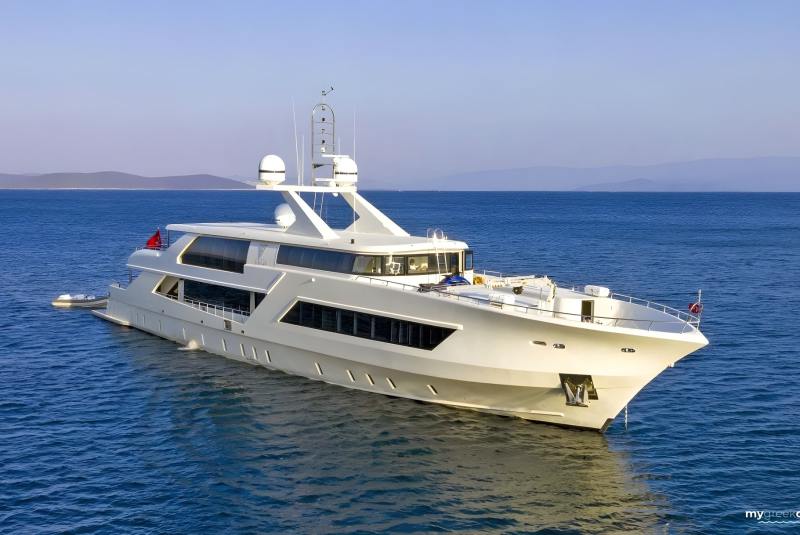 View Inquire  SECRET LIFE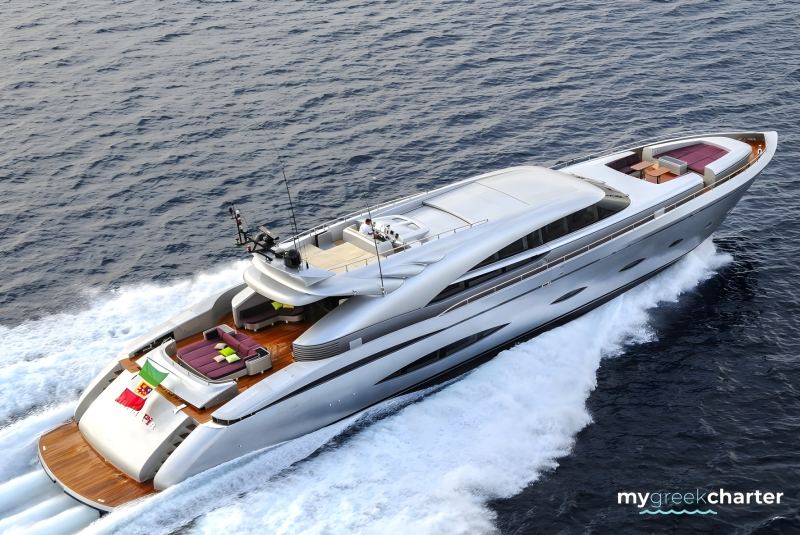 STELLA FIERA DOUCE FRANCE Yacht FilterFind me a yacht. Step 1 of 2  Use the form below to contact us!  EMBARK ON A JOURNEY OF SERENE ELEGANCEExperience luxury crusing in the athenian riviera and saronic gulf. We are a leading boat charter company based in the Athenian Riviera. Our exclusive services quarantee a unique experience at sea in the Saronic Gulf and Aegean sea. Whether it’s a leisurely family excursion, a getaway with friends or a bespoke event at sea, our meticulously curated services promise to exceed your expectations and create cherished memories.  DAY CHARTERSExperience Luxury Cruising in the Saronic Gulf and Aegean Sea. Glide through tranquil, secluded bays and immerse yourself in their pristine waters. Unwind with premium cocktails and gourmet snacks, or delight in freshly caught and served seafood in top local restaurants. Explore the majesty of Greek islands and experience serene elegance.  PRIVATE SEA TRANSFERSIndulge in the epitome of privacy and luxury with our private transfer service. Glide in unparalleled comfort and opulence aboard our brand new boats, meticulously designed to ensure a journey of supreme relaxation. Safety is our top priority.  EVENTS ONBOARDWhether you are orchestrating a lively soirée with esteemed guests, a birthday party, hosting a corporate event to impress clients, or commemorating a special occasion, our expert team is dedicated to ensuring it is nothing short of extraordinary. Get in touchD. Gounari, 227, Glyfada, 16674, GREECE
See you on board! © 2024 YachtsAthens.com. All Rights Reserved  Yachts for Sale Selling a Yacht Tenders & Toys Recent Sales 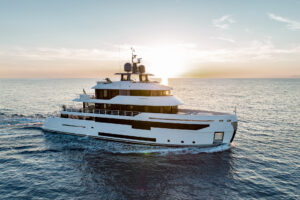 NEVER SAY NEVER AGAIN  Yachts for Charter Destinations Experiences Charter Management Charter Deals Yacht Marketing How to Charter 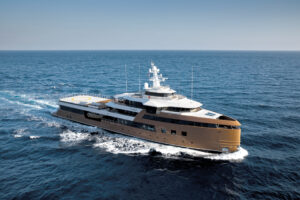 Superyacht Management Crew Structure Crew Management 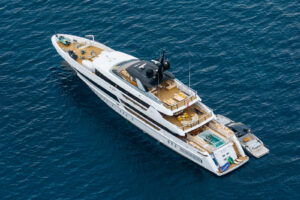 THE WELLESLEY Superyacht Construction New Yachts for Sale Yacht Design Yacht Shipyards Custom Construction Built on Trust 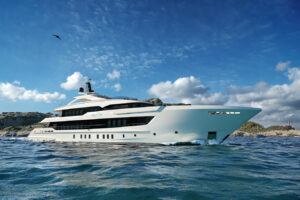 Heesen 55m Steel  Benetti Oasis Yacht Shows News & Blog  Athens Motor Yacht CharterMotor yachts for charter in athens. Browse a unique selection of Athens Motor Yacht Charters and embark on the most exclusive luxury retreat. The tranquillity of cruising, coupled with the warm crew’s services, gourmet cuisine, and tailored itineraries, encapsulates the essence of opulence that Athens is renowned for, creating unforgettable memories on the gentle Athens tides. 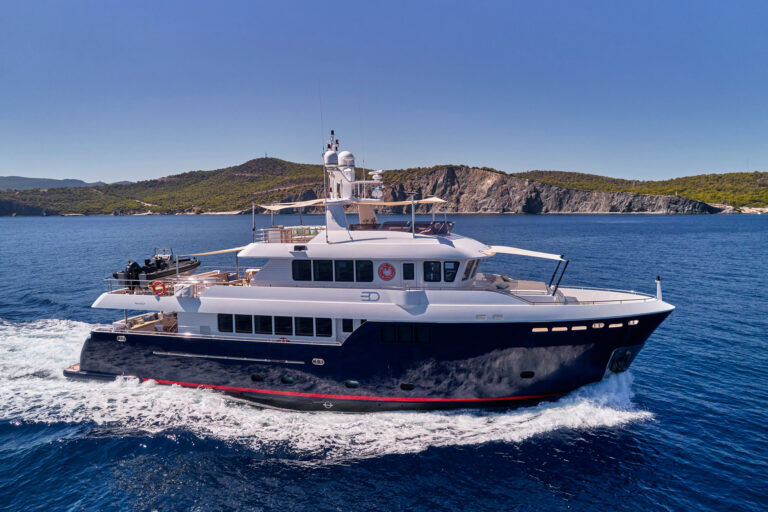 29.49m | Cantiere Delle Marche | 2013  33.5m | Eurocraft | 1992 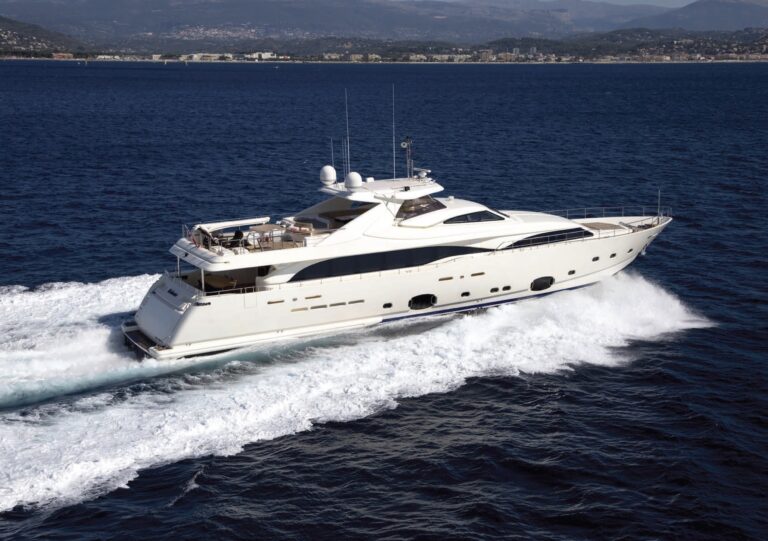 34.2m | Custom Line | 2009 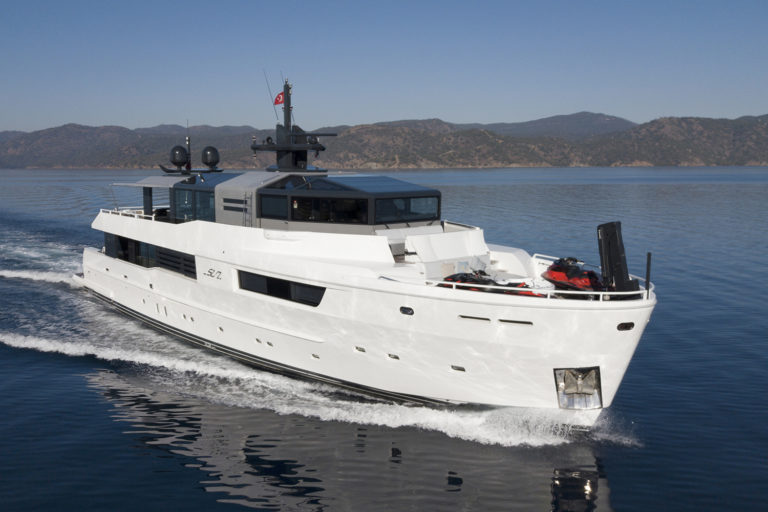 35m | Arcadia | 2012 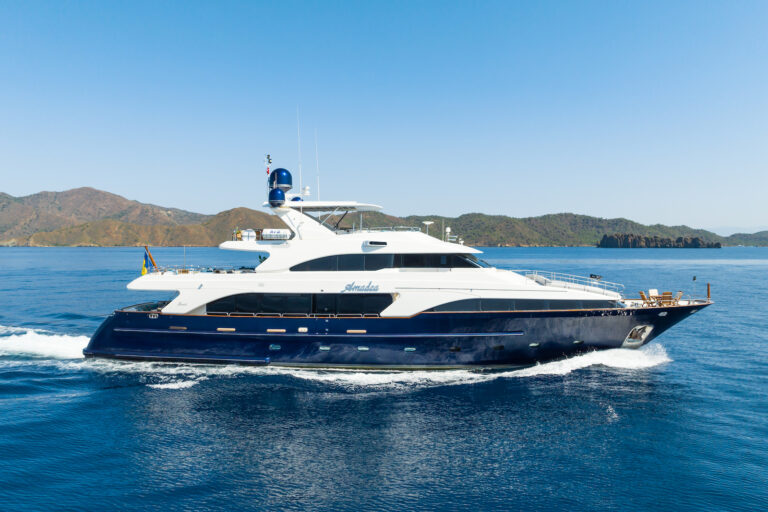 35m | Benetti | 1999 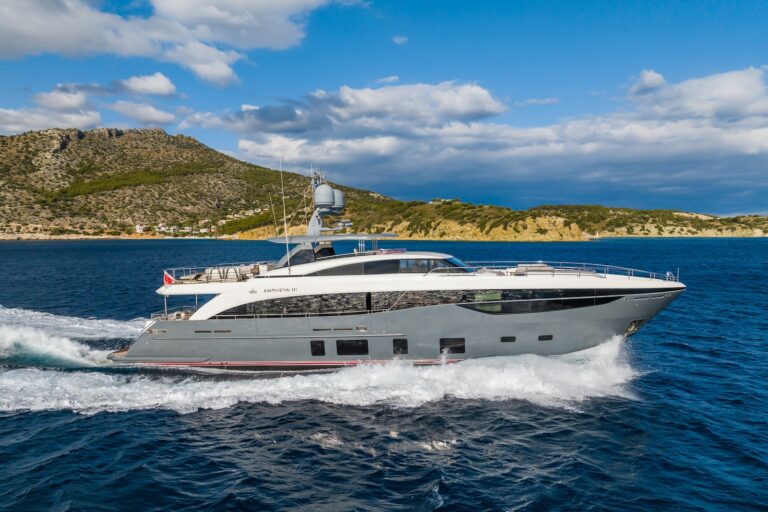 ANTHEYA III35.15m | Princess | 2015 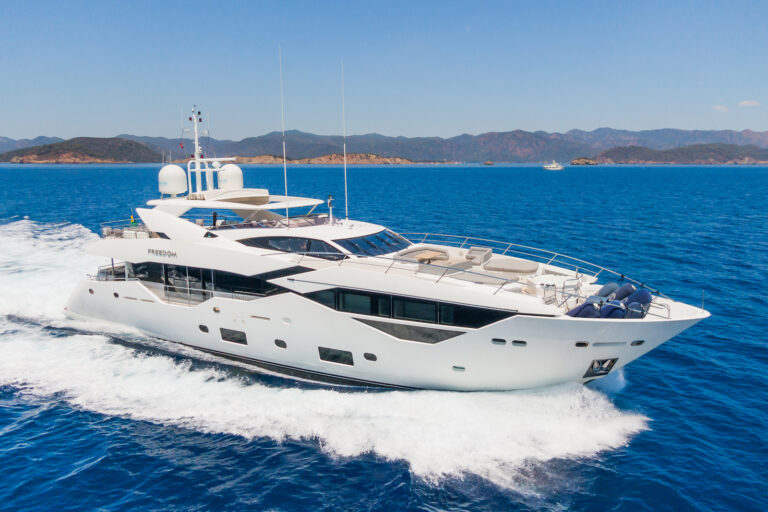 35.2m | Sunseeker | 2017 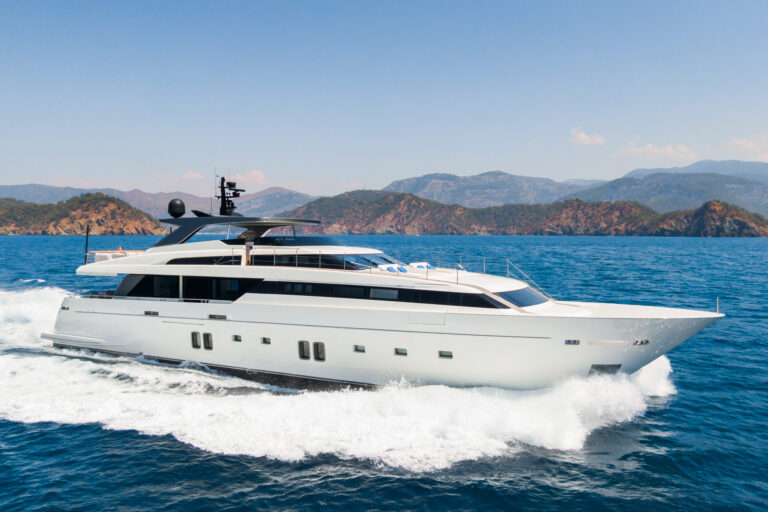 Morning Star36.5m | Sanlorenzo | 2018 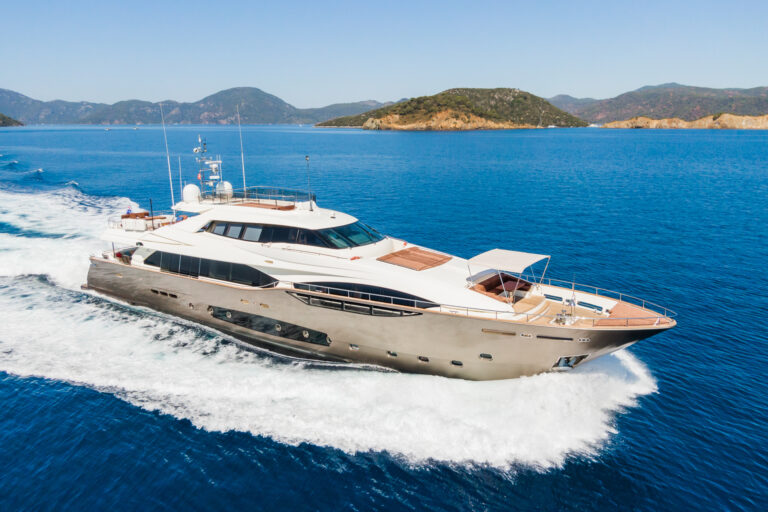 37.8m | Custom Line | 2012 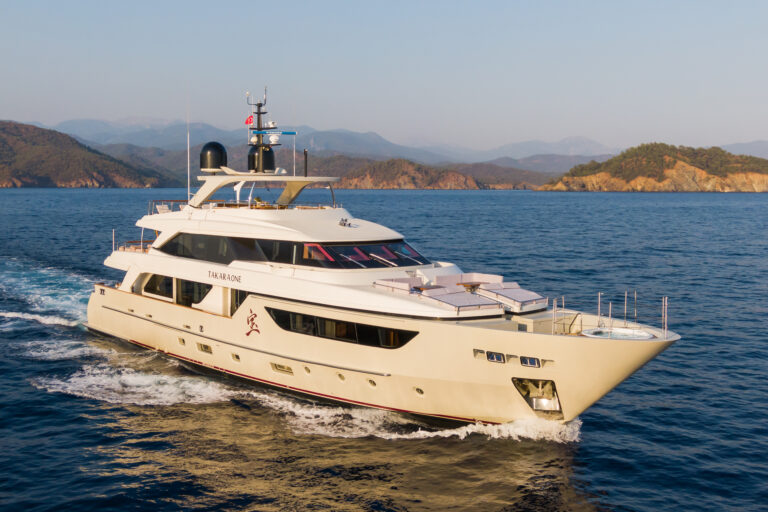 37.95m | Sanlorenzo | 2016 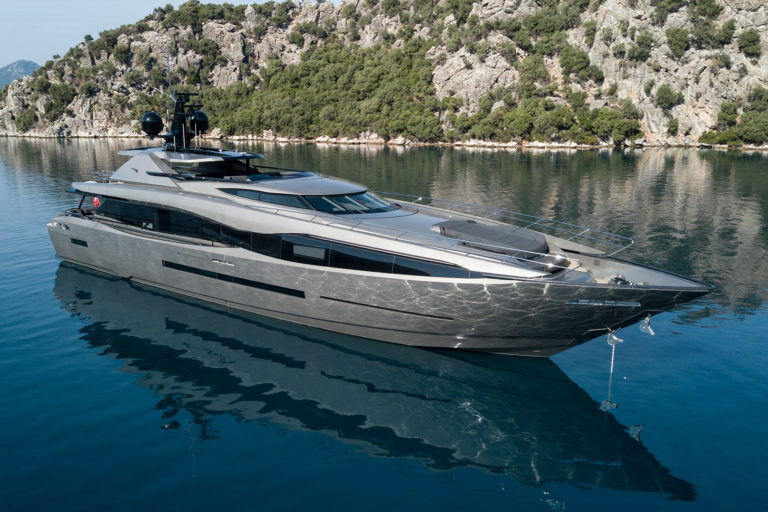 38m | Peri | 2016 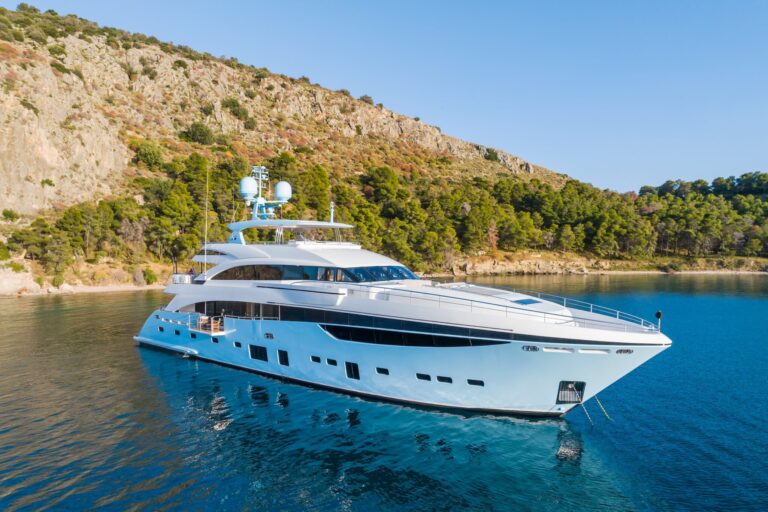 40m | Princess | 2016 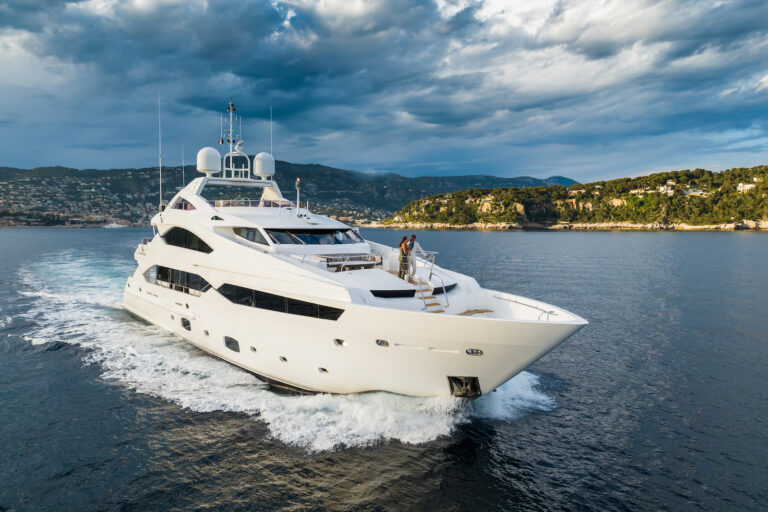 40.05m | Sunseeker | 2014  40.24m | Benetti | 2020  41.78m | Moonen | 2013 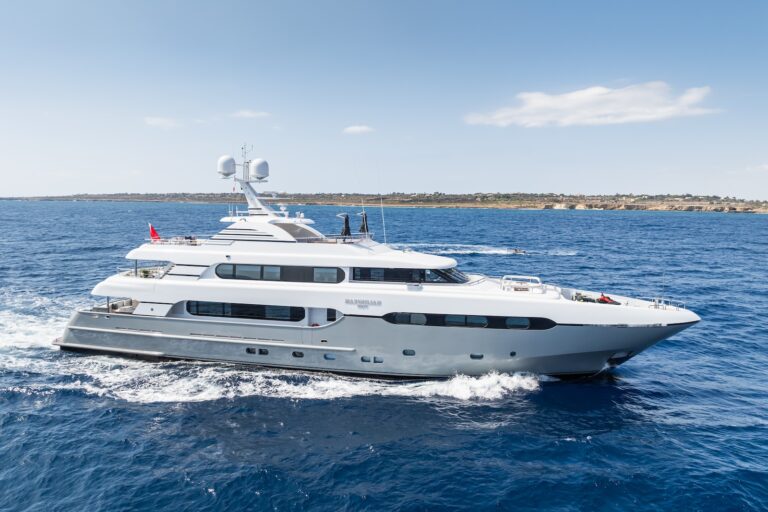 MAXIMILIAN MMIV45.02m | Sunrise | 2009 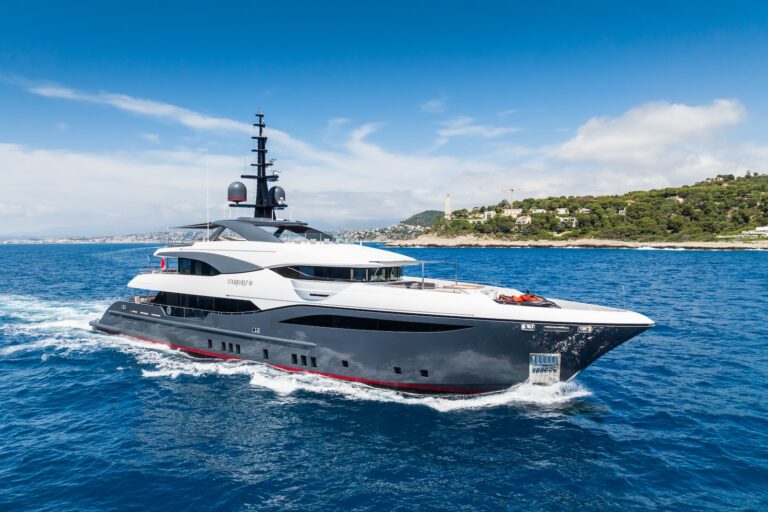 STARBURST III47.5m | Bilgin | 2017 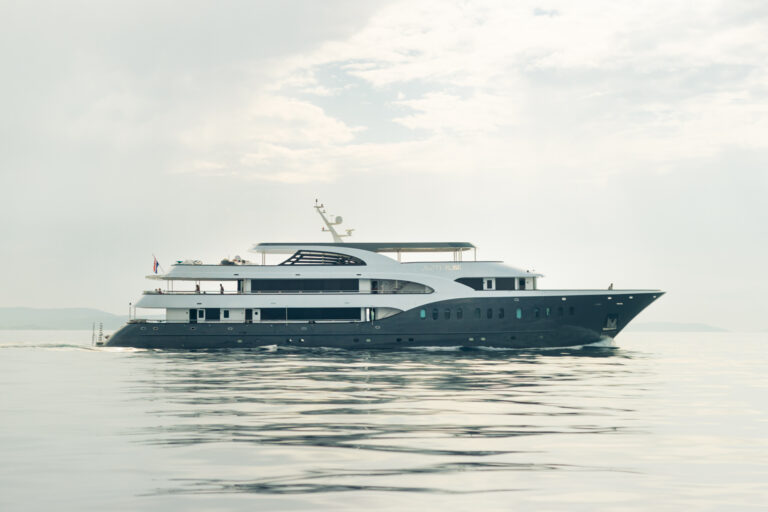 48.3m | Nauta Ltd, Croatia | 2017 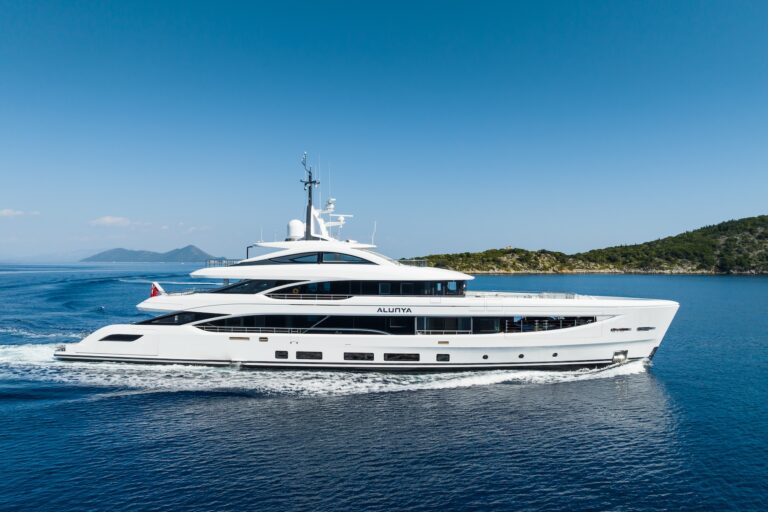 49.9m | Benetti | 2023  52.12m | Amels | 2004  53.28m | Radez d.d. | 2020  The Wellesley56.20m | Oceanco | 1993  60m | Brodosplit BSO d.o.o. | 2015 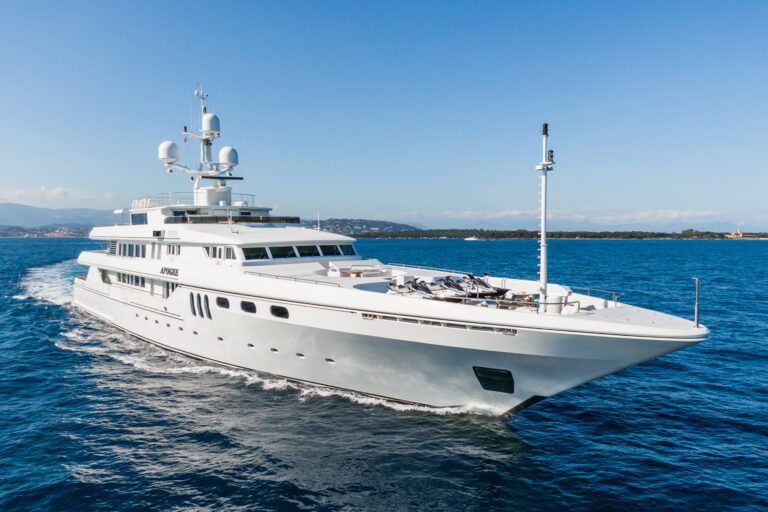 62.5m | Codecasa | 2003  20.2m | Azimut | 2017 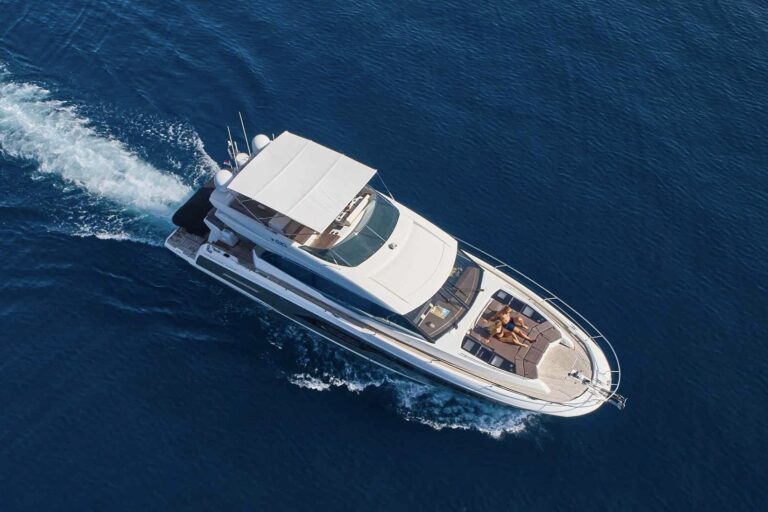 20.5m | Prestige | 2018  SUMMER THERAPY20.5m | Aicon | 2022 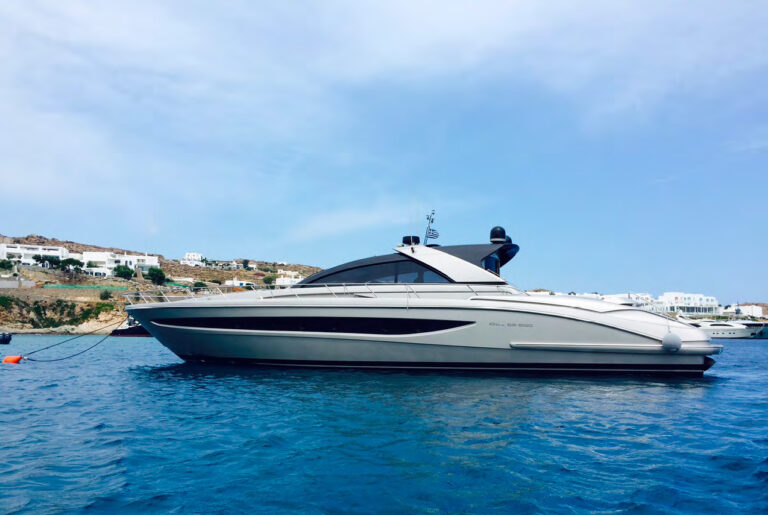 20.8m | Riva | 2005 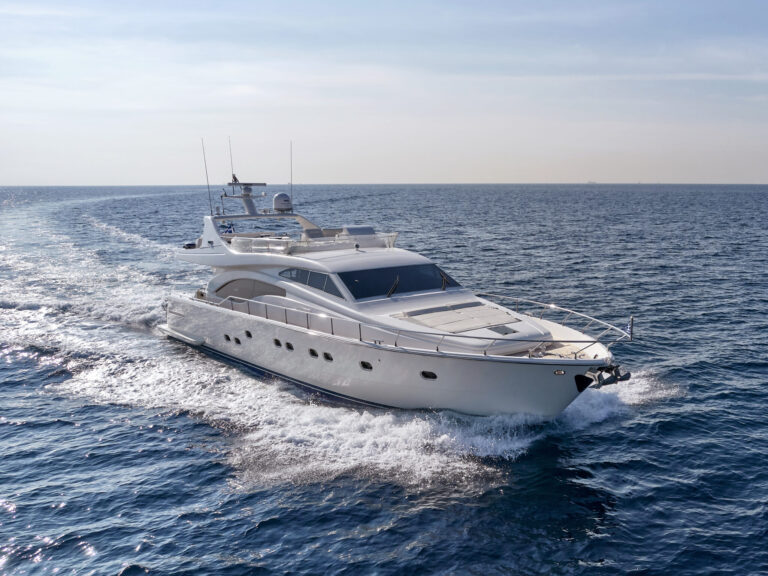 21.16m | Ferretti | 2001 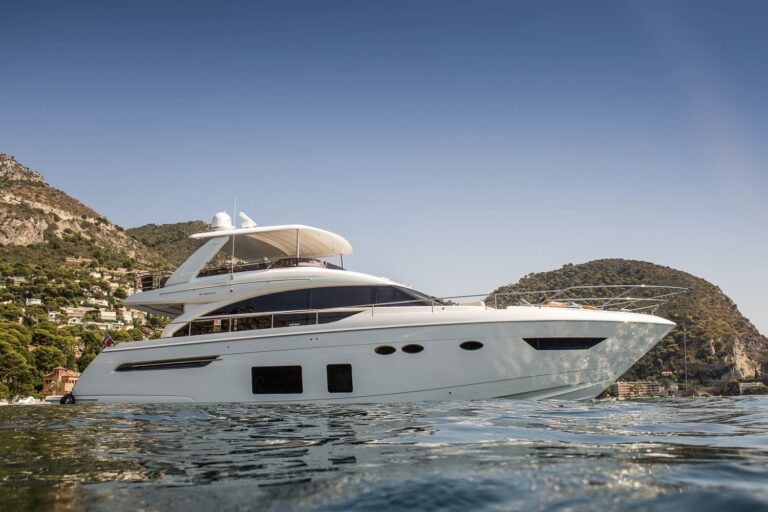 21.25m | Princess | 2016  21.34m | Sunreef Yachts | 2012  21.7m | Princess | 2007 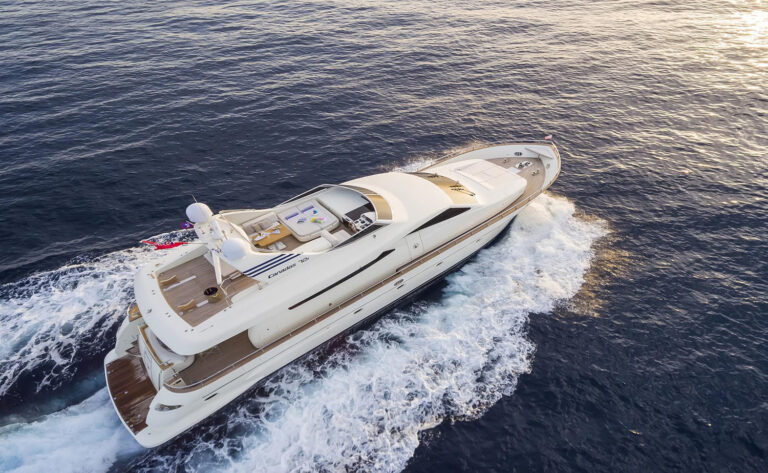 22.8m | Canados | 2004 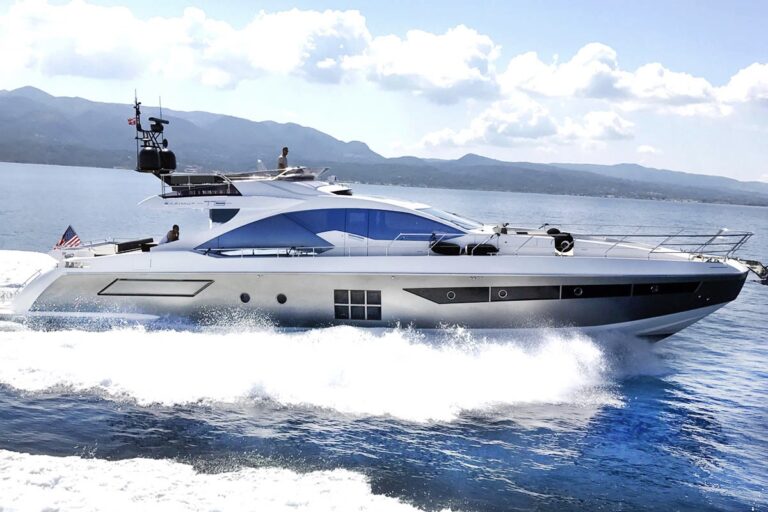 23.6m | Azimut | 2017 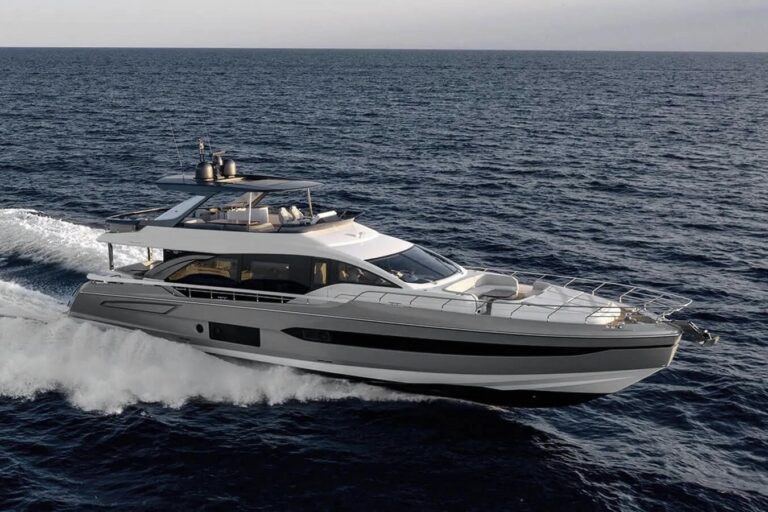 23.64m | Azimut | 2021  23.75m | Sanlorenzo | 2021 23.78m | Azimut | 2020 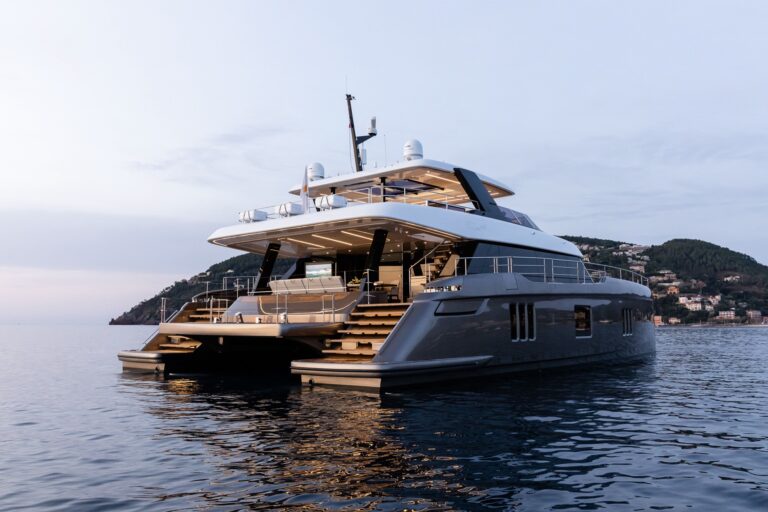 24m | Sunreef | 2021 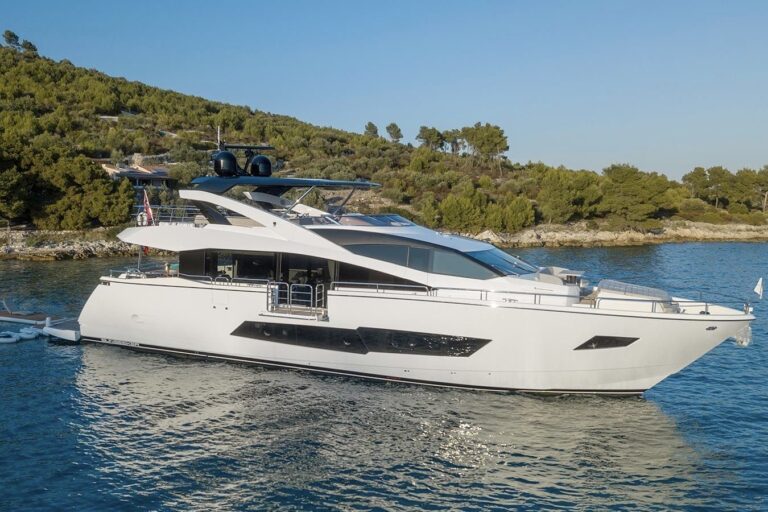 HUNKY DORY OF LONDON26.3m | Sunseeker | 2020 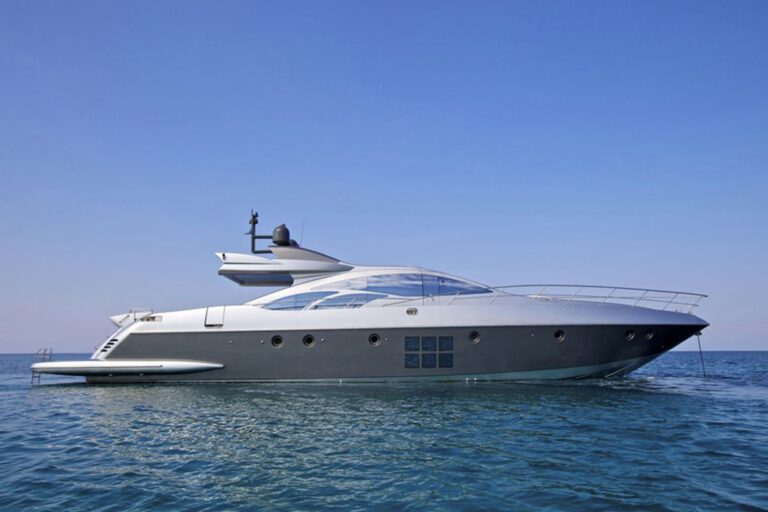 26.5m | Azimut | 2008 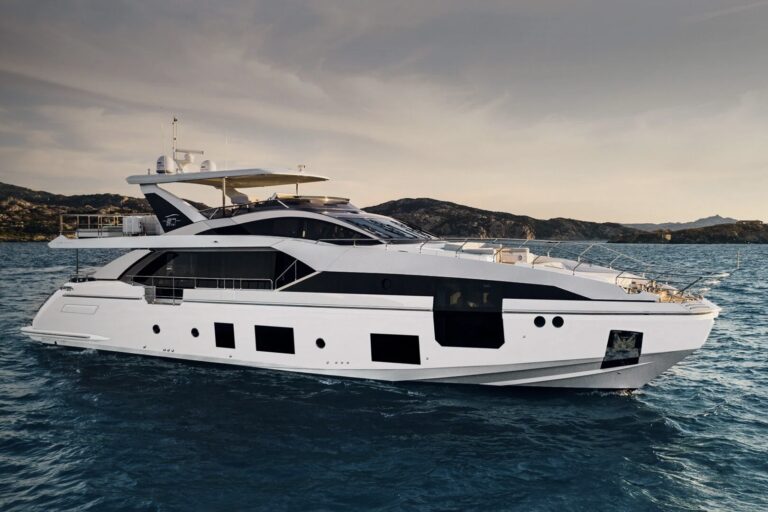 26.78m | Azimut | 2020 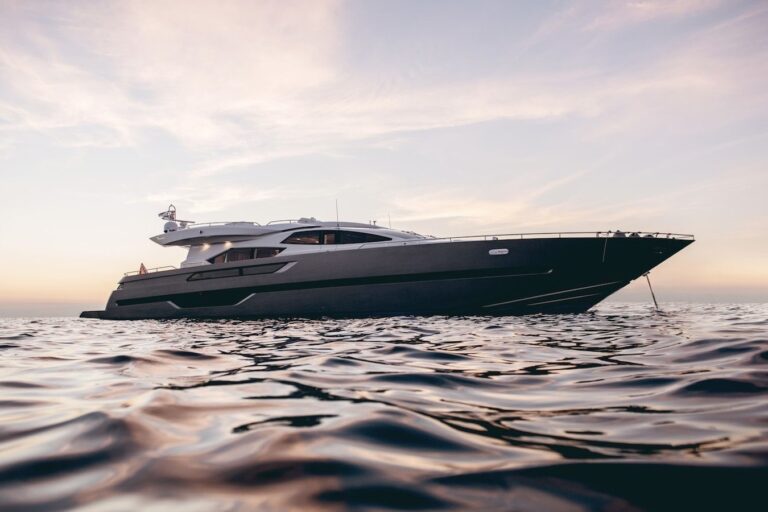 27.6m | Italcraft | 2009 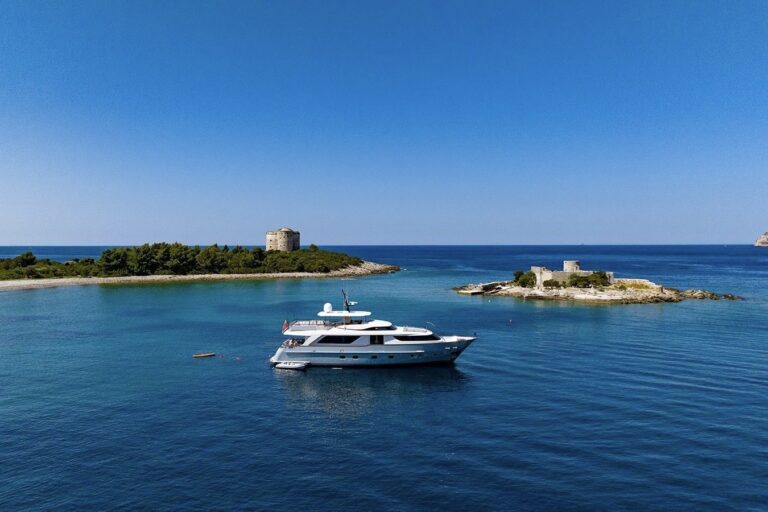 VALENTINA II27.6m | Sanlorenzo | 2011  27.96m | Pershing | 2012  28.4m | Custom Line | 2021 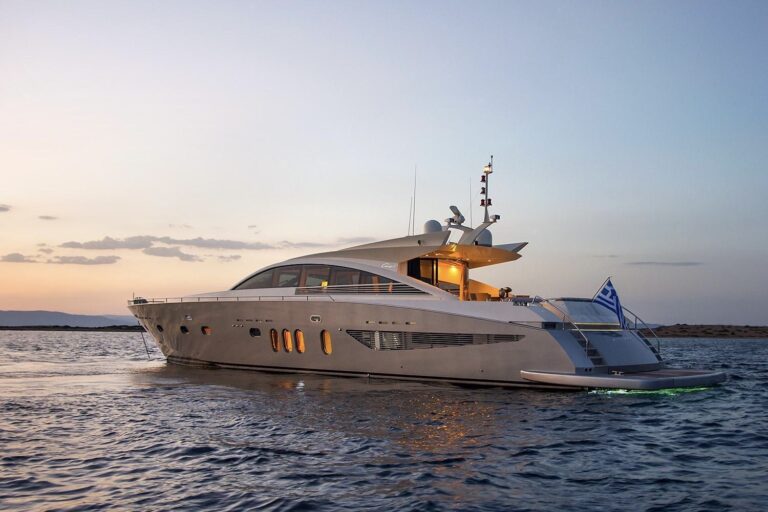 28.7m | Couach | 2009 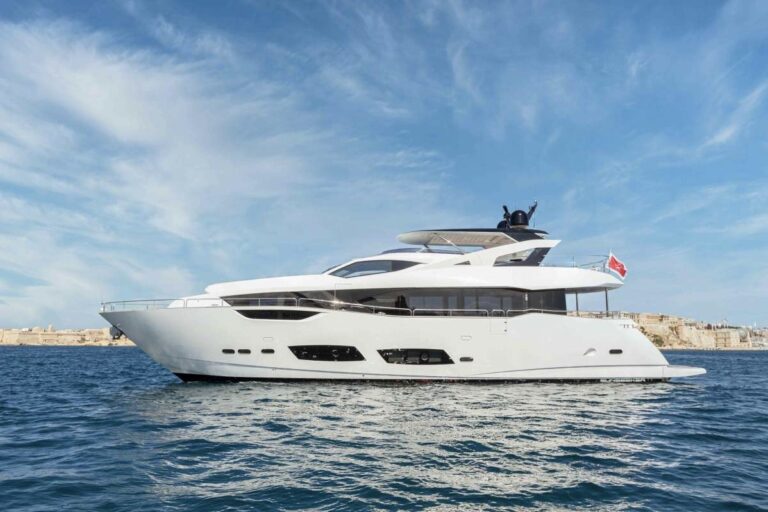 28.96m | Sunseeker | 2019  GEORGE FIVE29.26m | Sanlorenzo | 2017 Enquire On Athens Yacht CharterCONTACT OUR CHARTER BROKERS ABOUT CHARTERING IN THIS DESTINATION Other Destinations Florida Keys YACHTS FOR SALE YACHTS FOR CHARTER CHARTER MANAGEMENT +377 97 77 67 57 SEO by The Agency  Yachts for sale Selling a yacht Recent Sale Charter Guide Subscribe to our newsletter to receive our latest offers, news and the finest selection of superyachts.
39 Lagoon 2014 Boat For SaleAsking price: €295,000.
Last updated Aug 22, 2024 39' Lagoon 2014The 2014 Lagoon 39 is a spacious and versatile catamaran designed for both relaxation and performance. With its expansive decks, comfortable accommodations, and modern amenities, this vessel offers an exceptional cruising experience. Below deck, the four-cabin layout provides ample space for up to ten guests, while the twin electric heads ensure convenience and privacy. The Lagoon 39 is equipped with a battened mainsail and roller genoa, both replaced in 2021, ensuring efficient sailing performance. A pair of Yanmar 30hp engines provides reliable propulsion, while the hydraulic gangway and electric windlass make boarding and anchoring effortless. On-board amenities include a hot and cold deck shower, air conditioning, a sound system, and a spacious cockpit with a sofa for socializing. Recent upgrades, such as new batteries and a full engine service, demonstrate the owner's commitment to maintaining the vessel in top condition. With its combination of comfort, performance, and modern features, the Lagoon 39 is an ideal choice for those seeking a luxurious and enjoyable catamaran experience.
Location Athens, Greece Flag Greece VAT not paid Denison Yachting is pleased to assist you in the purchase of this vessel. This boat is centrally listed by LookBoat. Denison Yacht Sales offers the details of this yacht in good faith but can’t guarantee the accuracy of this information nor warrant the condition of this boat for sale. This yacht for sale is offered subject to prior sale, price change, or withdrawal from that yacht market without notice. She is offered as a convenience by this yacht broker to its clients and is not intended to convey direct representation of a specific yacht for sale. INQUIRE ABOUT 39' LAGOONHave questions about this yacht? Fill out the form below and our team of experts will contact you soon. Your privacy is important to us. Find out how we protect it. Privacy Policy  First-Time Buyer?Read our guide to learn the process for buying this 39' Lagoon 39' Lagoon HIGHLIGHTS
39' Lagoon additional information
Schedule a Tour of 39' LAGOONContact our team to schedule a private showing. SIMILAR YACHTS FOR SALE View All46' newton 2003, jacksonville, fl, us, 46' regal 2011, lantana, fl, us, whatever she wants, 46' cabo rico 2000, tracys landing, md, us, 46' malo 1999, seattle, wa, us, 46' carver 2002, rideau ferry, on, canada, 46' beneteau 2014, shelter bay, panama, 46' cal 1976, la paz, bcs, mexico, other lagoon yachts for sale view all, hearts of gold, 46' lagoon 2023, barcelona, es-b, spain, 56' lagoon 2015, fort lauderdale, fl, us, 42' lagoon 2007, cartagena, colombia, 38' lagoon 2002, rio dulce, guatemala, 62' lagoon 2011, cannes, france, athens, greece, 62' lagoon 2019, marina del rey, ca, us, lagoon yachts sales report, price watch. Love this yacht? Get notified on price reductions and other related updates. Our NewsletterStay informed on all things yachting, including notable sales, industry updates, events, and boating tips with our newsletters. catamarans NewsRead the latest catamarans news and stay up to date on related events. RELATED SERVICES LOGIN OR REGISTERHi, welcome back. Login and pick up from where you left off. Creating an account allows you to save and compare your favorite yachts. By creating an account you agree to the terms of use and our privacy policy. Please use a modern browser to view this website. Some elements might not work as expected when using Internet Explorer.

699 Crewed Luxury Yachts for Charter in Athens Athens Yacht ChartersConsidered the birthplace of Western civilization, Athens boasts some of the world’s finest examples of Hellenic architecture that bears witness to the ancient city’s golden age, dating back 2,500 years. However, the bustling cosmopolitan capital also offers a wealth of cool hangouts – from hip rooftop bars and chic restaurants to neighborhood tavernas and modern Greek bistros, all spilling out onto tree-studded pavements alive with warm chatter and a vibrant atmosphere, making this the perfect stop-off for a Greece yacht charter . Yacht Charters in AthensLocated on a peninsula surrounded by islands, Athens is the perfect place to kick start your crewed yacht vacation. Offering a wealth of ancient historical monuments, museums and a veritable patchwork of narrow streets, markets and sun-kissed piazzas, you’ll be spoiled for choice with so much to fit in. A trip to Greece's capital would not be complete without a visit to its famous Acropolis. Rising 500-feet above sea-level, access to this majestic UNESCO Heritage Site is found via a winding path on its southern flank that leads up to the majestic Doric-columned oblong temple, home to Athens' crowning glory; the Parthenon . Other highlights include Lycabettus Hill, one of the highest peaks in Athens offering sweeping views of the city and beyond, complete with its own open-air theater, as well as the Cine Paris – an outdoor cinema with glorious views over the Acropolis. For beautiful sunset views, head to the Temple of Poseidon, a striking series of towering columns that stand 60 meters above sea level against the backdrop of the glittering Saronic Gulf. Another must-visit is Athens’ Plaka neighborhood, stretching out under the shadow of the Acropolis it plays host to a wealth of ancient sites, museums, historic churches and picturesque piazzas with bustling cafes and restaurants. Charter Itineraries in AthensA Greece luxury yacht itinerary can commence in the capital city of Athens and incorporate the beautiful Saronic Islands , Peloponnesus or, slightly further afield, the ever-popular Cyclades archipelago , home to the celebrated islands of Santorini and Mykonos . With countless beautiful islands on its doorstep, yacht charter itinerary options from Athens are bountiful. Offering excellent transport links – including a nearby International Airport – long summer season tempered by fresh northeasterly breezes, deeply rich cultural heritage and close proximity to a trove of idyllic islands, Athens is the perfect base for yacht charters . Chartering a Private Yacht in AthensFor more information about renting a private luxury charter yacht in Athens please contact your preferred Yacht Charter Broker who can help you plan your dream itinerary, combining your party's needs with advice about the best time to visit. Crewed Charter Yachts in Athens
Image View Options Length Options Currency Options Sort Search
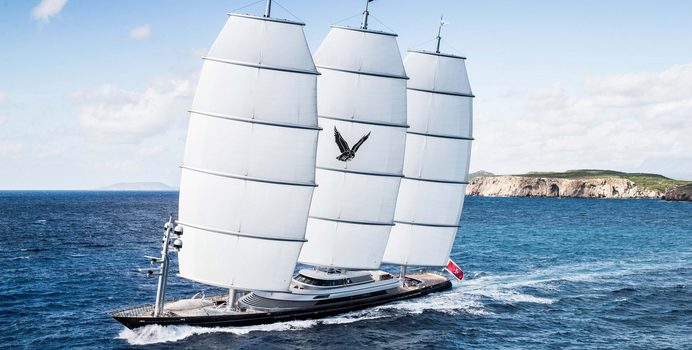 Maltese Falcon88m Perini Navi from $490,000 p/week 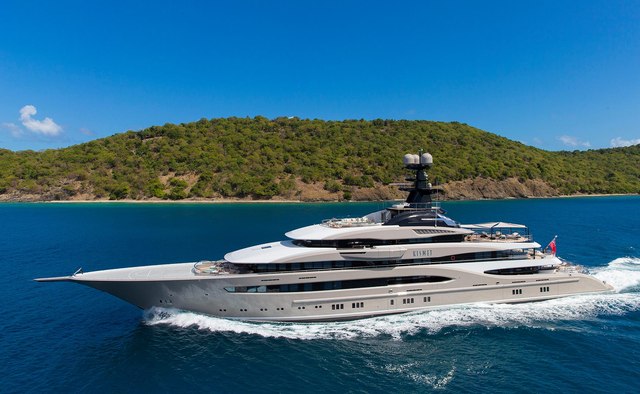 122m Lurssen 122m 2024 from $3,000,000 p/w eek 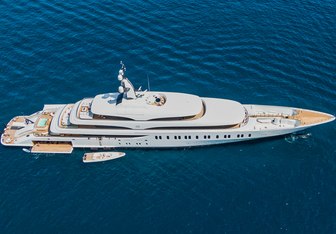 108m Benetti 108m 2019 from $2,001,000 p/w eek ♦︎ 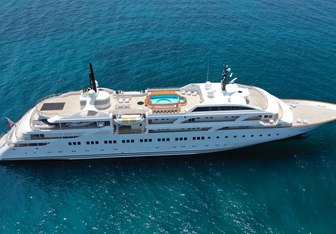 107m Olympic Yacht Services 107m 1997/2022 from $2,223,000 p/w eek ♦︎  Christina O 3499m Canadian Vickers 99m 1943/2020 from $778,000 p/w eek ♦︎ 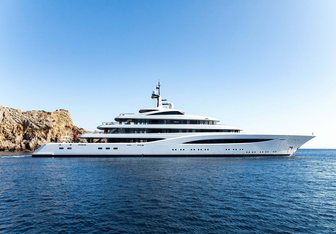 97m Feadship 97m 2017/2022 from $1,778,000 p/w eek ♦︎ 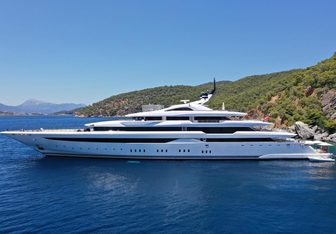 95m Golden Yachts from $1,190,000 p/w eek ♦︎  95m Lurssen from $1,334,000 p/w eek ♦︎ 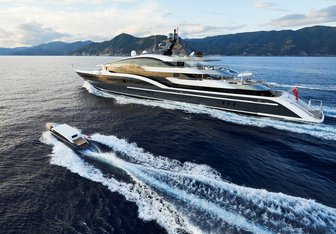 90m Oceanco 90m 2018/2024  Lauren L 3690m Cassens-Werft 90m 2002/2008 from $750,000 p/w eek ♦︎ *  Maltese Falcon 1288m Perini Navi 88m 2006/2023 from $490,000 p/w eek 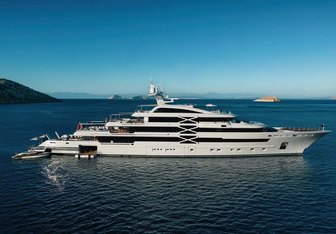 Project X 1288m Golden Yachts from $1,223,000 p/w eek ♦︎  86m Scheepswerf Gebr. van der Werf 86m 1998/2024 from $531,000 p/w eek ♦︎  86m Oceanco 86m 2010/2018 from $1,278,000 p/w eek ♦︎ 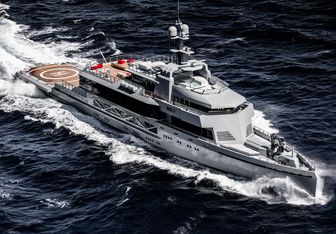 85m SilverYachts from $973,000 p/w eek ♦︎ 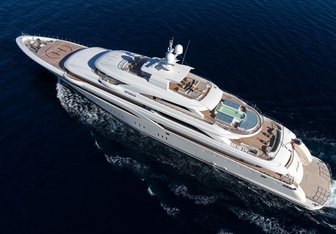 O'Ptasia 1285m Golden Yachts 85m 2018/2024 from $1,000,000 p/w eek ♦︎ 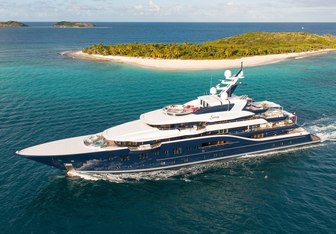 Solandge 1285m Lurssen 85m 2013/2022 from $1,111,000 p/w eek ♦︎ 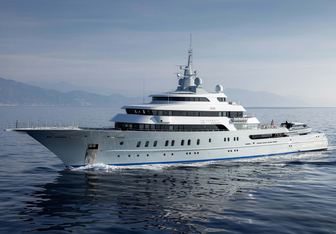 Victorious 1285m Ak Yachts from $889,000 p/w eek ♦︎  Le Ponant 3284m 1990/2022 from $506,000 p/w eek ♦︎ 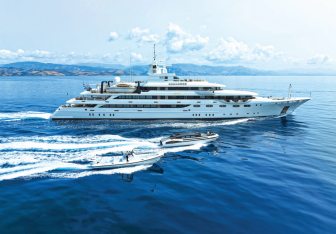 83m Golden Yachts 83m 2004/2022 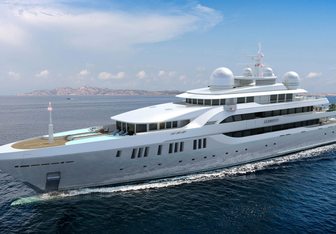 Elements 1280m Yachtley 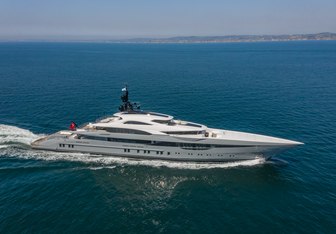 80m Bilgin Yachts from $861,000 p/w eek ♦︎ 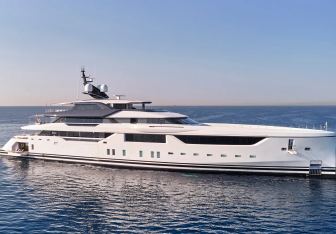 78m Golden Yachts 78m 2023/2024 from $811,000 p/w eek ♦︎  77m IHC Verschure 77m 1974/2019 from $661,000 p/w eek ♦︎ 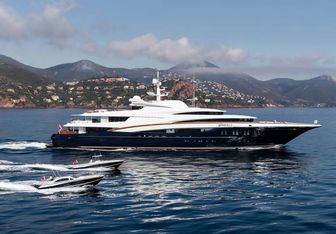 76m Oceanco 76m 2008/2019 from $878,000 p/w eek ♦︎ 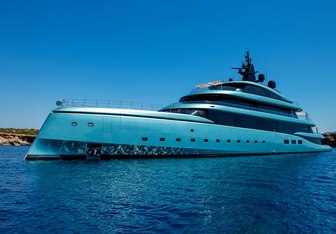 75m Admiral Yachts 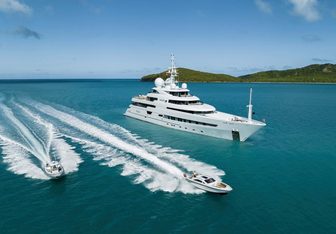 74m Freire Shipyard 74m 2011/2014 from $595,000 p/w eek  Lady Vera 1274m Nobiskrug 74m 2011/2023 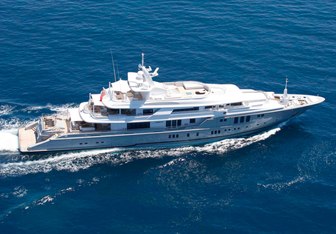 74m 2008/2013 from $561,000 p/w eek ♦︎ 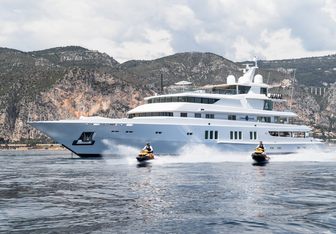 Coral Ocean 1273m Lurssen 73m 1994/2022 from $724,000 p/w eek ♦︎  Elegant 007 3072m Lamda Nafs Shipyards 72m 2005/2017 from $563,000 p/w eek ♦︎ 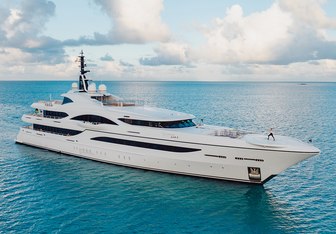 Quantum of Solace 1273m Turquoise Yachts 73m 2012/2022 from $574,000 p/w eek 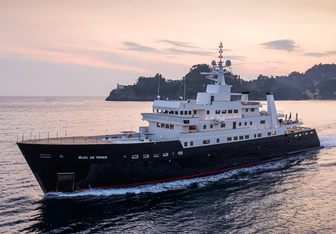 Bleu De Nimes 2872m Clelands Shipbuilding Co 72m 1980/2020 from $545,000 p/w eek ♦︎ 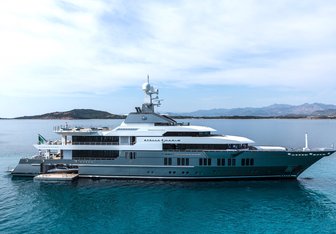 Stella Maris 1272m Viareggio SuperYachts 72m 2015/2018 from $650,000 p/w eek 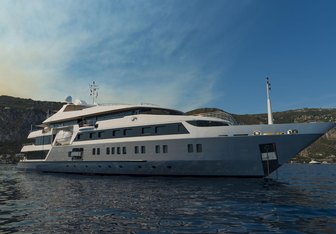 Serenity 2872m 2004/2017 from $611,000 p/w eek ♦︎  Force Blue 1271m Royal Denship 71m 2002/2022 from $400,000 p/w eek ♦︎ 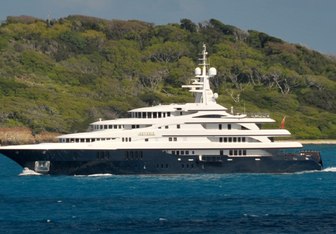 70m Benetti 70m 2000/2016 from $500,000 p/w eek * 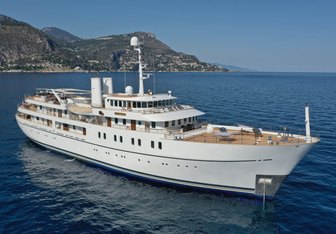 Sherakhan 2670m Vuijk Scheepswerven 70m 2005/2022 from $594,000 p/w eek ♦︎ 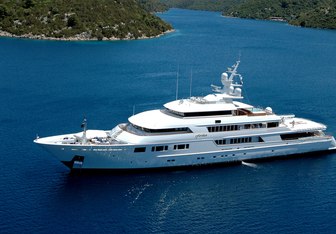 69m Oceanfast 69m 2003/2020 from $423,000 p/w eek ♦︎ 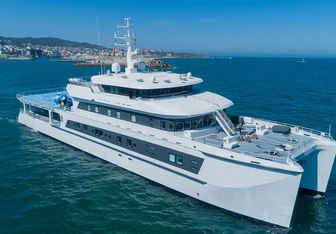 Wayfinder 1268m Astilleros Armon from $375,000 p/w eek 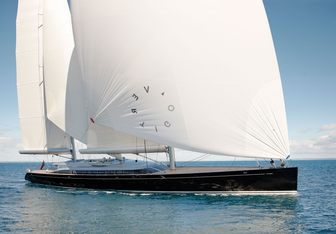 67m Alloy Yachts 67m 2011/2019 from $361,000 p/w eek ♦︎  67m Shadow Marine 67m 2007/2008 from $120,000 p/w eek 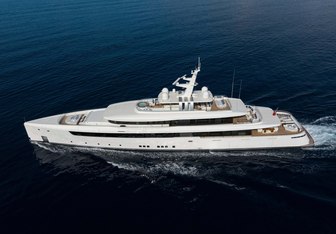 66m Rossinavi from $637,000 p/w eek * 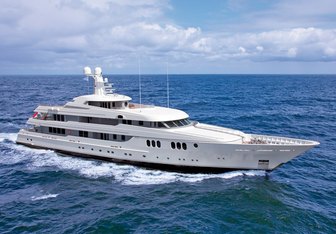 65m Feadship from $556,000 p/w eek ♦︎ 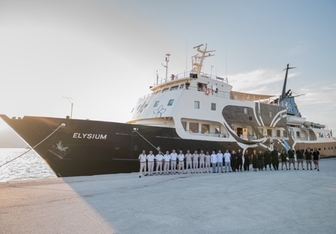 64m Astilleros de Mallorca 64m 1999/2021 from $181,000 p/w eek ♦︎  Running On Waves 4264m Segel Masten Yachten 64m 2011/2021 from $117,000 p/w eek ♦︎ 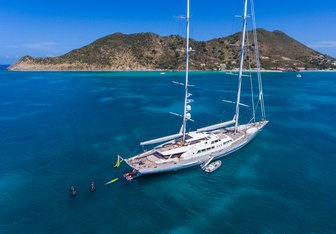 Spirit of the C's 1064m Perini Navi 64m 2003/2023 from $225,000 p/w eek  Isabell Princess of The Sea 1264m Codecasa 64m 1990/2023 from $322,000 p/w eek ♦︎ 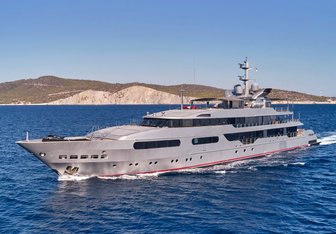 Magna Grecia 1264m Elsflether Werft 64m 1986/2021 from $366,000 p/w eek ♦︎ 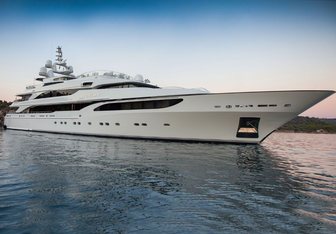 Lioness V 1264m Benetti 64m 2006/2023 from $500,000 p/w eek ♦︎  63m Sunrise Yachts 63m 2015/2023 from $511,000 p/w eek ♦︎ 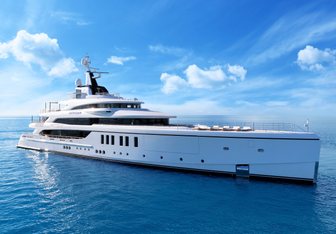 63m Benetti 63m 2019/2022 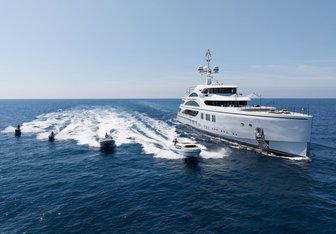 Soundwave 12from $722,000 p/w eek ♦︎ 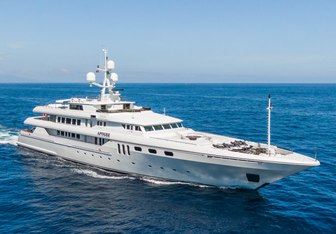 63m Codecasa 63m 2003/2023 from $360,000 p/w eek 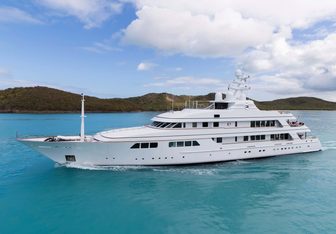 62m Feadship 62m 2000/2022 from $409,000 p/w eek ♦︎ 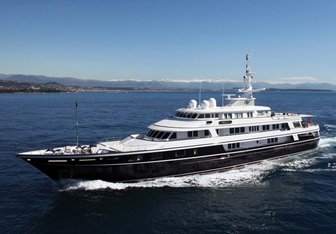 Virginian 1262m 1990/2024 from $272,000 p/w eek ♦︎ 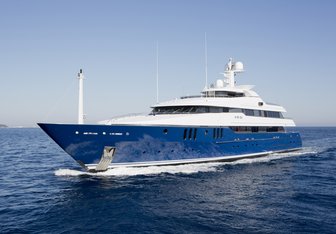 62m 2002/2016 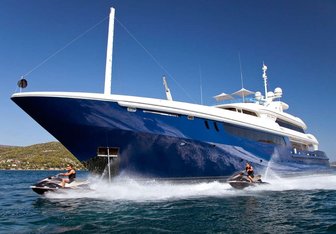 Mary-Jean II 1262m 2010/2023 from $320,000 p/w eek 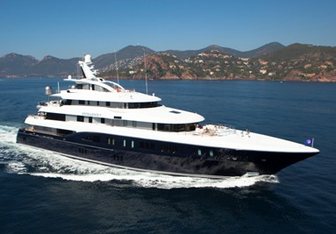 61m Abeking & Rasmussen 61m 2012/2022 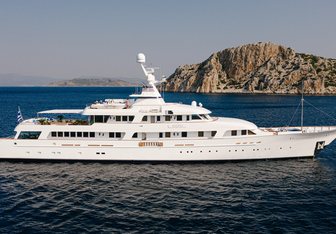 61m Dauphin Yachts 61m 1987/2023 from $222,000 p/w eek ♦︎ 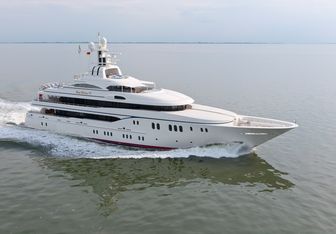 Lady Kathryn V 1261m Lurssen from $450,000 p/w eek 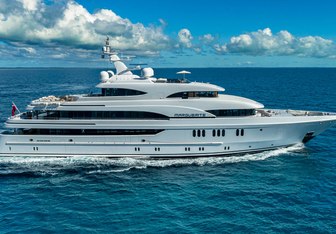 Marguerite 1261m 2004/2021  Bella Vita 1260m Lurssen 60m 2010/2024 from $550,000 p/w eek 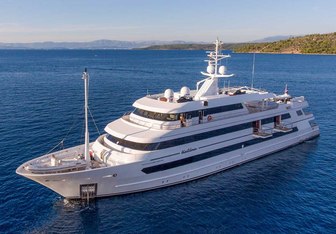 60m Brodosplit 60m 2015/2017 from $245,000 p/w eek 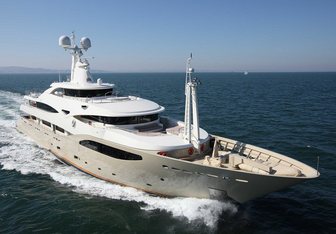 Light Holic 1260m 2011/2014 from $356,000 p/w eek ♦︎ Book with Ease - Speak with a Charter Expert Our charter experts will:
Enquire now for yacht availability & free consultation. Crewed Luxury Yachts in AthensAthens Yacht Search:
Yacht Amenities  As Featured In The YachtCharterFleet Difference YachtCharterFleet makes it easy to find the yacht charter vacation that is right for you. We combine thousands of yacht listings with local destination information, sample itineraries and experiences to deliver the world's most comprehensive yacht charter website. San Francisco
Popular Destinations & Events
Featured Charter Yachts
Receive our latest offers, trends and stories direct to your inbox. Please enter a valid e-mail. Thanks for subscribing. Search for Yachts, Destinations, Events, News... everything related to Luxury Yachts for Charter. Yachts in your shortlist  Mykonos Easy YachtingBegin a journey full of comfort and luxury. A lifetime experience.  Destinations 
SAILING HOLIDAYS ATHENSA yacht owner's guide to sailing athens, greece. Athens, Greece’s timeless treasure, seamlessly blends ancient heritage with modern vibrancy. Explore historic landmarks like the Acropolis, then dive into the city’s dynamic nightlife and culinary scene. A journey through time awaits in this captivating metropolis. Book your dream sailing holidays around Athens and Saronic Islands with IonianCatamarans.com.
Sail in Athens with your favorite boat type.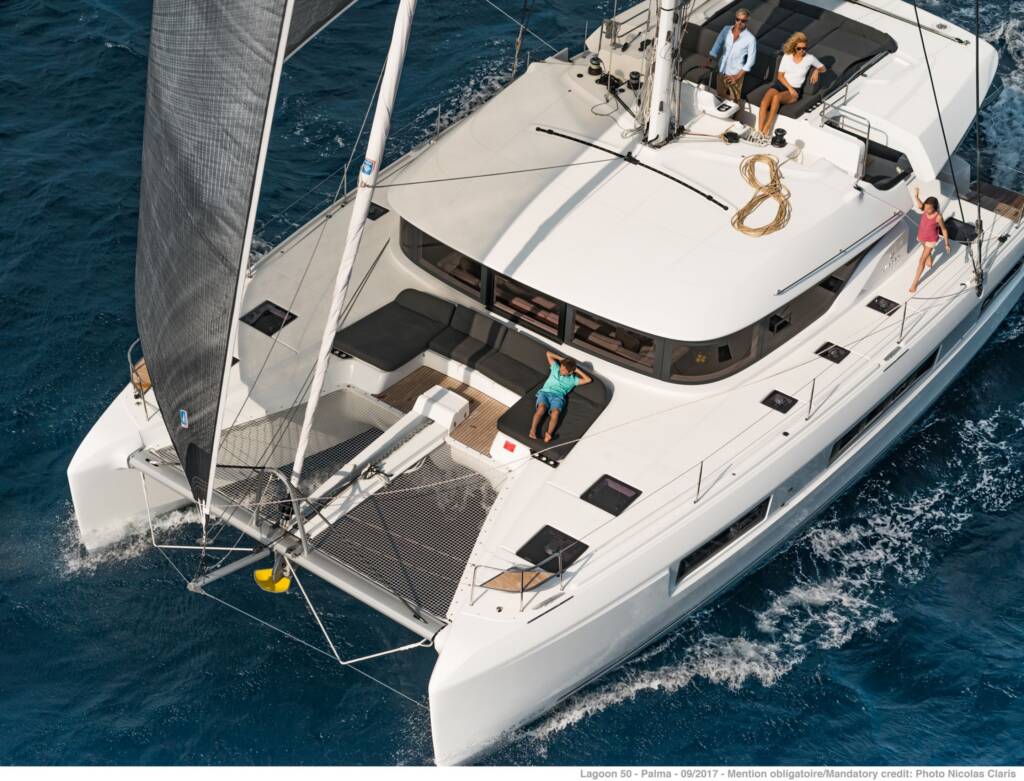 Yacht charter in Athens, GreeceHandpicked affordable, luxury yacht rentals in athens.. 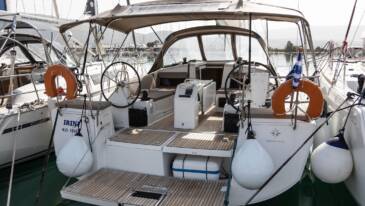 Sailing itineraries from Athens suggested by yacht charter experts.1 week route a. 1 WEEK – Sailing Itinerary from AthensDay 1 athens to aegina island.
Day 2 Aegina to Poros.
Day 3 Poros to Hydra
Day 4 Hydra to Spetses
Day 5 Spetses to Ermioni
Day 6 Ermioni to Epidaurus
Day 7 Epidaurus to Athens
2 Week Route B2 WEEK – Sailing Itinerary from AthensExtend your adventure by exploring more of the Saronic Gulf and Cyclades islands. You can follow the 1-week itinerary and add the following: Day 8 Athens to KythnosSail to Kythnos, a tranquil island with beautiful beaches and traditional villages. Day 9-14: Explore the Cyclades
3 Weeks Route3 WEEK – Sailing Itinerary from AthensFor an even more extended adventure, you can explore a wider range of islands in the Aegean Sea. Follow the 2-week itinerary and add the following: Day 15-21: Explore More Islands
Alimos MarinaAthens Weather ForecastAthens sailing holidays: popular questions answered., how much is it to charter a yacht in athens. The cost of chartering a yacht in Athens can vary widely depending on factors such as the type of yacht, its size, age, and the duration of the charter. On average, you can expect to pay anywhere from €1,500 to €10,000 or more per week for a yacht charter in Athens. Is Athens good for sailing?Yes, Athens is an excellent destination for sailing. It offers a variety of sailing routes, calm waters, beautiful islands, historic sites, and a vibrant culture. The Saronic Gulf and nearby Cyclades islands provide numerous sailing opportunities with diverse experiences. What is the best month to sail in Athens?The best months for sailing in Athens are typically May to September. During this period, the weather is warm, and the sea conditions are generally calm, making it ideal for sailing and enjoying the Greek islands. What qualifications do you need to sail in Athens, Greece?To charter a yacht in Greece, you will need to have a recognized sailing qualification, such as an International Certificate of Competence (ICC) or a relevant skipper’s license. Additionally, knowledge of local regulations and navigation is essential. Is the sea in Athens warm?Yes, the sea in Athens is warm and pleasant for swimming and sailing during the summer months, with water temperatures ranging from 22°C (72°F) in May to 26°C (79°F) in August. What sea is Athens in?Athens is located along the coastline of the Aegean Sea, specifically in the Saronic Gulf region. How long should an Athens sailing holiday be?The duration of an Athens sailing holiday can vary based on personal preferences and the number of islands you want to visit. A one-week sailing trip is common for exploring the Saronic Gulf, while two to three weeks are recommended for more extensive island-hopping adventures. When does the sailing season in Athens start and end?The sailing season in Athens typically starts in late April or early May and continues through September or early October. May to September is the prime sailing season with the best weather conditions. Why visit Athens?Athens is a historical and cultural gem, offering iconic ancient sites such as the Acropolis, world-class museums, vibrant neighborhoods, delicious Greek cuisine, and easy access to beautiful islands. It’s a destination that combines rich history with modern vitality. Which is the closest island to Athens?The closest island to Athens is Aegina, located in the Saronic Gulf. It’s just a short sail from the Athens coast and offers a taste of Greek island life within easy reach of the mainland. Talk with Vassia, our Yacht Charter Specialist.Ultimate privacy, luxury & freedom. Book your sailing holidays with #1 yacht owner in the Ionian Sea since 2000. Plan with your dream yacht charter holidays with a dedicated yacht charter advisor.  6 REASONS TO CHOOSE US.Other sailing destinations you may like in greece..  Sailing Holidays in AthensSailing holidays in Athens offer a perfect blend of cultural exploration and island-hopping adventures. Here’s what you need to know:
History of AthensAthens is steeped in history and is often regarded as the birthplace of Western civilization. Key historical highlights include:
Ports and Local AmenitiesAthens boasts several ports and marinas that cater to sailors:
Tailor-made Yacht Holidays. Book with #1 yacht owner in the Athens, GreeceIonian Catamarans © 2022-2024 All Rights Reserved  Yacht Charters in Athens At Sail Greece Yachts we are dedicated to providing a truly personal sailing holiday. We offer friendly service, advice and guidance on suggested routes to all our customers along with a relaxed check in/out process and of course reasonable charter prices, simply contact us to get started ! Sail Greece owns all the boats that we charter and we keep them in fantastic condition. First time sailing in Greece?For our new vistors, we suggest starting by browsing our yachts for charter or checking out our suggested sailing routes . If you know which boat you are interested in chartering, you may make a request using our charter form . If you would like guidance on which yacht is best for your needs or which route and islands we would suggest to visit then feel free to ask for more information using our general contact form . With Sail Greece you can rely on competitive charter prices and will enjoy the best possible support! Why charter with Sail Greece Yachts?Sail Greece Yachts was founded in 1985 by two close friends who love sailing, Giannis Makridakis and Vassilis Patiniotis . We try to think like customers and we care about making friends that enjoy sailing rather than clients. We charter our own privately owned sailing yachts without any commission so you can rely on reasonable rental prices and immediate and personal support . We are proud to have happy customers in most countries of the world and are even more proud that many are willing to provide personal recommendations to those thinking about using our boats. We invite you to have a look at our testimonials and we will be happy to provide a personal contact in your country who will be happy to testify to our services! Sailing Charters to the Greek IslandsGreece is home to over 1400 islands running from isolated islets to some of the most famous islands in the world (Santorini or Mykonos anyone?). No matter what your tastes run to: secluded beaches, nightlife and culture, archaeological and historical sites… or a combination of everything together, you will find a suitable island in Greece. We guarantee, if you like sailing, you are going to love sailing in Greece! One of the great advantages of sailing in Greece is the small distances between many of the islands. If you have a week (or even a weekend!) you may easily visit islands in the Saronic Gulf or the Cyclades from Athens. If you have longer than a week then take your time and relax, exploring your chosen islands in greater detail, or visit more islands to tick them off your holiday checklist! For more information we invite you to browse our suggested sailing routes with details on popular island itineraries and sailing distances. For the more practically minded bareboat sailors, the fantastic Greek Cruisers Wiki offers many details on sailing in Greece and the marinas and facilities available on various islands. Crewed Yacht ChartersSail Greece is pleased to offer fully crewed charters upon request. With our crewed charters your boat comes with a crew to sail your boat and a hostess to prepare your meals on board. The safety and management of the boat is the responsibility of your captain while day to day shopping and preparation of the meals is the duty of your hostess. You simply sit back and enjoy your stress free and relaxing sailing vacation in Greece! Contact us for more details. Sail Greece Yacht Charters Our Boats for Hire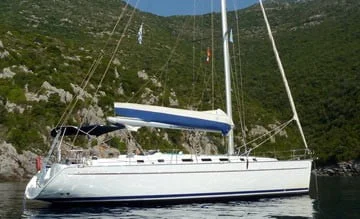 TestimonialsOutstanding service and very reasonable prices. There is no reason to try out any other charter company in Greece! Our trips with Sail Greece have been fantastic!!! I highly reccommend Sail Greece to those who want to experience sailing in Greece. If you are thinking about using Sail Greece I could not recommend them highly enough. You can immediately see the care and attention to detail that The Sail Greece crew take with their boats. We had a wonderful trip thanks to you, Tomas and the rest of the crew. I fully recommend Giannis and Sail Greece as good partners for smooth sailing! Bareboat or Skippered?We offer both bareboat and skippered yacht charters depending on the need of each client and group. Bareboat yacht charters require at least one member of the rental party to have a valid International Certificate of Competence or a national equivalent. If you are new to sailing or want to kick back and relax, we work with a select group of skippers who will be happy to show you the best of the Greek islands no matter what your taste!
 Book with us
 | ||||||||||||||||||||||||||||||||
IMAGES
COMMENTS
CV Yachts is a yacht owner and management company in Greece, offering sailing charters all over the Greek Islands since 2001. Home; Who we are; Our Yachts. Lagoon 51; Lagoon 46; Fountaine Pajot Elba 45; Lagoon 42; Lagoon 400 S2; ... Athens. 26 ° clear sky. humidity: 75% ...
CV Yachts 63 Athinaidos Street 16673 Voula, Attica Tel: +30 210 9658206 Mob: +30 694 7723694. Athens. 27 ...
CV Yachts 63 Athinaidos Street 16673 Voula, Attica Tel: +30 210 9658206 Mob: +30 694 7723694. Athens. 28 ...
CV Yachts. 892 likes · 1 talking about this. CV yachts is a yacht owner and yacht management company in Greece offering sailing charters all over
About the operator. Its address is in ATHINAIDOS 63 Voula in Greece. They are registered under the name: CV Yachts Vafiadou Chrysoula. They propose sailboat charters in Greece : Y
Summer loading... #cvyachts #summer #greece #visitgreece #sailing #athens #sea #blue #aegean #greekislands #alimosmarina #oceanis50 #catamarans...
All Charter Companies; Boat statistics. The most detailed analysis of this charter company's yachts. Our yacht fleet. Rent a boat, sailing yacht or catamaran for the best prices o
Our extensive fleet of luxury yachts offers a wide range of options depending on your taste and budget. We feature two categories of yachts. Motor yachts: Fast planning, Semi or Heavy Displacement yachts. Motor Sailers / Sailing yachts: primarily powered by motor but can cruise with hoisted sails only if weather permits.
Athens is the most common location to start/finish your yacht charter in Greece. Most international flights to Greece land at the Athens International Airport "Eleftherios Venizelos," which has convenient access to the most popular marinas of Athens: Alimos, Flisvos, Zea Marina or Agios Kosmas. The primary advantage of leaving from Athens is the location, since you have the option to ...
CV yachts is a yacht owner and management company in Greece offering sailing charters all over the Greek Islands since 2001. Book with us. Secure booking; Best prices; ... 16673 Voula, Attica Tel: +30 210 9658206 Mob: +30 694 7723694. Athens. 28 ...
USS Yorktown (CV/CVA/CVS-10) is one of 24 Essex-class aircraft carriers built during World War II for the United States Navy.Initially to have been named Bonhomme Richard, she was renamed Yorktown while still under construction, after the Yorktown-class aircraft carrier USS Yorktown (CV-5), which was sunk at the Battle of Midway.She is the fourth U.S. Navy ship to bear the name, though the ...
Experience Luxury Cruising in the Saronic Gulf and Aegean Sea. Glide through tranquil, secluded bays and immerse yourself in their pristine waters. Unwind with premium cocktails and gourmet snacks, or delight in freshly caught and served seafood in top local restaurants. Explore the majesty of Greek islands and experience serene elegance.
Motor Yachts for Charter in Athens. Browse a unique selection of Athens Motor Yacht Charters and embark on the most exclusive luxury retreat. The tranquillity of cruising, coupled with the warm crew's services, gourmet cuisine, and tailored itineraries, encapsulates the essence of opulence that Athens is renowned for, creating unforgettable ...
Yacht for Sale is a 39 superyacht built by Lagoon in 2014. Currently she is located in Athens and awaiting her new owners.
Find Sunseeker 30m Yacht for sale in Athens. Offering the best selection of Sunseeker boats to choose from.
CV yachts is a yacht owning company offering sailing holidays since 2001 in Greece. 2. Where can you rent a boat from? a. From Alimos Marina in Athens (biggest marina in Greece, perfect for sailing in the calm waters of the Saronic gulf with the opportunity to visit sites in the centre of Athens, approx. 40minutes from Athens International ...
Athens Yacht Charters. Considered the birthplace of Western civilization, Athens boasts some of the world's finest examples of Hellenic architecture that bears witness to the ancient city's golden age, dating back 2,500 years. However, the bustling cosmopolitan capital also offers a wealth of cool hangouts - from hip rooftop bars and chic ...
Mykonos Easy Yachting. Embark on a journey of luxury and adventure with Mykonos Easy Yachting. Explore the stunning Cycladic islands in style aboard our fleet of exquisite yachts. Our exclusive, personalized service ensures every moment exceeds your expectations, from the pristine waters of Mykonos to the hidden gems of the Aegean Sea.
CV yachts is a yacht owner and management company in Greece offering sailing charters all over the Greek Islands since 2001. Book with us. Secure booking; Best prices; ... 16673 Voula, Attica Tel: +30 210 9658206 Mob: +30 694 7723694. Athens. 36 ...
How much is it to charter a yacht in Athens? The cost of chartering a yacht in Athens can vary widely depending on factors such as the type of yacht, its size, age, and the duration of the charter. On average, you can expect to pay anywhere from €1,500 to €10,000 or more per week for a yacht charter in Athens.
Sail Greece Yachts was founded in 1985 by two close friends who love sailing, Giannis Makridakis and Vassilis Patiniotis. We try to think like customers and we care about making friends that enjoy sailing rather than clients. We charter our own privately owned sailing yachts without any commission so you can rely on reasonable rental prices and ...
CV yachts is a yacht owner and management company in Greece offering sailing charters all over the Greek Islands since 2001. Book with us. Secure booking; Best prices; ... 16673 Voula, Attica Tel: +30 210 9658206 Mob: +30 694 7723694. Athens. 27 ...